THALES DIS AlS Deutschland XT75 Quadband GSM/GPRS/EGPRS/GPS Module User Manual XT65 XT75 Hardware Interface Overview
Gemalto M2M GmbH Quadband GSM/GPRS/EGPRS/GPS Module XT65 XT75 Hardware Interface Overview
User Manual
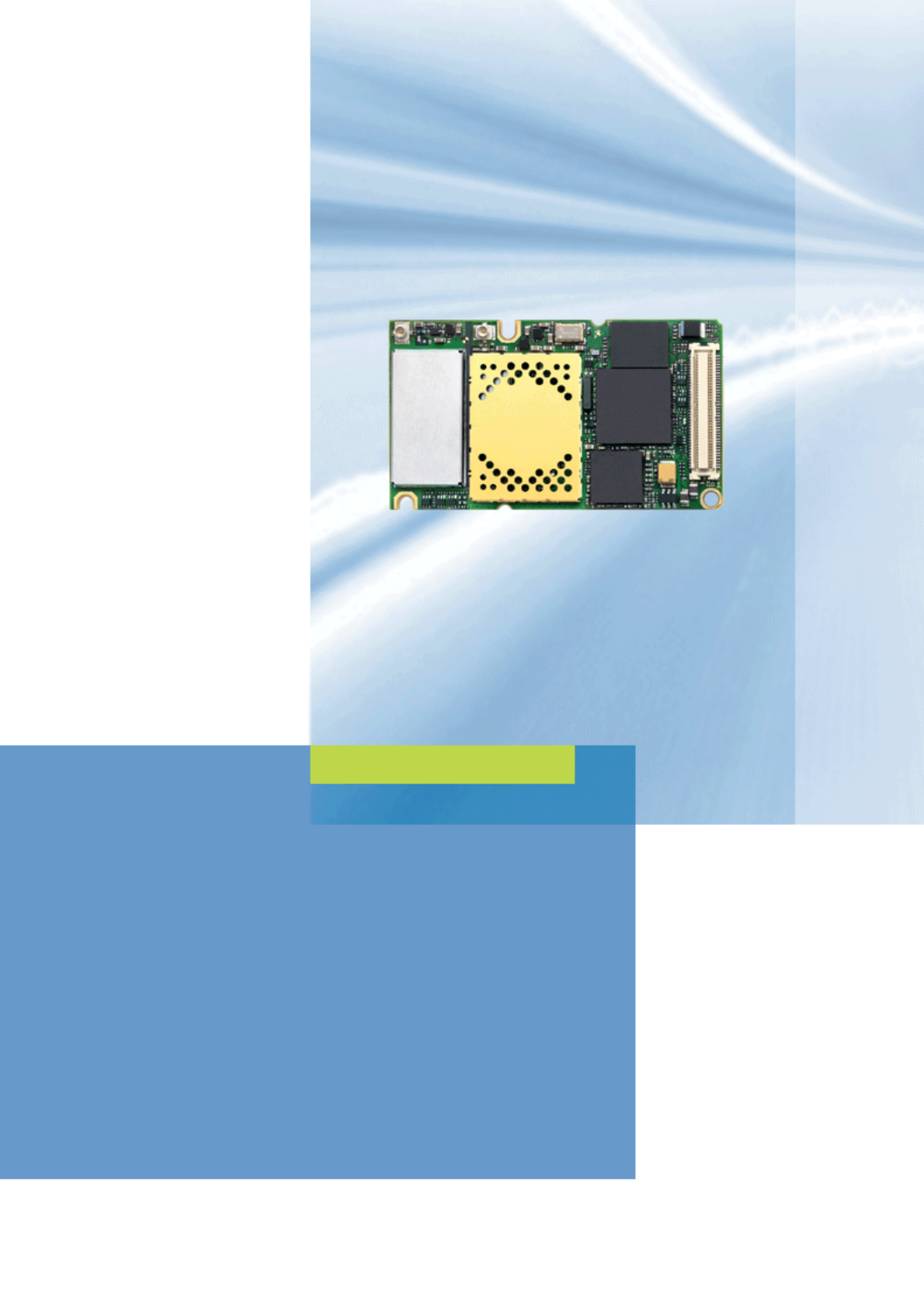
s
XT65/XT75
Siemens Cellular Engine
Version: 00.130
DocId: XT65_XT75_HO_v00.130
Supported Products: XT65, XT75
Hardware Interface Overview

XT65/XT75 Hardware Interface Overview
XT65_XT75_HO_v00.130 Page 2 of 58 2006-10-12
Confidential / Preliminary
s
General Notes
Product is deemed accepted by Recipient and is provided without interface to Recipient´s products. The Product
constitutes pre-release version and code and may be changed substantially before commercial release. The
Product is provided on an “as is” basis only and may contain deficiencies or inadequacies. The Product is pro-
vided without warranty of any kind, express or implied. To the maximum extent permitted by applicable law, Si-
emens further disclaims all warranties, including without limitation any implied warranties of merchantability,
fitness for a particular purpose and noninfringement of third-party rights. The entire risk arising out of the use or
performance of the Product and documentation remains with Recipient. This Product is not intended for use in
life support appliances, devices or systems where a malfunction of the product can reasonably be expected to
result in personal injury. Applications incorporating the described product must be designed to be in accordance
with the technical specifications provided in these guidelines. Failure to comply with any of the required proce-
dures can result in malfunctions or serious discrepancies in results. Furthermore, all safety instructions regarding
the use of mobile technical systems, including GSM products, which also apply to cellular phones must be fol-
lowed. Siemens AG customers using or selling this product for use in any applications do so at their own risk and
agree to fully indemnify Siemens for any damages resulting from illegal use or resale. To the maximum extent
permitted by applicable law, in no event shall Siemens or its suppliers be liable for any consequential, incidental,
direct, indirect, punitive or other damages whatsoever (including, without limitation, damages for loss of business
profits, business interruption, loss of business information or data, or other pecuniary loss) arising out the use of
or inability to use the Product, even if Siemens has been advised of the possibility of such damages. Subject to
change without notice at any time.
Copyright
Transmittal, reproduction, dissemination and/or editing of this document as well as utilization of its contents and
communication thereof to others without express authorization are prohibited. Offenders will be held liable for
payment of damages. All rights created by patent grant or registration of a utility model or design patent are re-
served.
Copyright © Siemens AG 2006
Document Name: XT65/XT75 Hardware Interface Overview
Version: 00.130
Date: 2006-10-12
DocId: XT65_XT75_HO_v00.130
Status Confidential / Preliminary
Supported Products: XT65, XT75

XT65/XT75 Hardware Interface Overview
Contents s
XT65_XT75_HO_v00.130 Page 3 of 58 2006-10-12
Confidential / Preliminary
Contents
1 Introduction.............................................................................................................................................. 6
1.1 Related Documents......................................................................................................................... 6
1.2 Terms and Abbreviations ................................................................................................................ 7
1.3 Regulatory and Type Approval Information................................................................................... 10
1.3.1 Directives and Standards............................................................................................... 10
1.3.2 SAR requirements specific to portable mobiles ............................................................. 11
1.3.3 SELV Requirements ...................................................................................................... 12
1.3.4 Safety Precautions.........................................................................................................12
2 Product Concept.................................................................................................................................... 14
2.1 Key Features at a Glance.............................................................................................................. 14
3 Application Interface ............................................................................................................................. 18
3.1 Operating Modes........................................................................................................................... 19
4 GSM Antenna Interface......................................................................................................................... 20
4.1 Antenna Installation....................................................................................................................... 20
4.2 Antenna Pad.................................................................................................................................. 21
4.2.1 Suitable Cable Types..................................................................................................... 22
4.3 Antenna Connector ....................................................................................................................... 23
5 GPS Antenna Interface.......................................................................................................................... 27
5.1 Antenna Installation....................................................................................................................... 27
5.2 GPS Antenna ................................................................................................................................ 28
6 Electrical, Reliability and Radio Characteristics ................................................................................ 29
6.1 Absolute Maximum Ratings........................................................................................................... 29
6.2 Operating Temperatures ............................................................................................................... 30
6.3 Storage Conditions........................................................................................................................ 31
6.4 Reliability Characteristics .............................................................................................................. 32
6.5 Pin Assignment and Signal Description ........................................................................................33
6.6 Power Supply Ratings ................................................................................................................... 43
7 Mechanics .............................................................................................................................................. 44
7.1 Mechanical Dimensions of XT65/XT75 ......................................................................................... 44
7.2 Mounting XT65/XT75 to the Application Platform ......................................................................... 46
7.3 Board-to-Board Application Connector.......................................................................................... 47
8 Reference Approval............................................................................................................................... 51
8.1 Reference Equipment for Type Approval ...................................................................................... 51
8.2 Compliance with FCC Rules and Regulations .............................................................................. 52
9 Appendix ................................................................................................................................................ 53
9.1 List of Parts and Accessories........................................................................................................ 53
9.2 Fasteners and Fixings for Electronic Equipment........................................................................... 55
9.2.1 Fasteners from German Supplier ETTINGER GmbH.................................................... 55

XT65/XT75 Hardware Interface Overview
List of Tables s
XT65_XT75_HO_v00.130 Page 4 of 58 2006-10-12
Confidential / Preliminary
Tables
Table 1: Directives .................................................................................................................................... 10
Table 2: Standards of North American type approval...............................................................................10
Table 3: Standards of European type approval ........................................................................................ 10
Table 4: Requirements of quality .............................................................................................................. 11
Table 5: Overview of operating modes ..................................................................................................... 19
Table 6: Return loss in the active band .................................................................................................... 20
Table 7: Product specifications of U.FL-R-SMT connector....................................................................... 23
Table 8: Material and finish of U.FL-R-SMT connector and recommended plugs.................................... 24
Table 9: Ordering information for Hirose U.FL Series .............................................................................. 26
Table 10: GPS antenna: Active versus Passive ......................................................................................... 28
Table 11: Absolute maximum ratings ......................................................................................................... 29
Table 12: Board temperature...................................................................................................................... 30
Table 13: Ambient temperature according to IEC 60068-2 (without forced air circulation) ........................ 30
Table 14: Charging temperature................................................................................................................. 30
Table 15: Storage conditions...................................................................................................................... 31
Table 16: Summary of reliability test conditions ......................................................................................... 32
Table 17: Signal description ....................................................................................................................... 34
Table 18: Power supply ratings .................................................................................................................. 43
Table 19: Technical specifications of Molex board-to-board connector...................................................... 47
Table 20: List of parts and accessories ...................................................................................................... 53
Table 21: Molex sales contacts (subject to change)................................................................................... 54
Table 22: Hirose sales contacts (subject to change) .................................................................................. 54

XT65/XT75 Hardware Interface Overview
List of Figures s
XT65_XT75_HO_v00.130 Page 5 of 58 2006-10-12
Confidential / Preliminary
Figures
Figure 1: GSM antenna connector placement ........................................................................................... 20
Figure 2: Figure 41: Restricted area around antenna pad ......................................................................... 21
Figure 3: GSM antenna pad placement ..................................................................................................... 22
Figure 4: Mechanical dimensions of U.FL-R-SMT connector .................................................................... 23
Figure 5: U.FL-R-SMT connector with U.FL-LP-040 plug.......................................................................... 24
Figure 6: U.FL-R-SMT connector with U.FL-LP-066 plug.......................................................................... 24
Figure 7: Specifications of U.FL-LP-(V)-040(01) plug................................................................................ 25
Figure 8: GPS antenna connector placement............................................................................................ 27
Figure 9: GPS antenna pad placement...................................................................................................... 27
Figure 10: Pin assignment (component side of XT65/XT75) ....................................................................... 33
Figure 11: XT65/XT75– top view ................................................................................................................. 44
Figure 12: Dimensions of XT65/XT75 (all dimensions in mm)..................................................................... 45
Figure 13: Mating board-to-board connector 53748-0808 on application .................................................... 48
Figure 14: Molex board-to-board connector 52991-0808 on XT65/XT75 .................................................... 49
Figure 15: Mating board-to-board connector 53748-0808 on application .................................................... 50
Figure 16: Reference equipment for Type Approval .................................................................................... 51

XT65/XT75 Hardware Interface Overview
1 Introduction s
XT65_XT75_HO_v00.130 Page 6 of 67 2006-10-12
Confidential / Preliminary
1 Introduction
This document applies to the following Siemens products:
• XT65 Module
• XT75 Module
The document describes the hardware of the XT65 and XT75 modules, both designed to connect to a cellular
device application and the air interface. It helps you quickly retrieve interface specifications, electrical and
mechanical details and information on the requirements to be considered for integrating further components.
The difference between both modules is that the XT75 additionally features EGPRS. Please note that except for
EGPRS specific statements, all information provided below applies to both module types.
Throughout the document, both modules are generally referred to as XT65/XT75.
1.1 Related Documents
[1] XT65 AT Command Set 00.130
XT75 AT Command Set 00.130
[2] XT65/XT75 Release Notes 00.130
[3] DSB75 Support Box - Evaluation Kit for Siemens Cellular Engines
[4] Application Note 02: Audio Interface Design for GSM Applications
[5] Application Note 07: Rechargeable Lithium Batteries in GSM Applications
[6] Application Note 16: Upgrading Firmware
[7] Application Note 17: Over-The-Air Firmware Update
[8] Application Note 22: Using TTY / CTM Equipment
[9] Application Note 24: Application Developer’s Guide
[10] Application Note 26: Power Supply Design for GSM Applications
[11] Application Note 32: Integrating USB into GSM Applications
[12] Multiplexer User's Guide
[13] Multiplex Driver Developer’s Guide for Windows 2000 and Windows XP
[14] Multiplex Driver Installation Guide for Windows 2000 and Windows XP
[15] Remote SAT User's Guide
[16] Java User’s Guide
[17] Java doc \wtk\doc\html\index.html
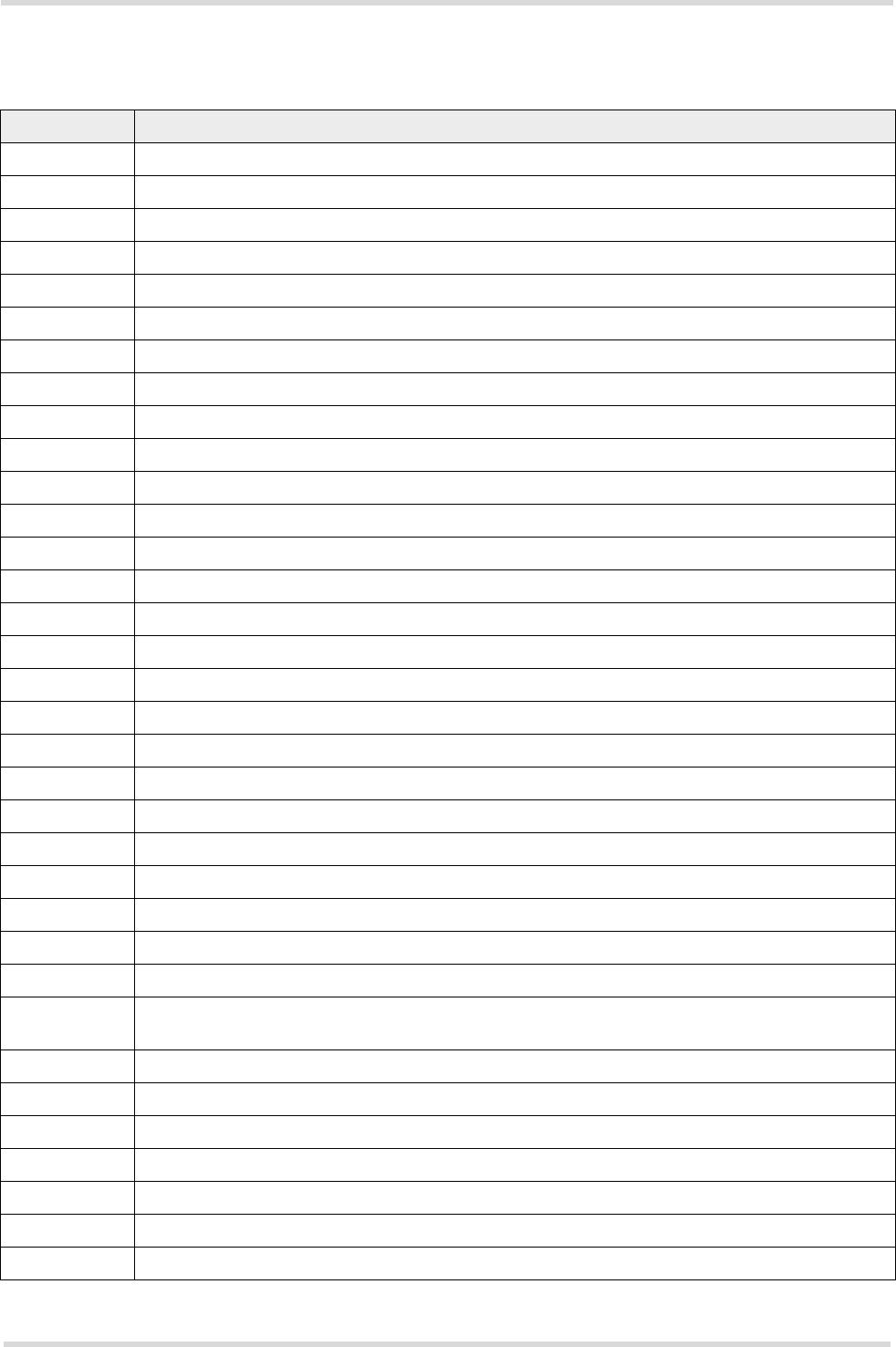
XT65/XT75 Hardware Interface Overview
1.2 Terms and Abbreviations s
XT65_XT75_HO_v00.130 Page 7 of 67 2006-10-12
Confidential / Preliminary
1.2 Terms and Abbreviations
Abbreviation Description
ADC Analog-to-Digital Converter
AGC Automatic Gain Control
ANSI American National Standards Institute
ARFCN Absolute Radio Frequency Channel Number
ARP Antenna Reference Point
ASC0 Asynchronous Controller. Abbreviations used for the serial interface of XT65/XT75
B Thermistor Constant
B2B Board-to-board connector
BER Bit Error Rate
BTS Base Transceiver Station
CB or CBM Cell Broadcast Message
CE Conformité Européene (European Conformity)
CHAP Challenge Handshake Authentication Protocol
CPU Central Processing Unit
CS Coding Scheme
CSD Circuit Switched Data
CTS Clear to Send
DAC Digital-to-Analog Converter
DAI Digital Audio Interface
dBm0 Digital level, 3.14dBm0 corresponds to full scale, see ITU G.711, A-law
DCE Data Communication Equipment (typically modems, e.g. Siemens GSM engine)
DCS 1800 Digital Cellular System, also referred to as PCN
DRX Discontinuous Reception
DSB Development Support Box
DSP Digital Signal Processor
DSR Data Set Ready
DTE Data Terminal Equipment (typically computer, terminal, printer or, for example, GSM applica-
tion)
DTR Data Terminal Ready
DTX Discontinuous Transmission
EFR Enhanced Full Rate
EGSM Enhanced GSM
EIRP Equivalent Isotropic Radiated Power
EMC Electromagnetic Compatibility
ERP Effective Radiated Power
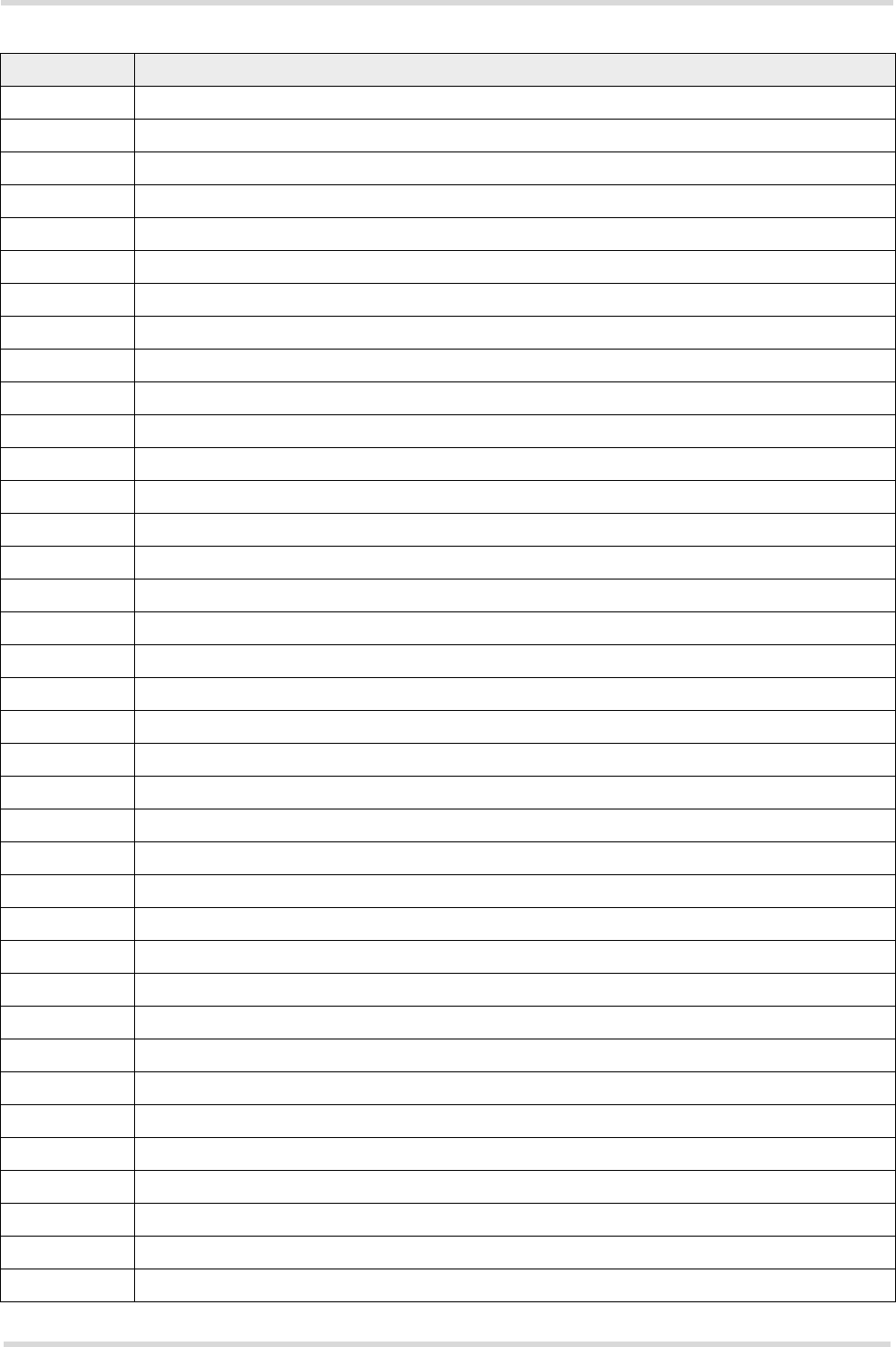
XT65/XT75 Hardware Interface Overview
1.2 Terms and Abbreviations s
XT65_XT75_HO_v00.130 Page 8 of 67 2006-10-12
Confidential / Preliminary
ESD Electrostatic Discharge
ETS European Telecommunication Standard
FCC Federal Communications Commission (U.S.)
FDMA Frequency Division Multiple Access
FR Full Rate
GMSK Gaussian Minimum Shift Keying
GPIO General Purpose Input/Output
GPRS General Packet Radio Service
GSM Global Standard for Mobile Communications
HiZ High Impedance
HR Half Rate
I/O Input/Output
IC Integrated Circuit
IMEI International Mobile Equipment Identity
ISO International Standards Organization
ITU International Telecommunications Union
kbps kbits per second
LED Light Emitting Diode
Li-Ion / Li+ Lithium-Ion
Li battery Rechargeable Lithium Ion or Lithium Polymer battery
Mbps Mbits per second
MMI Man Machine Interface
MO Mobile Originated
MS Mobile Station (GSM engine), also referred to as TE
MSISDN Mobile Station International ISDN number
MT Mobile Terminated
NTC Negative Temperature Coefficient
OEM Original Equipment Manufacturer
PA Power Amplifier
PAP Password Authentication Protocol
PBCCH Packet Switched Broadcast Control Channel
PCB Printed Circuit Board
PCL Power Control Level
PCM Pulse Code Modulation
PCN Personal Communications Network, also referred to as DCS 1800
PCS Personal Communication System, also referred to as GSM 1900
PDU Protocol Data Unit
Abbreviation Description
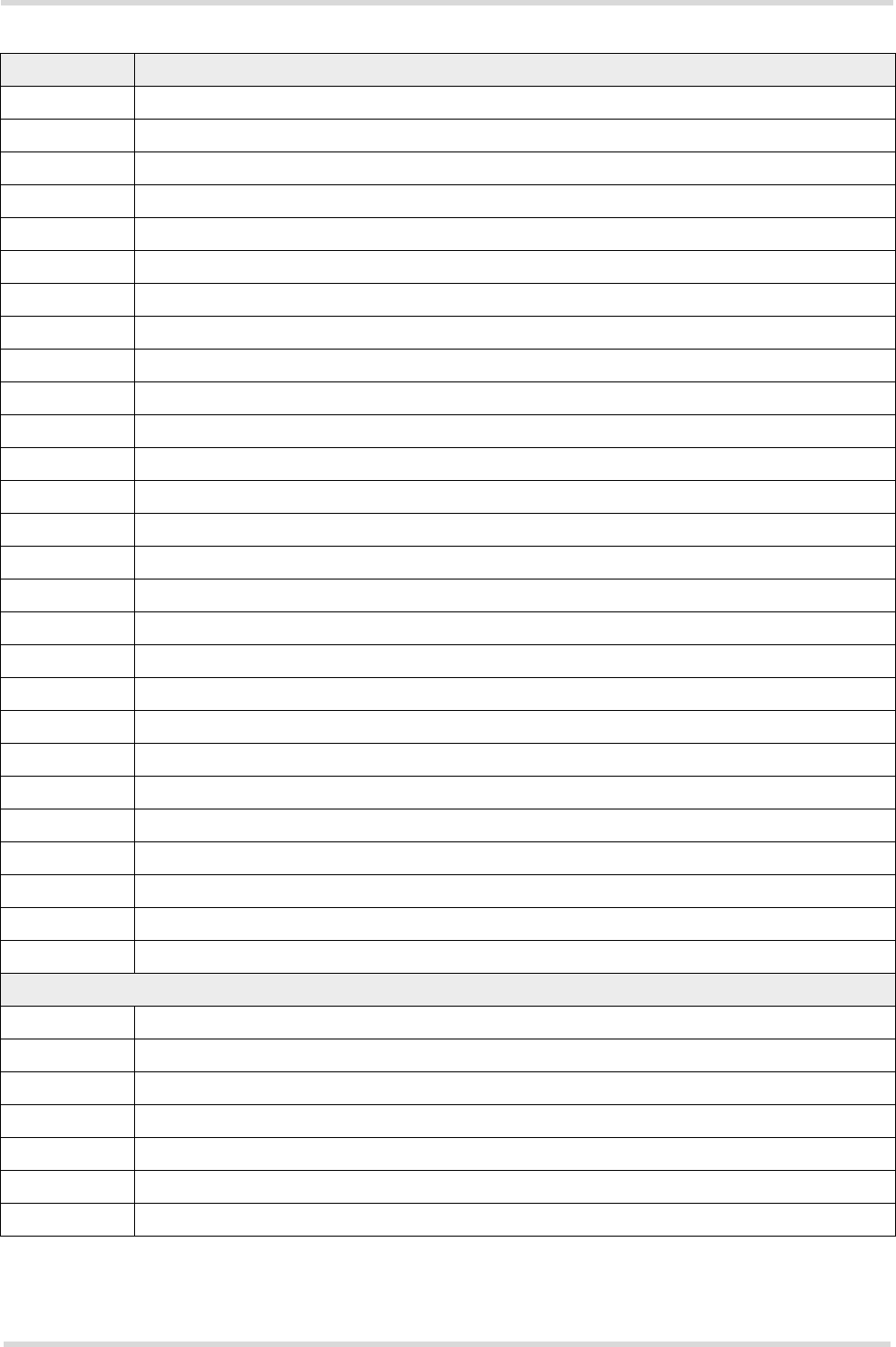
XT65/XT75 Hardware Interface Overview
1.2 Terms and Abbreviations s
XT65_XT75_HO_v00.130 Page 9 of 67 2006-10-12
Confidential / Preliminary
PLL Phase Locked Loop
PPP Point-to-point protocol
PSK Phase Shift Keying
PSU Power Supply Unit
R&TTE Radio and Telecommunication Terminal Equipment
RAM Random Access Memory
RF Radio Frequency
RMS Root Mean Square (value)
ROM Read-only Memory
RTC Real Time Clock
RTS Request to Send
Rx Receive Direction
SAR Specific Absorption Rate
SELV Safety Extra Low Voltage
SIM Subscriber Identification Module
SMS Short Message Service
SPI Serial Peripheral Interface
SRAM Static Random Access Memory
TA Terminal adapter (e.g. GSM engine)
TDMA Time Division Multiple Access
TE Terminal Equipment, also referred to as DTE
Tx Transmit Direction
UART Universal asynchronous receiver-transmitter
URC Unsolicited Result Code
USB Universal Serial Bus
USSD Unstructured Supplementary Service Data
VSWR Voltage Standing Wave Ratio
Phonebook abbreviations
FD SIM fixdialing phonebook
LD SIM last dialing phonebook (list of numbers most recently dialed)
MC Mobile Equipment list of unanswered MT calls (missed calls)
ME Mobile Equipment phonebook
ON Own numbers (MSISDNs) stored on SIM or ME
RC Mobile Equipment list of received calls
SM SIM phonebook
Abbreviation Description
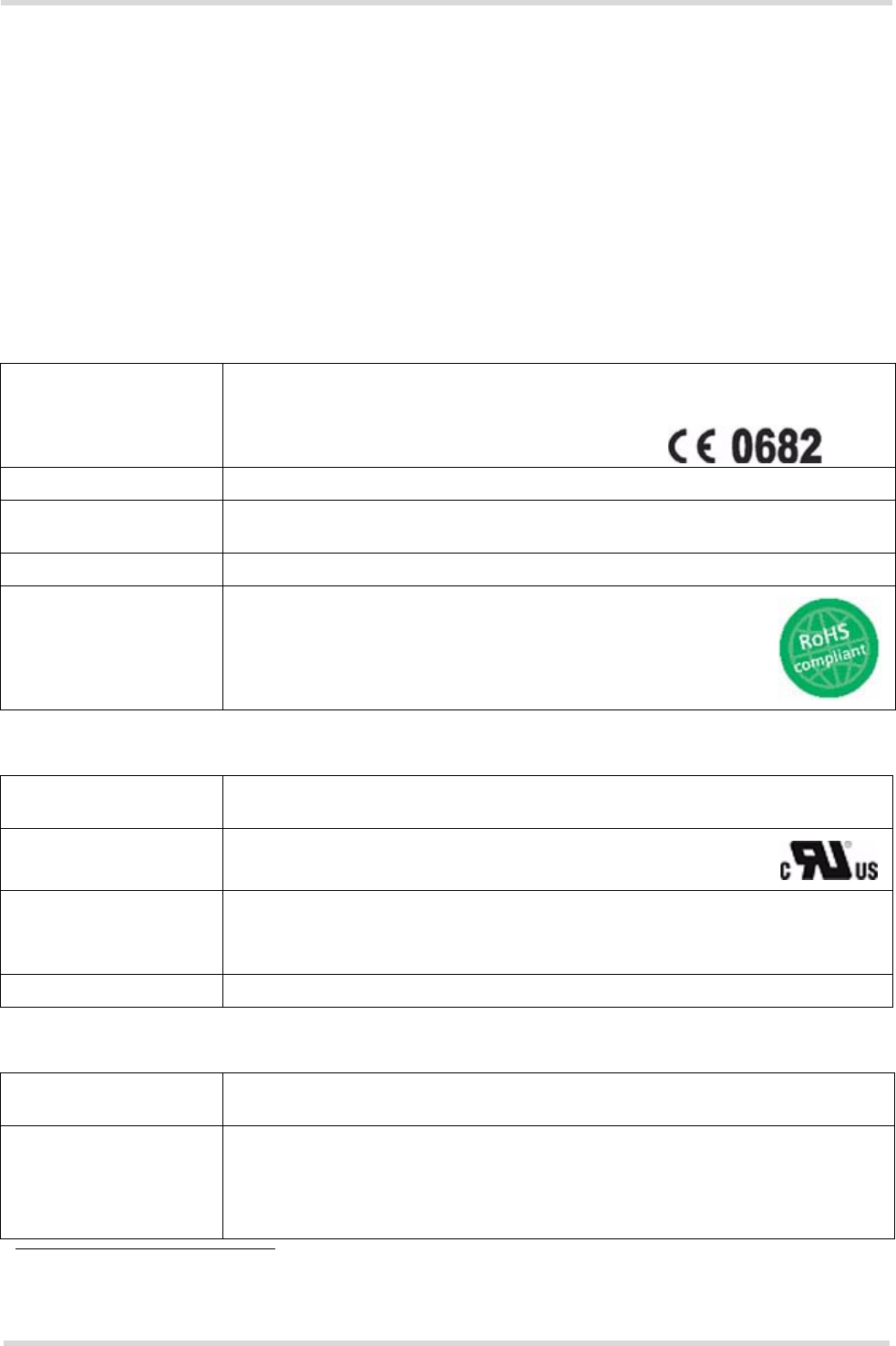
XT65/XT75 Hardware Interface Overview
1.3 Regulatory and Type Approval Information s
XT65_XT75_HO_v00.130 Page 10 of 67 2006-10-12
Confidential / Preliminary
1.3 Regulatory and Type Approval Information
1.3.1 Directives and Standards
XT65/XT75 is designed to comply with the directives and standards listed below. Please note that the product is
still in a pre-release state and, therefore, type approval and testing procedures have not yet been completed.
It is the responsibility of the application manufacturer to ensure compliance of the final product with all provisions
of the applicable directives and standards as well as with the technical specifications provided in the "XT65/XT75
Hardware Interface Description".1
1. Manufacturers of applications which can be used in the US shall ensure that their applications have a PTCRB
approval. For this purpose they can refer to the PTCRB approval of the respective module.
Table 1: Directives
99/05/EC Directive of the European Parliament and of the council of 9 March 1999 on radio
equipment and telecommunications terminal equipment and the mutual recognition
of their conformity (in short referred to as R&TTE Directive 1999/5/EC).
The product is labeled with the CE conformity mark
89/336/EC Directive on electromagnetic compatibility
73/23/EC Directive on electrical equipment designed for use within certain voltage limits (Low
Voltage Directive)
95/94/EC Automotive EMC directive
2002/95/EC Directive of the European Parliament and of the Council of 27 Jan-
uary 2003 on the restriction of the use of certain hazardous sub-
stances in electrical and electronic equipment (RoHS)
Table 2: Standards of North American type approval
CFR Title 47 Code of Federal Regulations, Part 22 and Part 24 (Telecommunications, PCS); US
Equipment Authorization FCC
UL 60 950 Product Safety Certification (Safety requirements)
NAPRD.03 V3.6.1 Overview of PCS Type certification review board Mobile Equipment Type Certifica-
tion and IMEI control
PCS Type Certification Review board (PTCRB)
RSS133 (Issue2) Canadian Standard
Table 3: Standards of European type approval
3GPP TS 51.010-1 Digital cellular telecommunications system (Phase 2); Mobile Station (MS) con-
formance specification
ETSI EN 301 511 V9.0.2 Candidate Harmonized European Standard (Telecommunications series) Global
System for Mobile communications (GSM); Harmonized standard for mobile sta-
tions in the GSM 900 and DCS 1800 bands covering essential requirements under
article 3.2 of the R&TTE directive (1999/5/EC) (GSM 13.11 version 7.0.1 Release
1998)

XT65/XT75 Hardware Interface Overview
1.3 Regulatory and Type Approval Information s
XT65_XT75_HO_v00.130 Page 11 of 67 2006-10-12
Confidential / Preliminary
1.3.2 SAR requirements specific to portable mobiles
Mobile phones, PDAs or other portable transmitters and receivers incorporating a GSM module must be in accor-
dance with the guidelines for human exposure to radio frequency energy. This requires the Specific Absorption
Rate (SAR) of portable XT65/XT75 based applications to be evaluated and approved for compliance with
national and/or international regulations.
Since the SAR value varies significantly with the individual product design manufacturers are advised to submit
their product for approval if designed for portable use. For European and US markets the relevant directives are
mentioned below. It is the responsibility of the manufacturer of the final product to verify whether or not further
standards, recommendations or directives are in force outside these areas.
Products intended for sale on US markets
ES 59005/ANSI C95.1 Considerations for evaluation of human exposure to Electromagnetic Fields (EMFs)
from Mobile Telecommunication Equipment (MTE) in the frequency range
30MHz - 6GHz
Products intended for sale on European markets
EN 50360 Product standard to demonstrate the compliance of mobile phones with the basic
restrictions related to human exposure to electromagnetic fields (300MHz - 3GHz)
IMPORTANT:
Manufacturers of portable applications based on XT65/XT75 modules are required to have their final product cer-
tified and apply for their own FCC Grant and Industry Canada Certificate related to the specific portable mobile.
See also Section 8.2.
GCF-CC V3.21.0 Global Certification Forum - Certification Criteria
ETSI EN 301 489-1
V1.4.1
Candidate Harmonized European Standard (Telecommunications series) Electro
Magnetic Compatibility and Radio spectrum Matters (ERM); Electro Magnetic
Compatibility (EMC) standard for radio equipment and services; Part 1: Common
Technical Requirements
ETSI EN 301 489-7
V1.2.1 (2000-09)
Candidate Harmonized European Standard (Telecommunications series) Electro
Magnetic Compatibility and Radio spectrum Matters (ERM); Electro Magnetic
Compatibility (EMC) standard for radio equipment and services; Part 7: Specific
conditions for mobile and portable radio and ancillary equipment of digital cellular
radio telecommunications systems (GSM and DCS)
IEC/EN 60950-1 (2001) Safety of information technology equipment (2000)
Table 4: Requirements of quality
IEC 60068 Environmental testing
DIN EN 60529 IP codes
Table 3: Standards of European type approval
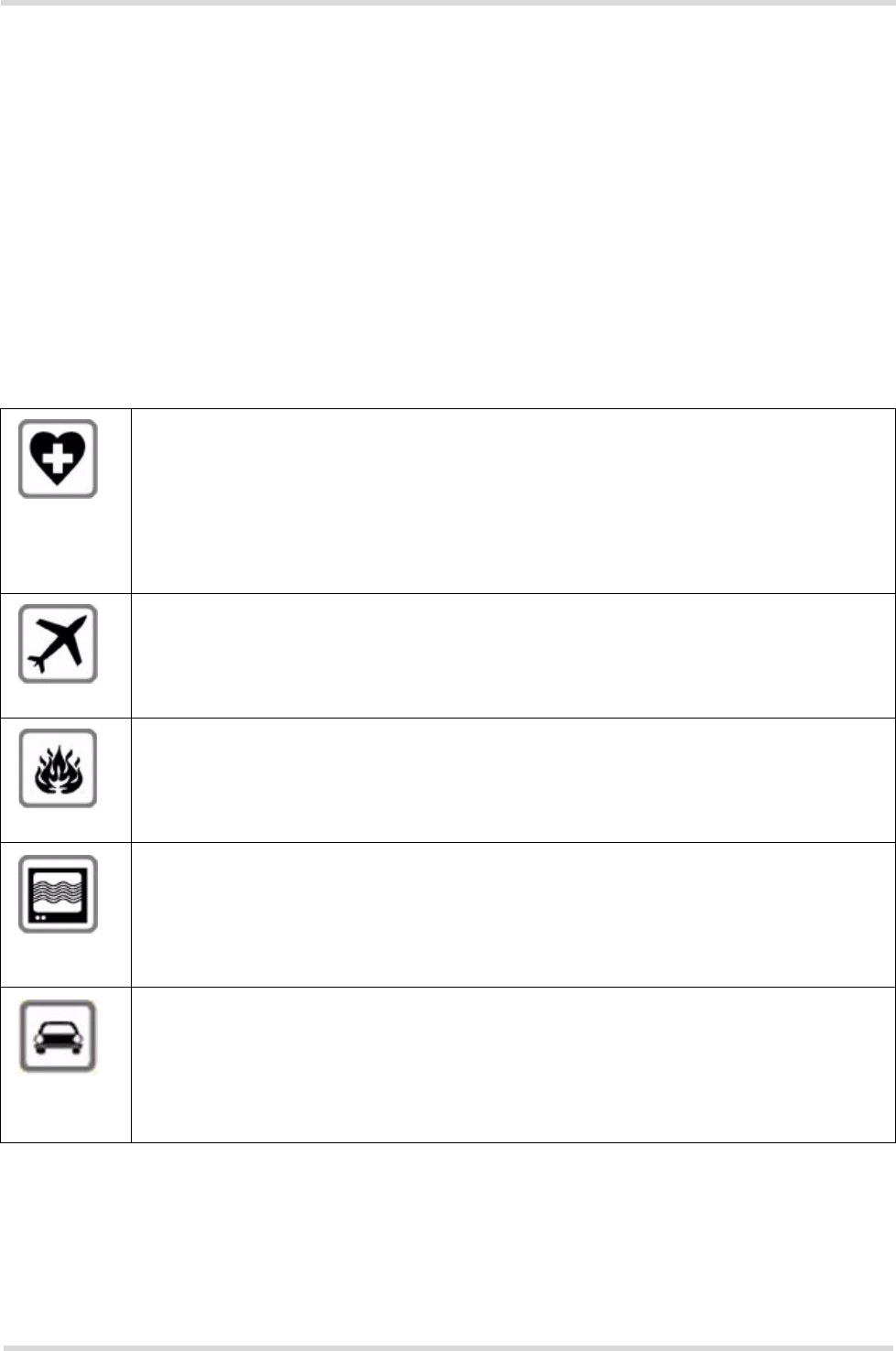
XT65/XT75 Hardware Interface Overview
1.3 Regulatory and Type Approval Information s
XT65_XT75_HO_v00.130 Page 12 of 67 2006-10-12
Confidential / Preliminary
1.3.3 SELV Requirements
The power supply connected to the XT65/XT75 module shall be in compliance with the SELV requirements
defined in EN 60950-1. See also Section 6.1 for further detail.
1.3.4 Safety Precautions
The following safety precautions must be observed during all phases of the operation, usage, service or repair
of any cellular terminal or mobile incorporating XT65/XT75. Manufacturers of the cellular terminal are advised to
convey the following safety information to users and operating personnel and to incorporate these guidelines into
all manuals supplied with the product. Failure to comply with these precautions violates safety standards of
design, manufacture and intended use of the product. Siemens AG assumes no liability for customer’s failure to
comply with these precautions.
When in a hospital or other health care facility, observe the restrictions on the use of mobiles.
Switch the cellular terminal or mobile off, if instructed to do so by the guidelines posted in sen-
sitive areas. Medical equipment may be sensitive to RF energy.
The operation of cardiac pacemakers, other implanted medical equipment and hearing aids
can be affected by interference from cellular terminals or mobiles placed close to the device.
If in doubt about potential danger, contact the physician or the manufacturer of the device to
verify that the equipment is properly shielded. Pacemaker patients are advised to keep their
hand-held mobile away from the pacemaker, while it is on.
Switch off the cellular terminal or mobile before boarding an aircraft. Make sure it cannot be
switched on inadvertently. The operation of wireless appliances in an aircraft is forbidden to
prevent interference with communications systems. Failure to observe these instructions may
lead to the suspension or denial of cellular services to the offender, legal action, or both.
Do not operate the cellular terminal or mobile in the presence of flammable gases or fumes.
Switch off the cellular terminal when you are near petrol stations, fuel depots, chemical plants
or where blasting operations are in progress. Operation of any electrical equipment in poten-
tially explosive atmospheres can constitute a safety hazard.
Your cellular terminal or mobile receives and transmits radio frequency energy while switched
on. Remember that interference can occur if it is used close to TV sets, radios, computers or
inadequately shielded equipment. Follow any special regulations and always switch off the
cellular terminal or mobile wherever forbidden, or when you suspect that it may cause interfer-
ence or danger.
Road safety comes first! Do not use a hand-held cellular terminal or mobile when driving a
vehicle, unless it is securely mounted in a holder for speakerphone operation. Before making
a call with a hand-held terminal or mobile, park the vehicle.
Speakerphones must be installed by qualified personnel. Faulty installation or operation can
constitute a safety hazard.

XT65/XT75 Hardware Interface Overview
1.3 Regulatory and Type Approval Information s
XT65_XT75_HO_v00.130 Page 13 of 67 2006-10-12
Confidential / Preliminary
IMPORTANT!
Cellular terminals or mobiles operate using radio signals and cellular networks. Because of
this, connection cannot be guaranteed at all times under all conditions. Therefore, you should
never rely solely upon any wireless device for essential communications, for example emer-
gency calls.
Remember, in order to make or receive calls, the cellular terminal or mobile must be switched
on and in a service area with adequate cellular signal strength.
Some networks do not allow for emergency calls if certain network services or phone features
are in use (e.g. lock functions, fixed dialing etc.). You may need to deactivate those features
before you can make an emergency call.
Some networks require that a valid SIM card be properly inserted in the cellular terminal or
mobile.
Bear in mind that exposure to excessive levels of noise can cause physical damage to users!
With regard to acoustic shock, the cellular application must be designed to avoid unintentional
increase of amplification, e.g. for a highly sensitive earpiece. A protection circuit should be
implemented in the cellular application.

XT65/XT75 Hardware Interface Overview
2 Product Concept s
XT65_XT75_HO_v00.130 Page 14 of 58 2006-10-12
Confidential / Preliminary
2 Product Concept
2.1 Key Features at a Glance
Feature Implementation
General
Frequency bands Quad band: GSM 850/900/1800/1900MHz
GSM class Small MS
Output power (according to
Release 99, V5)
Class 4 (+33dBm ±2dB) for EGSM850
Class 4 (+33dBm ±2dB) for EGSM900
Class 1 (+30dBm ±2dB) for GSM1800
Class 1 (+30dBm ±2dB) for GSM1900
XT75 only:
Class E2 (+27dBm ± 3dB) for GSM 850 8-PSK
Class E2 (+27dBm ± 3dB) for GSM 900 8-PSK
Class E2 (+26dBm +3 /-4dB) for GSM 1800 8-PSK
Class E2 (+26dBm +3 /-4dB) for GSM 1900 8-PSK
The values stated above are maximum limits. According to Release 99, the max-
imum output power in a multislot configuration may be lower. The nominal reduc-
tion of maximum output power varies with the number of uplink timeslots used
and amounts to 3.0dB for 2Tx, 4.8dB for 3Tx and 6.0dB for 4Tx.
Power supply 3.3V to 4.5V
Ambient operating
temperature according to
IEC 60068-2
Normal operation: -30°C to +65°C
Restricted operation:-30°C / +85°C
Physical Dimensions: 34mm x 59mm x 3.5mm
Weight: < 10g
RoHS All hardware components fully compliant with EU RoHS Directive
GSM / GPRS / EGPRS features
Data transfer GPRS:
Multislot Class 12
Full PBCCH support
Mobile Station Class B
Coding Scheme 1 – 4
EGPRS (XT75 only):
Multislot Class 10
Mobile Station Class B
Modulation and Coding Scheme MCS 1 – 9
CSD:
V.110, RLP, non-transparent
2.4, 4.8, 9.6, 14.4kbps
USSD
PPP-stack for GPRS data transfer

XT65/XT75 Hardware Interface Overview
2.1 Key Features at a Glance s
XT65_XT75_HO_v00.130 Page 15 of 58 2006-10-12
Confidential / Preliminary
SMS Point-to-point MT and MO
Cell broadcast
Text and PDU mode
Storage: SIM card plus 25 SMS locations in mobile equipment
Transmission of SMS alternatively over CSD or GPRS. Preferred mode can be
user defined.
Fax Group 3; Class 1
Audio Speech codecs:
Half rate HR (ETS 06.20)
Full rate FR (ETS 06.10)
Enhanced full rate EFR (ETS 06.50/06.60/06.80)
Adaptive Multi Rate AMR
Speakerphone operation, echo cancellation, noise suppression, DTMF, 7 ringing
tones
GPS Features
Supported Protocol NMEA-0183, RTCM v2.2, UBX binary protocol
GPS modes GPS, Assisted GPS (AGPS), Differential GSP (DGPS), Satellite Based Augmen-
tation Systems (SBAS)
Position accuracy 10-15m, with DGPS/SBAS 1-3m
Start-up times Hot start < 3.5s
Warm start 33s, average
Cold start 34s, average
Sensitivity Active antenna:
Aquisition sensitivity: -141dBm
Tracking sensitivity: -158dBm
At antenna connector:
Aquisition sensitivity: -139dBm
Tracking sensitivity: -156dBm
General Receiver 16 channel, L1 1575.42 MHz, GPS part controlled by GSM baseband
controller, Java engine or via application (ASC0)
Software
AT commands AT-Hayes GSM 07.05 and 07.07, Siemens
AT commands for RIL compatibility (NDIS/RIL)
MicrosoftTM compatibility RIL / NDIS for Pocket PC and Smartphone
Java platform
JDK Version: 1.4.2_09
Java Virtual Machine with APIs for AT Parser, Serial Interface, FlashFileSystem
and TCP/IP Stack.
Major benefits: seamless integration into Java applications, ease of program-
ming, no need for application microcontroller, extremely cost-efficient hardware
and software design – ideal platform for industrial GSM applications.
The memory space available for Java programs is around 1.2 MB in the flash file
system and around 400kB RAM. Application code and data share the space in
the flash file system and in RAM.
Feature Implementation

XT65/XT75 Hardware Interface Overview
2.1 Key Features at a Glance s
XT65_XT75_HO_v00.130 Page 16 of 58 2006-10-12
Confidential / Preliminary
SIM Application Toolkit SAT Release 99
TCP/IP stack Access by AT commands
IP addresses IP version 4
Remote SIM Access XT65/XT75 supports Remote SIM Access. RSA enables XT65/XT75 to use a
remote SIM card via its serial interface and an external application, in addition to
the SIM card locally attached to the dedicated lines of the application interface.
The connection between the external application and the remote SIM card can be
a Bluetooth wireless link or a serial link.
The necessary protocols and procedures are implemented according to the “SIM
Access Profile Interoperability Specification of the Bluetooth Special Interest
Group”.
Firmware update Generic update from host application over ASC0 or USB. Over-the-air (OTA)
firmware update is possible via SPI interface.
Interfaces
Serial interface (ASC0) - 8-wire modem interface with status and control lines, unbalanced,
asynchronous
- Fixed bit rates: 300 bps to 460,800 bps
- Autobauding: 1,200 bps to 460,800 bps
- RTS0/CTS0 and XON/XOFF flow control.
- Multiplex ability according to GSM 07.10 Multiplexer Protocol.
USB Supports a USB 2.0 Full Speed (12Mbit/s) slave interface.
I2CI2C bus for 7-bit addressing and transmission rates up to 400kbps. Programma-
ble with AT^SSPI command.
Alternatively, all pins of the I²C interface are configurable as SPI.
SPI Serial Peripheral Interface for transmission rates up to 6.5 Mbps.
Programmable with AT^SSPI command.
If the SPI is active the I²C interface is not available.
Audio 2 analog interfaces (2 microphone inputs and 2 headphone outputs with micro-
phone power supply)
1 digital interface (PCM)
SIM interface Supported SIM cards: 3V, 1.8V
Antenna • 50Ohms. External GSM antenna can be connected via antenna connector.
• 50Ohms. External GPS antenna can be connected via antenna connector.
Module interface 80-pin board-to-board connector
Power on/off, Reset
Power on/off Switch-on by hardware pin IGT
Switch-off by AT command (AT^SMSO)
Automatic switch-off in case of critical temperature and voltage conditions.
Reset Orderly shutdown and reset by AT command
Emergency reset by hardware pin EMERG_RST and IGT.
Feature Implementation

XT65/XT75 Hardware Interface Overview
2.1 Key Features at a Glance s
XT65_XT75_HO_v00.130 Page 17 of 58 2006-10-12
Confidential / Preliminary
Special features
Charging Supports management of rechargeable Lithium Ion and Lithium Polymer batter-
ies
Real time clock Timer functions via AT commands
GPIO 10 I/O pins of the application interface programmable as GPIO.
Programming is done via AT commands.
Alternatively, GPIO pin10 is configurable as pulse counter.
Pulse counter Pulse counter for measuring pulse rates from 0 to 1000 pulses per second.
If the pulse counter is active the GPIO10 pin is not available.
DAC output Digital-to-Analog Converter which can provide a PWM signal.
Phonebook SIM and phone
Evaluation kit
DSB75 DSB75 Evaluation Board designed to test and type approve Siemens cellular
engines and provide a sample configuration for application engineering.
Feature Implementation

XT65/XT75 Hardware Interface Overview
3 Application Interface s
XT65_XT75_HO_v00.130 Page 18 of 67 2006-10-12
Confidential / Preliminary
3 Application Interface
XT65/XT75 is equipped with an 80-pin board-to-board connector that connects to the external application and
incorporates several sub-interfaces: power supply, charger interface, SIM interface, serial interface ASC0, serial
interface USB, serial interface I²C/SPI, two analog audio interfaces, digital audio interface (DAI), 10 lines GPIO
interface, as well as status and control lines: IGT, EMERG_RST, PWR_IND, SYNC (for details see Chapter 2
and Section 6.5).

XT65/XT75 Hardware Interface Overview
3.1 Operating Modes s
XT65_XT75_HO_v00.130 Page 19 of 67 2006-10-12
Confidential / Preliminary
3.1 Operating Modes
The table below briefly summarizes the various operating modes available for the module.
Table 5: Overview of operating modes
Normal operation GSM / GPRS SLEEP Various power save modes set with AT+CFUN command.
Software is active to minimum extent. If the module was regis-
tered to the GSM network in IDLE mode, it is registered and pag-
ing with the BTS in SLEEP mode, too. Power saving can be
chosen at different levels: The NON-CYCLIC SLEEP mode
(AT+CFUN=0) disables the AT interface. The CYCLIC SLEEP
modes AT+CFUN=7 and 9 alternatingly activate and deactivate
the AT interfaces to allow permanent access to all AT com-
mands.
GSM IDLE Software is active. Once registered to the GSM network, paging
with BTS is carried out. The module is ready to send and receive.
GSM TALK Connection between two subscribers is in progress. Power con-
sumption depends on network coverage individual settings, such
as DTX off/on, FR/EFR/HR, hopping sequences, antenna.
GPRS IDLE
EGPRS IDLE
Module is ready for GPRS/EGPRS data transfer, but no data is
currently sent or received. Power consumption depends on net-
work settings and GPRS/EGPRS configuration (e.g. multislot
settings).
GPRS DATA
EGPRS DATA
GPRS/EGPRS data transfer in progress. Power consumption
depends on network settings (e.g. power control level), uplink /
downlink data rates, GPRS configuration (e.g. used multislot set-
tings) and reduction of maximum output power.
POWER DOWN Normal shutdown after sending the AT^SMSO command.
Only a voltage regulator is active for powering the RTC. Software is not active. Interfaces
are not accessible. Operating voltage (connected to BATT+) remains applied.
Airplane mode Airplane mode shuts down the radio part of the module, causes the module to log off from
the GSM/GPRS network and disables all AT commands whose execution requires a radio
connection.
Airplane mode can be controlled by using the AT commands AT^SCFG and AT+CALA:
• With AT^SCFG=MEopMode/Airplane/OnStart the module can be configured to enter
the Airplane mode each time when switched on or reset.
• The parameter AT^SCFG=MEopMode/Airplane can be used to switch back and forth
between Normal mode and Airplane mode any time during operation.
• Setting an alarm time with AT+CALA followed by AT^SMSO wakes the module up into
Airplane mode at the scheduled time.
Charge-only mode Limited operation for battery powered applications. Enables charging while module is
detached from GSM network. Limited number of AT commands is accessible. Charge-
only mode applies when the charger is connected if the module was powered down with
AT^SMSO.
Charge mode dur-
ing normal opera-
tion
Normal operation (SLEEP, IDLE, TALK, GPRS/EGPRS IDLE, GPRS/EGPRS DATA) and
charging running in parallel. Charge mode changes to Charge-only mode when the mod-
ule is powered down before charging has been completed.
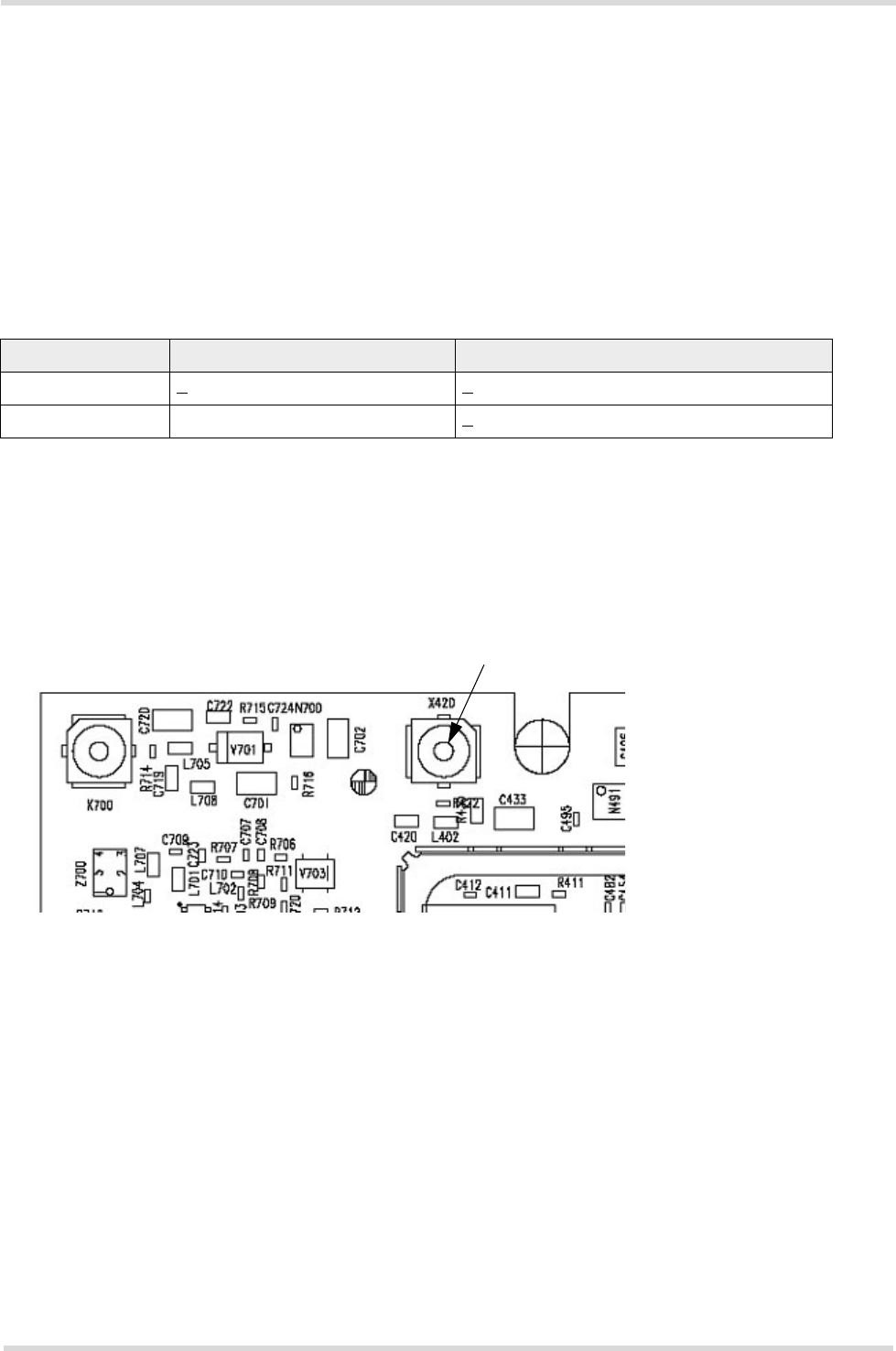
XT65/XT75 Hardware Interface Overview
4 GSM Antenna Interface s
XT65_XT75_HO_v00.130 Page 20 of 67 2006-10-12
Confidential / Preliminary
4 GSM Antenna Interface
The GSM interface has an impedance of 50Ω. XT65/XT75 is capable of sustaining a total mismatch at the
antenna connector without any damage, even when transmitting at maximum RF power. DC electric strength is
given (see Table 11).
The external antenna must be matched properly to achieve best performance regarding radiated power, DC-
power consumption, modulation accuracy and harmonic suppression. Antenna matching networks are not
included on the XT65/XT75 PCB and should be placed in the host application.
Regarding the return loss XT65/XT75 provides the following values in the active band:
4.1 Antenna Installation
To suit the physical design of individual applications XT65/XT75 offers two alternative approaches to connecting
the antenna:
• Recommended approach: U.FL-R-SMT antenna connector from Hirose assembled on the component side of
the PCB.
Figure 1: GSM antenna connector placement
See Section 4.3 for connector details.
• Antenna pad and grounding plane placed on the bottom side. See Section 4.2.
The U.FL-R-SMT connector has been chosen as antenna reference point (ARP) for the Siemens reference
equipment submitted to type approve XT65/XT75. All RF data specified throughout this manual are related to the
ARP. For compliance with the test results of the Siemens type approval you are advised to give priority to the
connector, rather than using the antenna pad.
IMPORTANT: Both solutions can only be applied alternatively. This means, whenever an antenna is plugged to
the Hirose connector, the pad must not be used. Vice versa, if the antenna is connected to the pad, then the
Hirose connector must be left empty.
Table 6: Return loss in the active band
State of module Return loss of module Recommended return loss of application
Receive > 8dB > 12dB
Transmit not applicable > 12dB
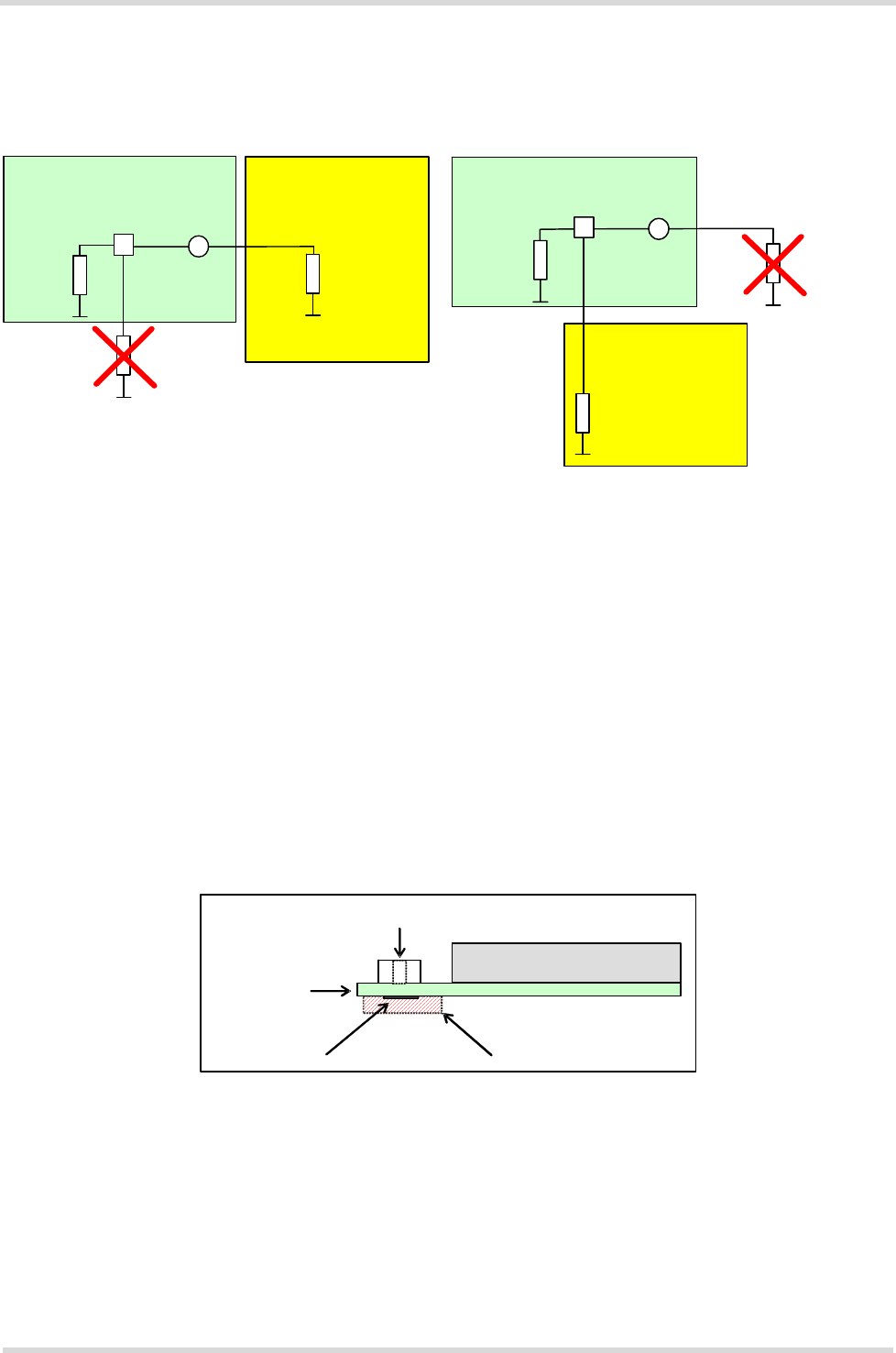
XT65/XT75 Hardware Interface Overview
4.2 Antenna Pad s
XT65_XT75_HO_v00.130 Page 21 of 67 2006-10-12
Confidential / Preliminary
Figure 40: Never use antenna connector and antenna pad at the same time
4.2 Antenna Pad
The antenna can be soldered to the pad, or attached via contact springs. For proper grounding connect the
antenna to the ground plane on the bottom of XT65/XT75 which must be connected to the ground plane of the
application.
If you decide to use the antenna pad take into account that the pad has not been intended as antenna reference
point (ARP) for the Siemens XT65/XT75 type approval. The antenna pad is provided only as an alternative option
which can be used, for example, if the recommended Hirose connection does not fit into your antenna design.
Please ensure that the antenna pad does not come into contact with the holding device or any other components
of the host application. It needs to be surrounded by a restricted area filled with air, which must also be reserved
0.8mm in height.
Figure 2: Figure 41: Restricted area around antenna pad
Antenna connected to Hirose connector: Antenna connected to pad:
Module Antenna or
Measurement
Equipment
50Ohm 50Ohm
U.FL
Z
PAD
Module
Antenna
50Ohm
50Ohm
U.FL
PAD
Z
PCB
U.FL antenna connector
RF section
Antenna pad
Restricted area

XT65/XT75 Hardware Interface Overview
4.2 Antenna Pad s
XT65_XT75_HO_v00.130 Page 22 of 67 2006-10-12
Confidential / Preliminary
Also, consider that according to the GSM recommendations TS 45.005 and TS 51.010-01 a 50Ω connector is
mandatory for type approval measurements. This requires GSM devices with an integral antenna to be tempo-
rarily equipped with a suitable connector or a low loss RF cable with adapter.
Figure 3: GSM antenna pad placement
Notes on soldering:
• To prevent damage to the module and to obtain long-term solder joint properties you are advised to maintain
the standards of good engineering practice for soldering.
• Be sure to solder the antenna core to the pad and the shielding of the coax cable to the ground plane of the
module next to the antenna pad. The direction of the cable is not relevant from the electrical point of view.
XT65/XT75 material properties:
XT65/XT75 PCB: FR4
Antenna pad: Gold plated pad
4.2.1 Suitable Cable Types
For direct solder attachment, we suggest to use the following cable types:
• RG316/U 50Ohm coaxial cable
• 1671A 50Ohm coaxial cable
Suitable cables are offered, for example, by IMS Connector Systems. For further details and other cable types
please contact http://www.imscs.com.
Please note that the GSM antenna must be isolated for ESD and SAR protection (to withstand a voltage resis-
tance up to 8kV air discharge).
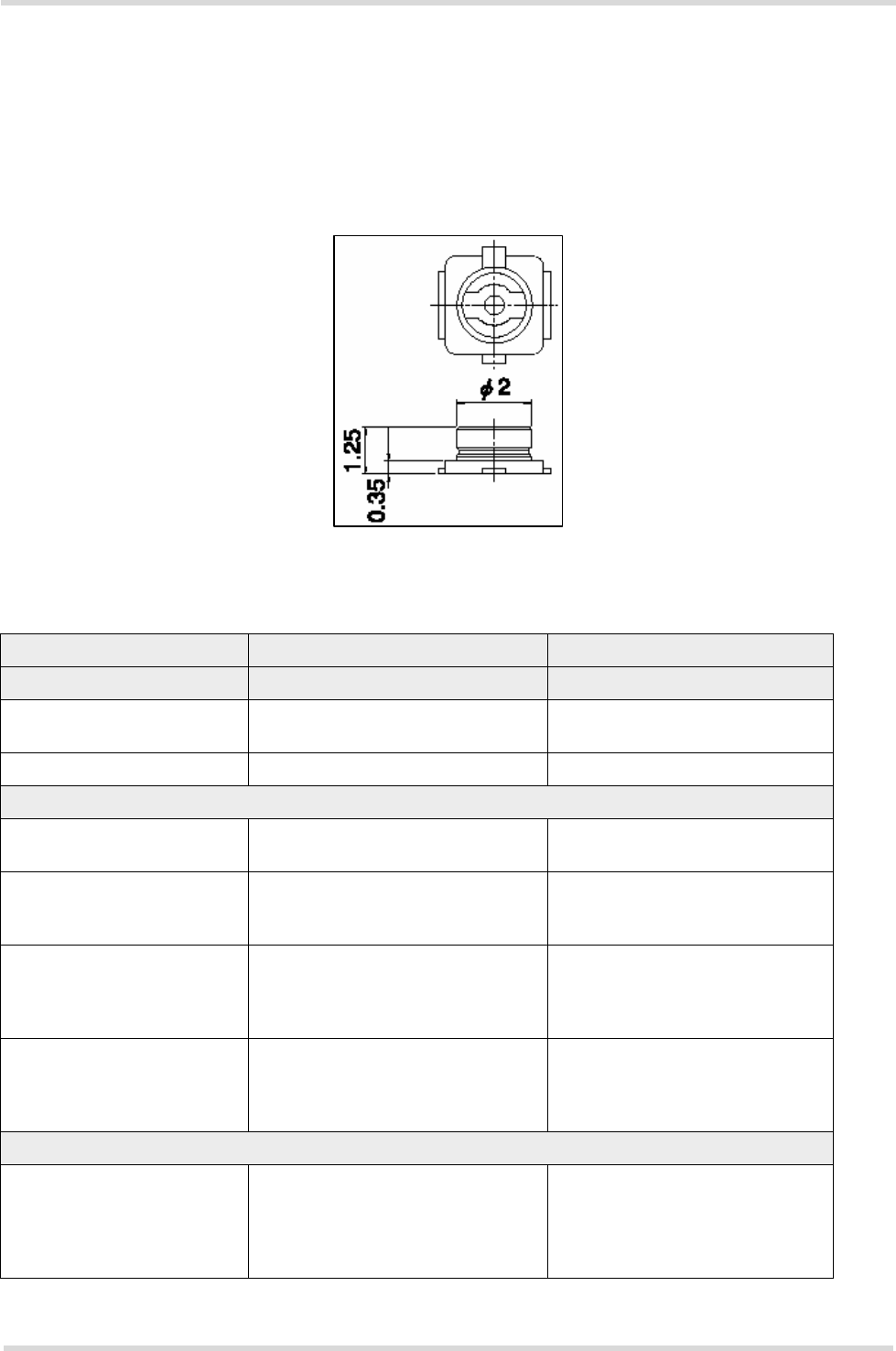
XT65/XT75 Hardware Interface Overview
4.3 Antenna Connector s
XT65_XT75_HO_v00.130 Page 23 of 67 2006-10-12
Confidential / Preliminary
4.3 Antenna Connector
For GSM and GPS, XT65/XT75 uses an ultra-miniature SMT antenna connector supplied from Hirose Ltd. The
product name is:
•U.FL-R-SMT
The position of the antenna connector on the XT65/XT75 board can be seen in Section 4.1.
Figure 4: Mechanical dimensions of U.FL-R-SMT connector
Table 7: Product specifications of U.FL-R-SMT connector
Item Specification Conditions
Ratings
Nominal impedance 50ΩOperating temp:-40°C to + 90°C
Operating humidity: max. 90%
Rated frequency DC to 3GHz
Mechanical characteristics
Female contact holding force 0.15N min Measured with a ; 0.475 pin
gauge
Repetitive operation Contact resistance:
Center 25mΩ
Outside 15mΩ
30 cycles of insertion and disen-
gagement
Vibration No momentary disconnections of
1µs;
No damage, cracks and looseness
of parts
Frequency of 10 to 100Hz, single
amplitude of 1.5mm, acceleration
of 59m/s2, for 5 cycles in the
direction of each of the 3 axes
Shock No momentary disconnections of
1µs.
No damage, cracks and looseness
of parts.
Acceleration of 735m/s2, 11ms
duration for 6 cycles in the direc-
tion of each of the 3 axes
Environmental characteristics
Humidity resistance No damage, cracks and looseness
of parts.
Insulation resistance:
100MΩ min. at high humidity
500MΩ min. when dry
Exposure to 40°C, humidity of
95% for a total of 96 hours
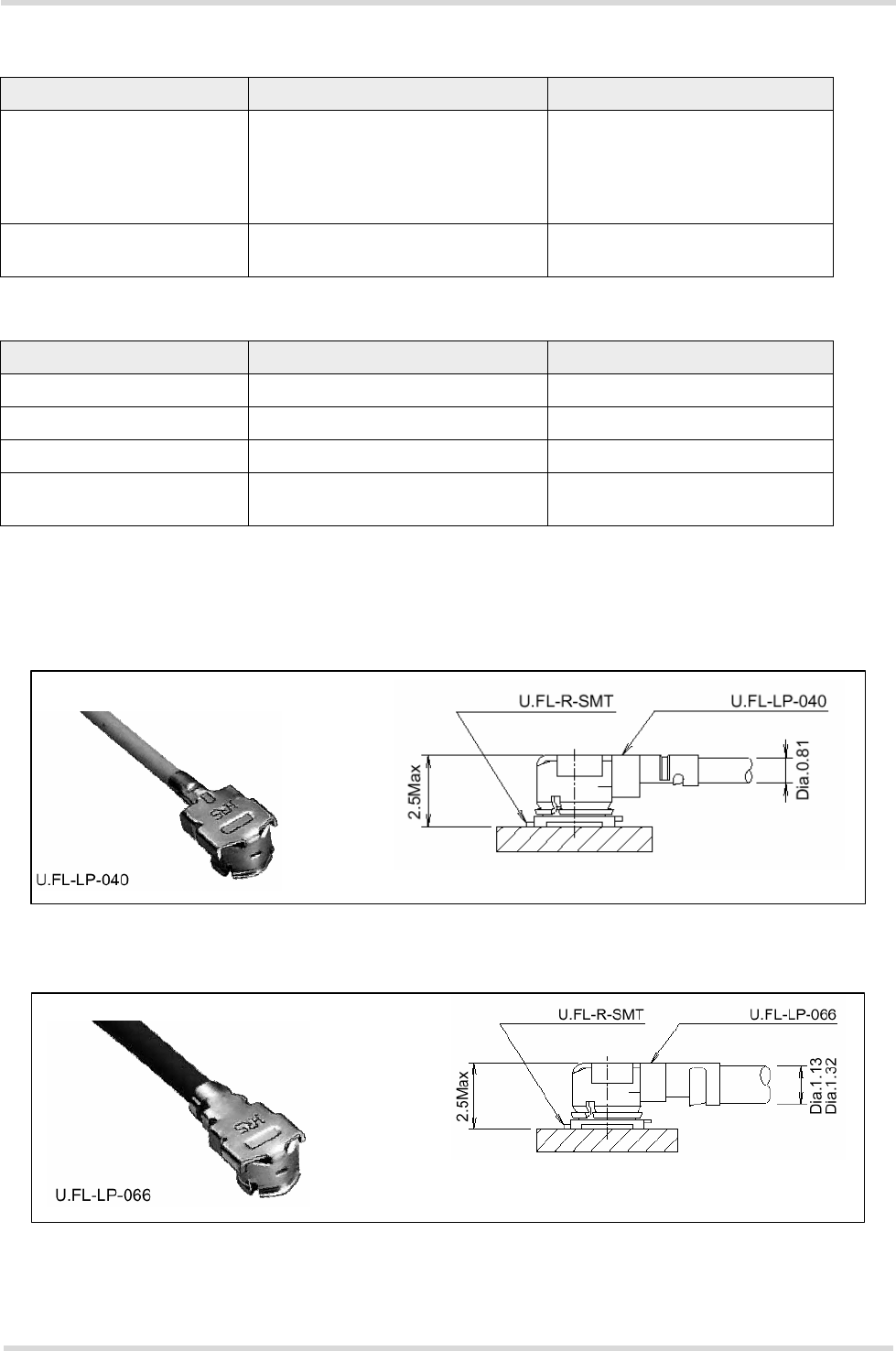
XT65/XT75 Hardware Interface Overview
4.3 Antenna Connector s
XT65_XT75_HO_v00.130 Page 24 of 67 2006-10-12
Confidential / Preliminary
Mating plugs and cables can be chosen from the Hirose U.FL Series. Examples are shown below and listed in
Table 19. For latest product information please contact your Hirose dealer or visit the Hirose home page, for
example http://www.hirose.com.
Figure 5: U.FL-R-SMT connector with U.FL-LP-040 plug
Figure 6: U.FL-R-SMT connector with U.FL-LP-066 plug
Temperature cycle No damage, cracks and looseness
of parts.
Contact resistance:
Center 25mΩ
Outside 15mΩ
Temperature: +40°C → 5 to 35°C
→ +90°C → 5 to 35°C
Time: 30min → within 5min →
30min within 5min
Salt spray test No excessive corrosion 48 hours continuous exposure to
5% salt water
Table 8: Material and finish of U.FL-R-SMT connector and recommended plugs
Part Material Finish
Shell Phosphor bronze Silver plating
Male center contact Brass Gold plating
Female center contact Phosphor bronze Gold plating
Insulator Plug: PBT
Receptacle: LCP
Black
Beige
Table 7: Product specifications of U.FL-R-SMT connector
Item Specification Conditions
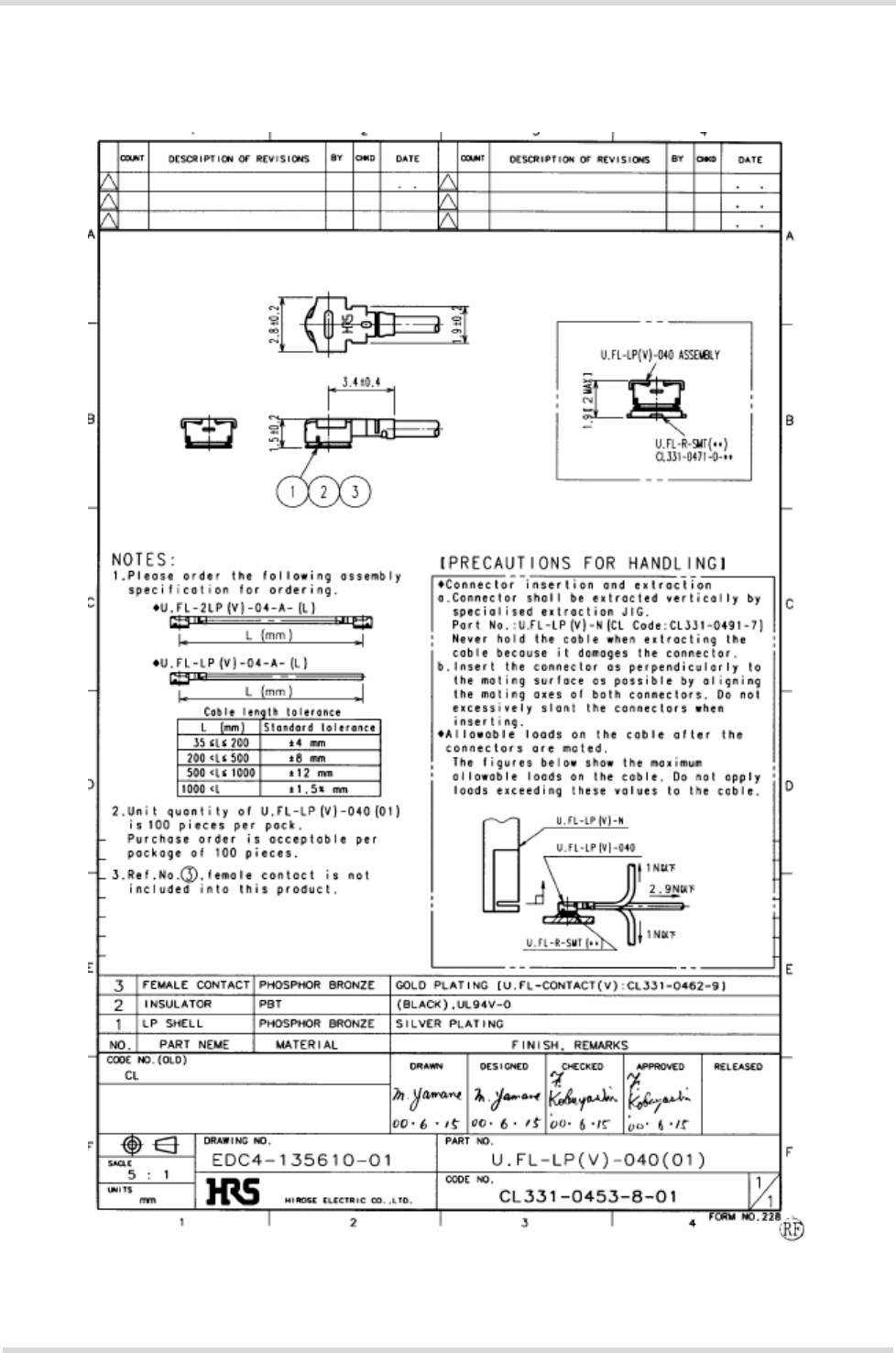
XT65/XT75 Hardware Interface Overview
4.3 Antenna Connector s
XT65_XT75_HO_v00.130 Page 25 of 67 2006-10-12
Confidential / Preliminary
In addition to the connectors illustrated above, the U.FL-LP-(V)-040(01) version is offered as an extremely space
saving solution. This plug is intended for use with extra fine cable (up to ;0.81mm) and minimizes the mating
height to 2mm. See Figure 46 which shows the Hirose datasheet.
Figure 7: Specifications of U.FL-LP-(V)-040(01) plug
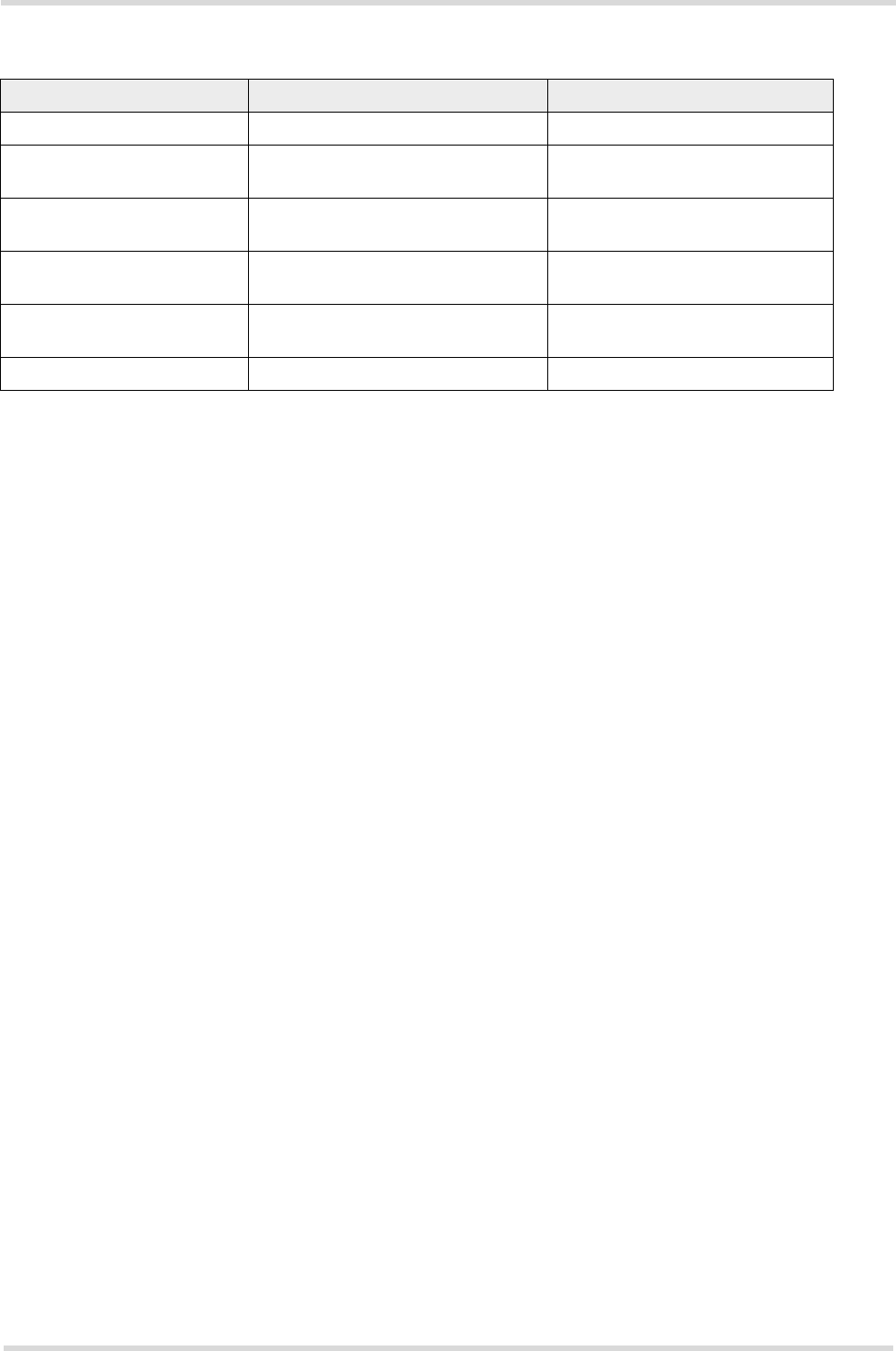
XT65/XT75 Hardware Interface Overview
4.3 Antenna Connector s
XT65_XT75_HO_v00.130 Page 26 of 67 2006-10-12
Confidential / Preliminary
Table 9: Ordering information for Hirose U.FL Series
Item Part number HRS number
Connector on XT65/XT75 U.FL-R-SMT CL331-0471-0-10
Right-angle plug shell for
;0.81mm cable
U.FL-LP-040 CL331-0451-2
Right-angle plug for
;0.81mm cable
U.FL-LP(V)-040 (01) CL331-053-8-01
Right-angle plug for
; 1.13mm cable
U.FL-LP-068 CL331-0452-5
Right-angle plug for
; 1.32mm cable
U.FL-LP-066 CL331-0452-5
Extraction jig E.FL-LP-N CL331-04441-9
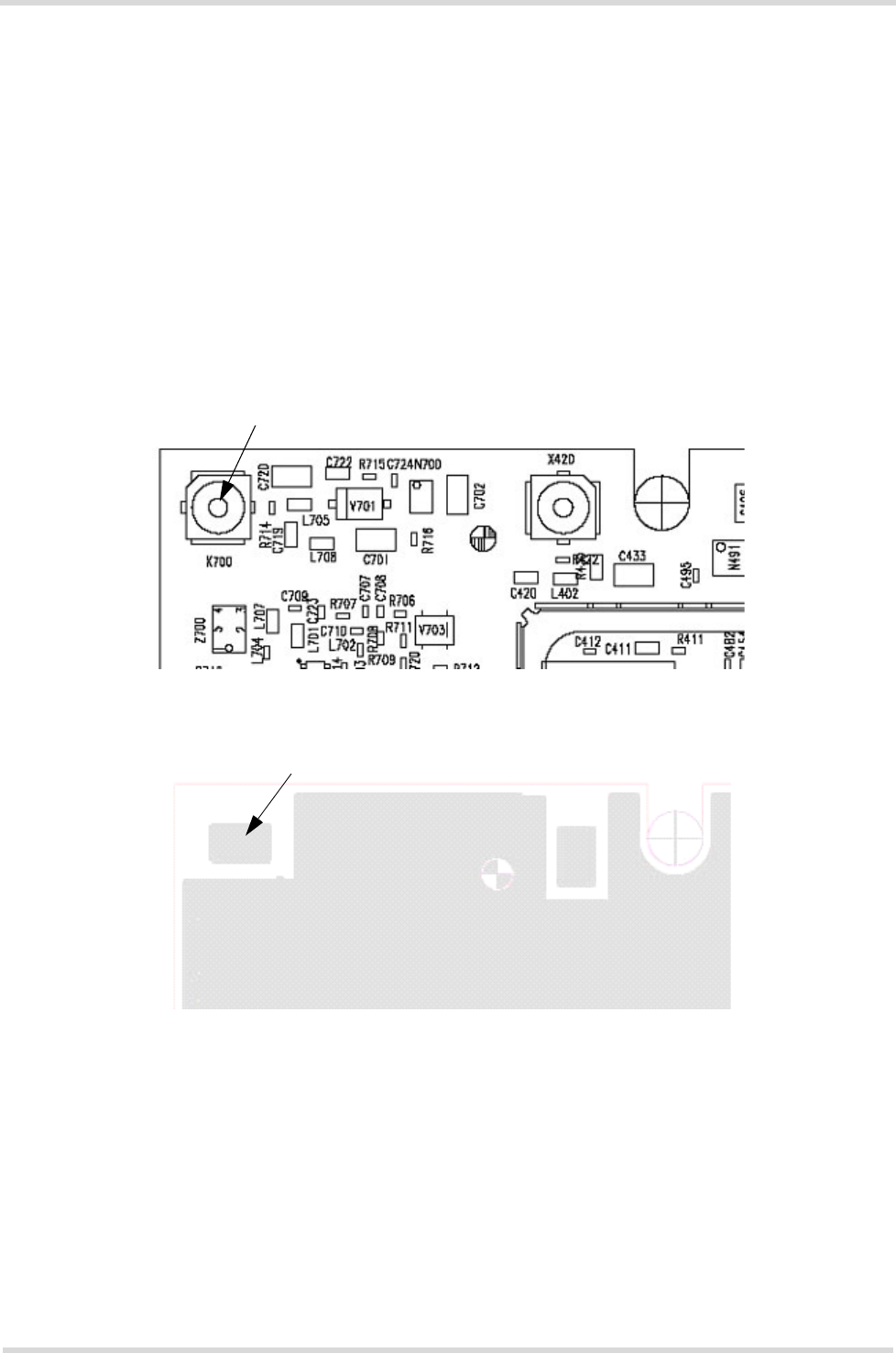
XT65/XT75 Hardware Interface Overview
5 GPS Antenna Interface s
XT65_XT75_HO_v00.130 Page 27 of 67 2006-10-12
Confidential / Preliminary
5 GPS Antenna Interface
In order to receive satellite signals an additional GPS antenna must be connected to the GPS part of the XT65/
XT75 module.
5.1 Antenna Installation
To suit the physical design of individual applications XT65/XT75 offers two alternative approaches to connecting
the antenna:
• Recommended approach: U.FL-R-SMT antenna connector from Hirose assembled on the component side of
the PCB. The GPS antenna connector is the same as for the GSM antenna connector. For details see Section
5.3.
Figure 8: GPS antenna connector placement
• Antenna pad and grounding plane placed on the bottom side of the PCB. For some notes on soldering the
antenna to the pad see Section 5.2.
Figure 9: GPS antenna pad placement
Note that it is not possible to employ both alternatives at the same time.

XT65/XT75 Hardware Interface Overview
5.2 GPS Antenna s
XT65_XT75_HO_v00.130 Page 28 of 67 2006-10-12
Confidential / Preliminary
5.2 GPS Antenna
It is possible to connect active or passive GPS antennas. In either case they must have 50 Ohm impedance. The
application should be designed in a way to achieve a minimum of 6dB decoupling between the GSM/DCS/PCS
antenna path and the GPS antenna path. Please note that the GPS antenna must be isolated for ESD protection
(to withstand a voltage resistance up to 8kV air discharge).
Active versus Passive Antennas
Passive antennas contain only the radiating element, e.g. the ceramic patch or the quadrifilar dipole structure.
Sometimes they also contain a passive matching network to match the electrical connection to 50 Ohms imped-
ance. Note: Passive antenna need not have a DC connection to ground.
Active antennas have an integrated low-noise amplifier (in some cases an additional GPS band pass filter). This
is beneficial in two respects: First, the losses of the cable do no longer influence the overall noise figure of the
GPS receiver system. Secondly, even the receiver noise figure can be higher without sacrificing performance.
Active antennas need a power supply that will contribute to GPS system power consumption, typically in the
region of 5 to 20 mA. The supply voltage is fed to the antenna through the coaxial RF cable.
Inside the antenna, the DC component on the inner conductor will be separated from the RF signal and routed
to the supply pin of the LNA.
The use of an active antenna is always advisable, if the RF-cable length between receiver and antenna exceeds
about 10 cm.
Note: If you are not an expert in RF designs, you should implement an active antenna setup and place the
antenna away from any emitting circuits.
Table 10: GPS antenna: Active versus Passive
Active Antenna Passive Antenna
Active antenna connected to the GPS module. Passive patch antennas or quadrifilar dipole antennas con-
nected with a microcoax to the GPS module
• A wide range of active patch or quadrifilar
dipole antennas is available in the market.
They differ in size, sensitivity, selectivity and
power consumption
• Less sensitive to jamming than a passive
antenna, as the placement of the active
antenna is usually some distance away of
other noise or signal radiating devices.
• Needs more power than a passive antenna
• Easier and less sensitive to jamming.
• More freedom to place the antenna1
1. Some cars for instance have a metallic coating on the windshield. GPS reception may not be possible in such a
car. There is usually a small section, typically behind the rear view mirror without the coating for mobile phone
and GPS antennas. The antenna has to be placed with optimal sky visibility. An external antenna (e.g. with a
magnetic base) is easier to use and usually allows a better positioning.
• Passive patch antennas or helical antennas are avail-
able in different form factors and sensitivity
• Antenna must be connected with a low insertion loss
line to the GPS module to ensure a good GPS sensitiv-
ity.
• The PCB design with a passive antenna must consider
the sensitivity of the GPS antenna to other radiating cir-
cuits or general signal jamming.
• Due to the proximity of the GPS antenna to other elec-
tronic circuits, in-band jamming may become a critical
issue.
• Only suitable for RF experts!
• Needs more experience in RF design.
• Requires more effort to optimise the circuit design to
minimize jamming into the antenna and the antenna
signal routing.
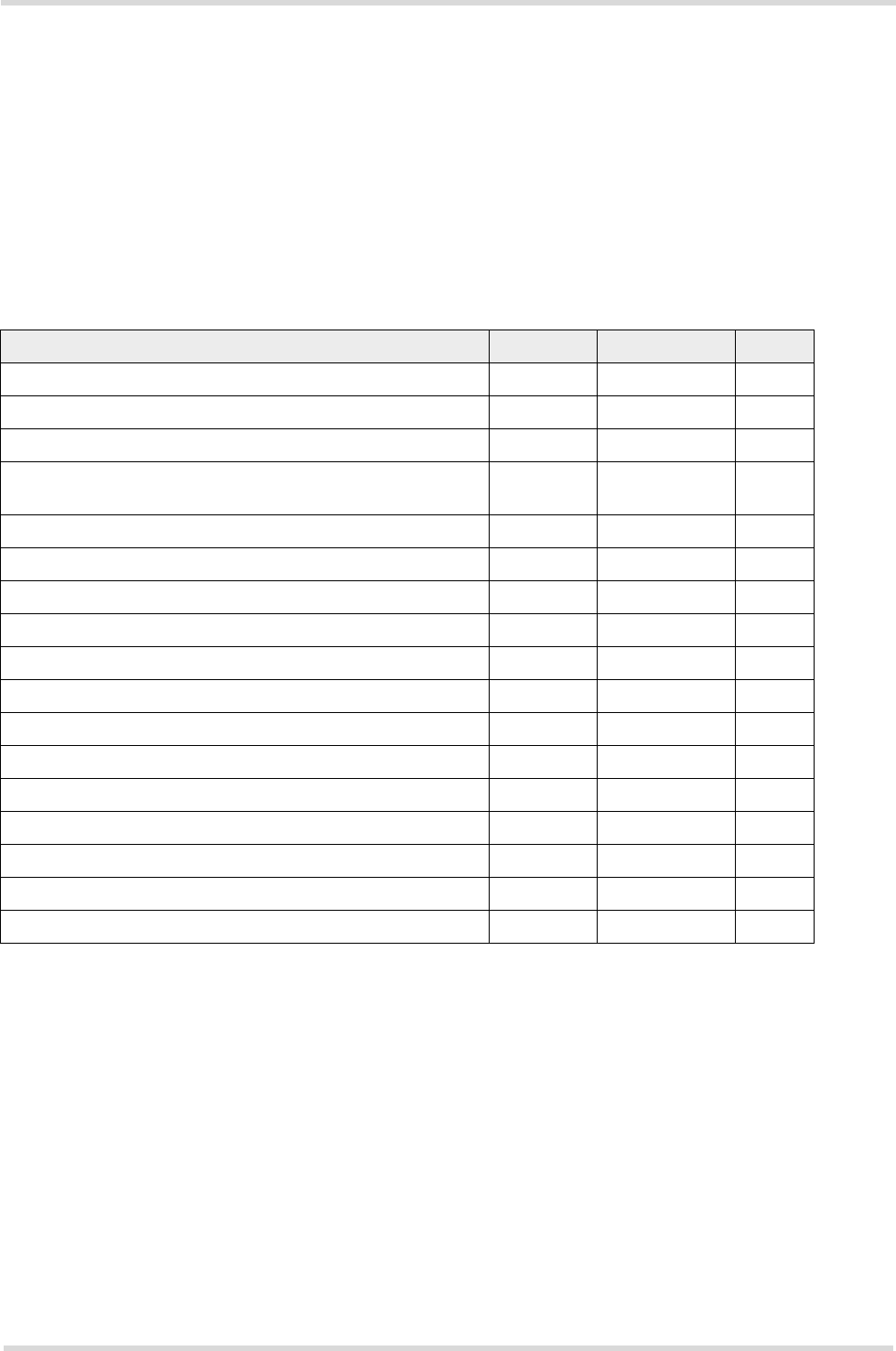
XT65/XT75 Hardware Interface Overview
6 Electrical, Reliability and Radio Characteristics s
XT65_XT75_HO_v00.130 Page 29 of 67 2006-10-12
Confidential / Preliminary
6 Electrical, Reliability and Radio Characteristics
6.1 Absolute Maximum Ratings
The absolute maximum ratings stated in Table 11 are stress ratings under any conditions. Stresses beyond any
of these limits will cause permanent damage to XT65/XT75.
The power supply connected to the XT65/XT75 module shall be compliant with the SELV requirements defined
in EN60950. Above all, the peak current of the power supply shall be limited according to Table 11.
Table 11: Absolute maximum ratings
Parameter Min Max Unit
Peak current of power supply 3.2 A
Supply voltage BATT+ -0.3 5.5 V
Voltage at digital pins in POWER DOWN mode -0.3 0.3 V
Voltage at digital pins in normal operation -0.3 3.05
or VEXT+0.3
V
Voltage at analog pins in POWER DOWN mode -0.3 0.3 V
Voltage at analog pins, VMIC on1
1. For normal operation the voltage at analog pins with VMIC on should be within the range of 0V to 2.4V
and with VMIC off within the range of -0.25V to 0.25V.
-0.3 2.75 V
Voltage at analog pins, VMIC off1-0.3 0.3 V
Voltage at VCHARGE pin -0.3 5.5 V
Voltage at CHARGEGATE pin -0.3 5.5 V
VUSB_IN -0.3 5.5 V
USB_DP, USB_DN -0.3 3.5 V
VSENSE 5.5 V
ISENSE 5.5 V
PWR_IND -0.3 510 V
VDDLP -0.3 5.5 V
GSM antenna -36 36 V
GPS antenna -0.3 VBATT++0.3 V
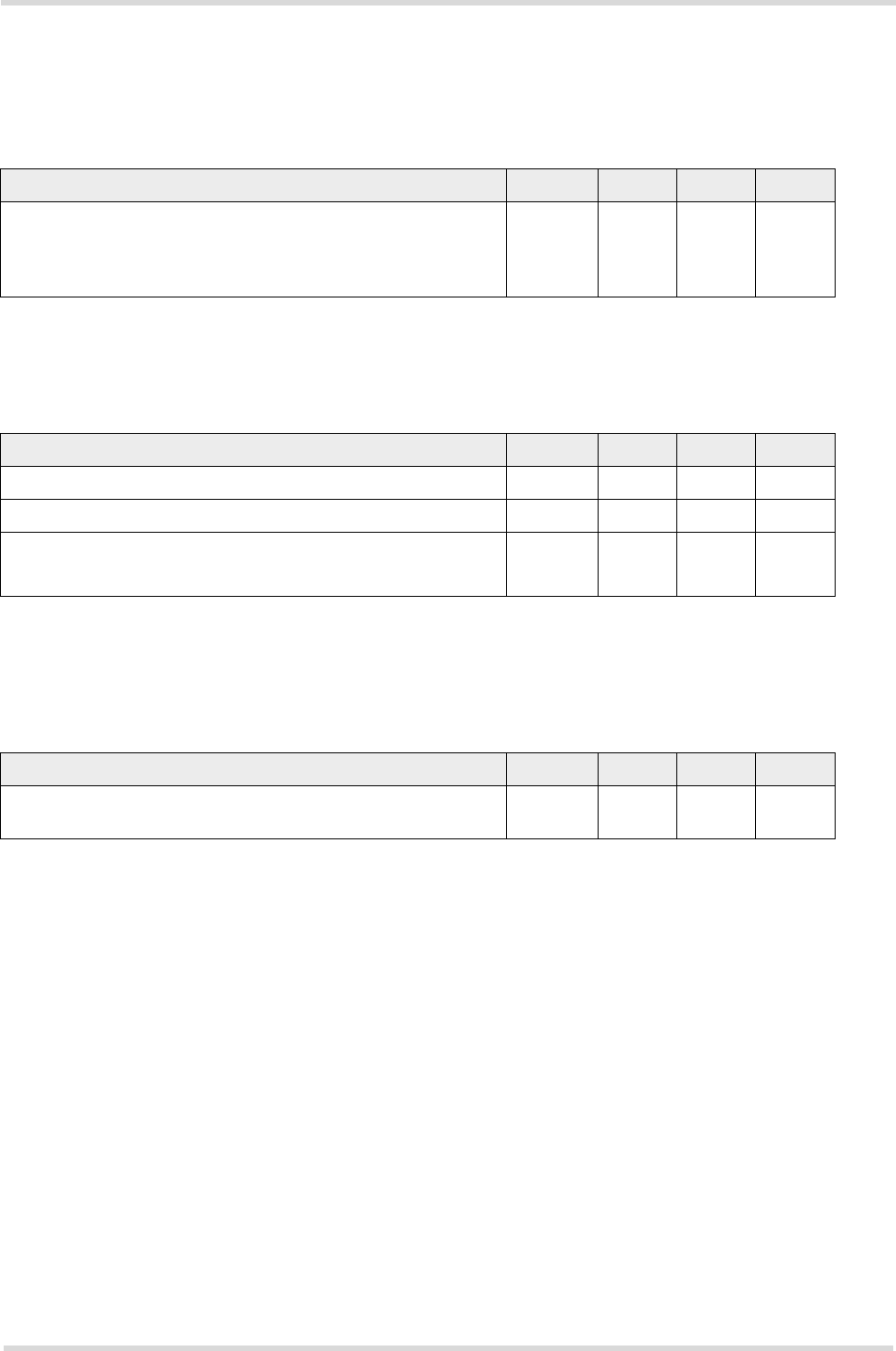
XT65/XT75 Hardware Interface Overview
6.2 Operating Temperatures s
XT65_XT75_HO_v00.130 Page 30 of 67 2006-10-12
Confidential / Preliminary
6.2 Operating Temperatures
Table 12: Board temperature
Parameter Min Typ Max Unit
Automatic shutdown1
Temperature measured on XT65/XT75 board
Temperature measured at battery NTC
1. Due to temperature measurement uncertainty, a tolerance on the stated shutdown thresholds may occur.
The possible deviation is in the range of ± 3°C at the overtemperature limit and ± 5°C at the undertem-
perature limit.
-30
-20
---
---
>+80
+60
°C
Table 13: Ambient temperature according to IEC 60068-2 (without forced air circulation)
Parameter Min Typ Max Unit
Operating temperature range -30 +25 +65 °C
Restricted operation (with VBATT ≤ 3,8V) +70 °C
Restricted operation1
1. Restricted operation allows normal mode speech calls or data transmission for limited time until automatic
thermal shutdown takes effect. For operating the XT75/65 above an expected ambient temperatures of
75°C please contact Siemens Application Engineering. The duration of emergency calls is unlimited be-
cause automatic thermal shutdown is deferred until hang up.
--- +70 to
+85
°C
Table 14: Charging temperature
Parameter Min Typ Max Unit
Battery temperature for software controlled fast charging
(measured at battery NTC)
0 --- +45 °C
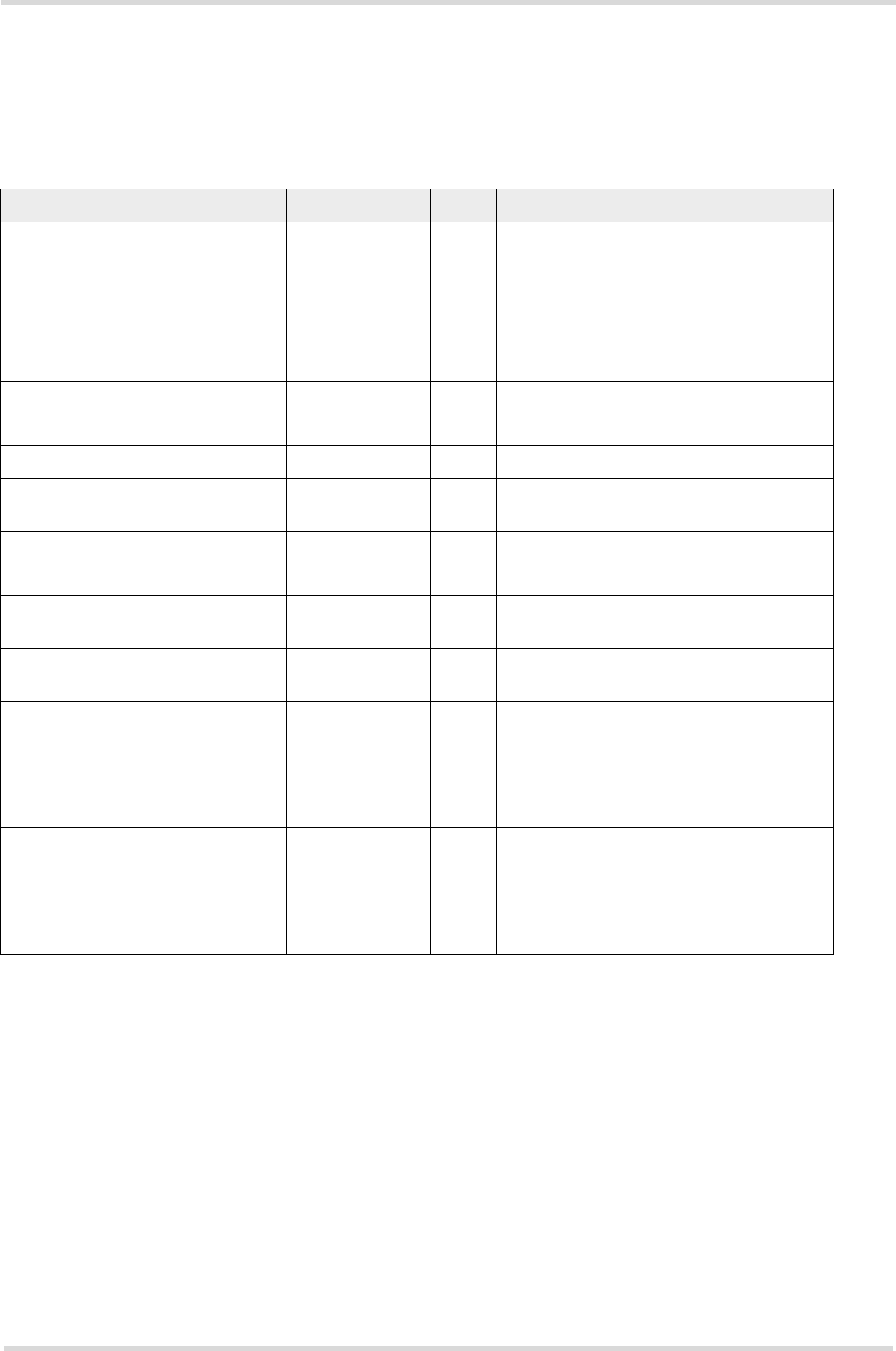
XT65/XT75 Hardware Interface Overview
6.3 Storage Conditions s
XT65_XT75_HO_v00.130 Page 31 of 67 2006-10-12
Confidential / Preliminary
6.3 Storage Conditions
The conditions stated below are only valid for modules in their original packed state in weather protected, non-
temperature-controlled storage locations. Normal storage time under these conditions is 12 months maximum.
Table 15: Storage conditions
Type Condition Unit Reference
Air temperature: Low
High
-40
+85
°C ETS 300 019-2-1: T1.2, IEC 68-2-1 Ab
ETS 300 019-2-1: T1.2, IEC 68-2-2 Bb
Humidity relative: Low
High
Condens.
10
90 at 30°C
90-100 at 30°C
% ---
ETS 300 019-2-1: T1.2, IEC 68-2-56 Cb
ETS 300 019-2-1: T1.2, IEC 68-2-30 Db
Air pressure: Low
High
70
106
kPa IEC TR 60271-3-1: 1K4
IEC TR 60271-3-1: 1K4
Movement of surrounding air 1.0 m/s IEC TR 60271-3-1: 1K4
Water: rain, dripping, icing and
frosting
Not allowed --- ---
Radiation: Solar
Heat
1120
600
W/m2ETS 300 019-2-1: T1.2, IEC 68-2-2 Bb
ETS 300 019-2-1: T1.2, IEC 68-2-2 Bb
Chemically active substances Not recom-
mended
IEC TR 60271-3-1: 1C1L
Mechanically active substances Not recom-
mended
IEC TR 60271-3-1: 1S1
Vibration sinusoidal:
Displacement
Acceleration
Frequency range
1.5
5
2-9 9-200
mm
m/s2
Hz
IEC TR 60271-3-1: 1M2
Shocks:
Shock spectrum
Duration
Acceleration
semi-sinusoidal
1
50
ms
m/s2
IEC 68-2-27 Ea
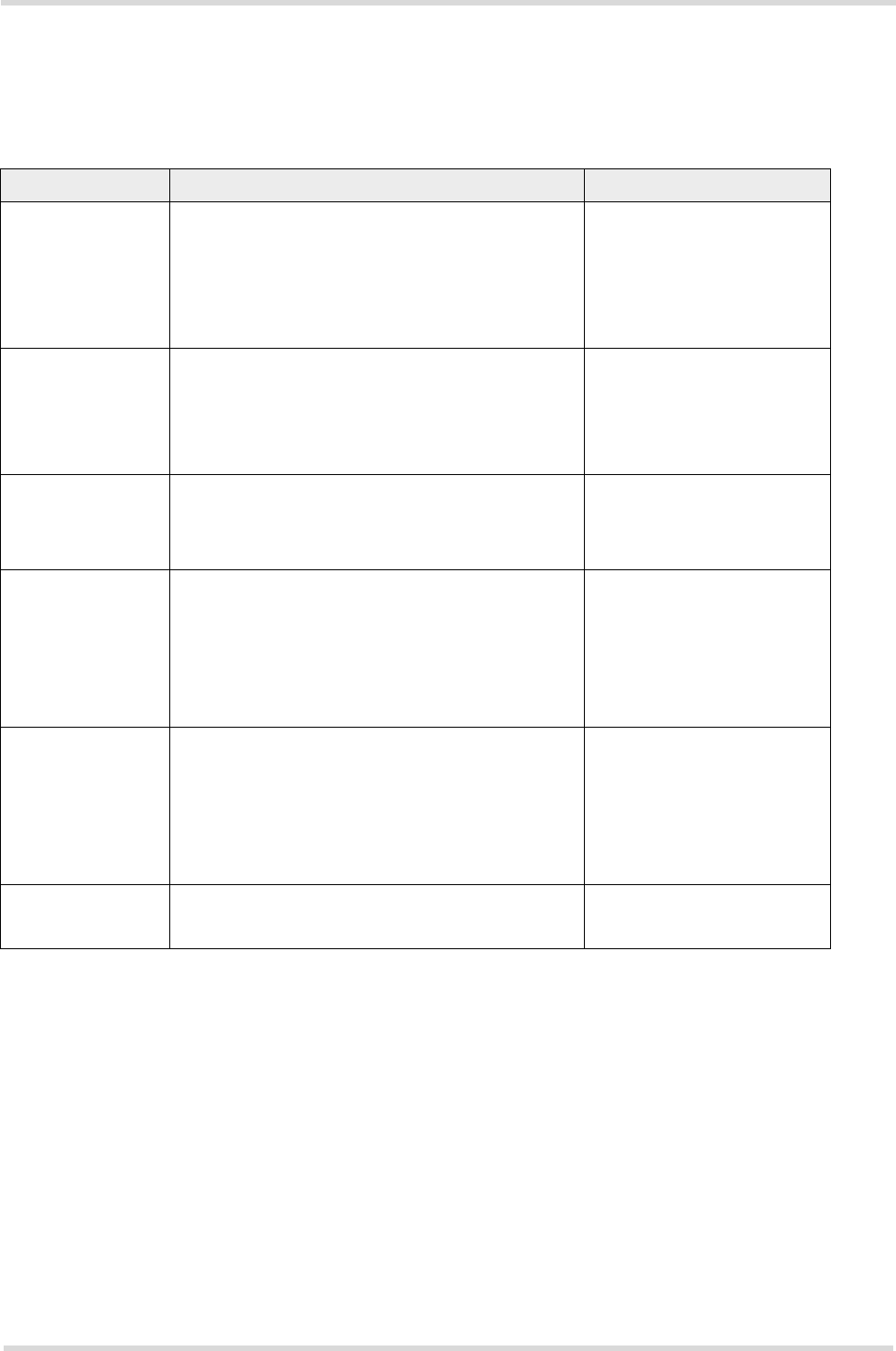
XT65/XT75 Hardware Interface Overview
6.4 Reliability Characteristics s
XT65_XT75_HO_v00.130 Page 32 of 67 2006-10-12
Confidential / Preliminary
6.4 Reliability Characteristics
The test conditions stated below are an extract of the complete test specifications.
Table 16: Summary of reliability test conditions
Type of test Conditions Standard
Vibration Frequency range: 10-20Hz; acceleration: 3.1mm
amplitude
Frequency range: 20-500Hz; acceleration: 5g
Duration: 2h per axis = 10 cycles; 3 axes
DIN IEC 68-2-6
Shock half-sinus Acceleration: 500g
Shock duration: 1msec
1 shock per axis
6 positions (± x, y and z)
DIN IEC 68-2-27
Dry heat Temperature: +70 ±2×C
Test duration: 16h
Humidity in the test chamber: < 50%
EN 60068-2-2 Bb
ETS 300 019-2-7
Temperature
change (shock)
Low temperature: -40×C ±2×C
High temperature: +85×C ±2×C
Changeover time: < 30s (dual chamber system)
Test duration: 1h
Number of repetitions: 100
DIN IEC 68-2-14 Na
ETS 300 019-2-7
Damp heat cyclic High temperature: +55×C ±2×C
Low temperature: +25×C ±2×C
Humidity: 93% ±3%
Number of repetitions: 6
Test duration: 12h + 12h
DIN IEC 68-2-30 Db
ETS 300 019-2-5
Cold (constant
exposure)
Temperature: -40 ±2×C
Test duration: 16h
DIN IEC 68-2-1
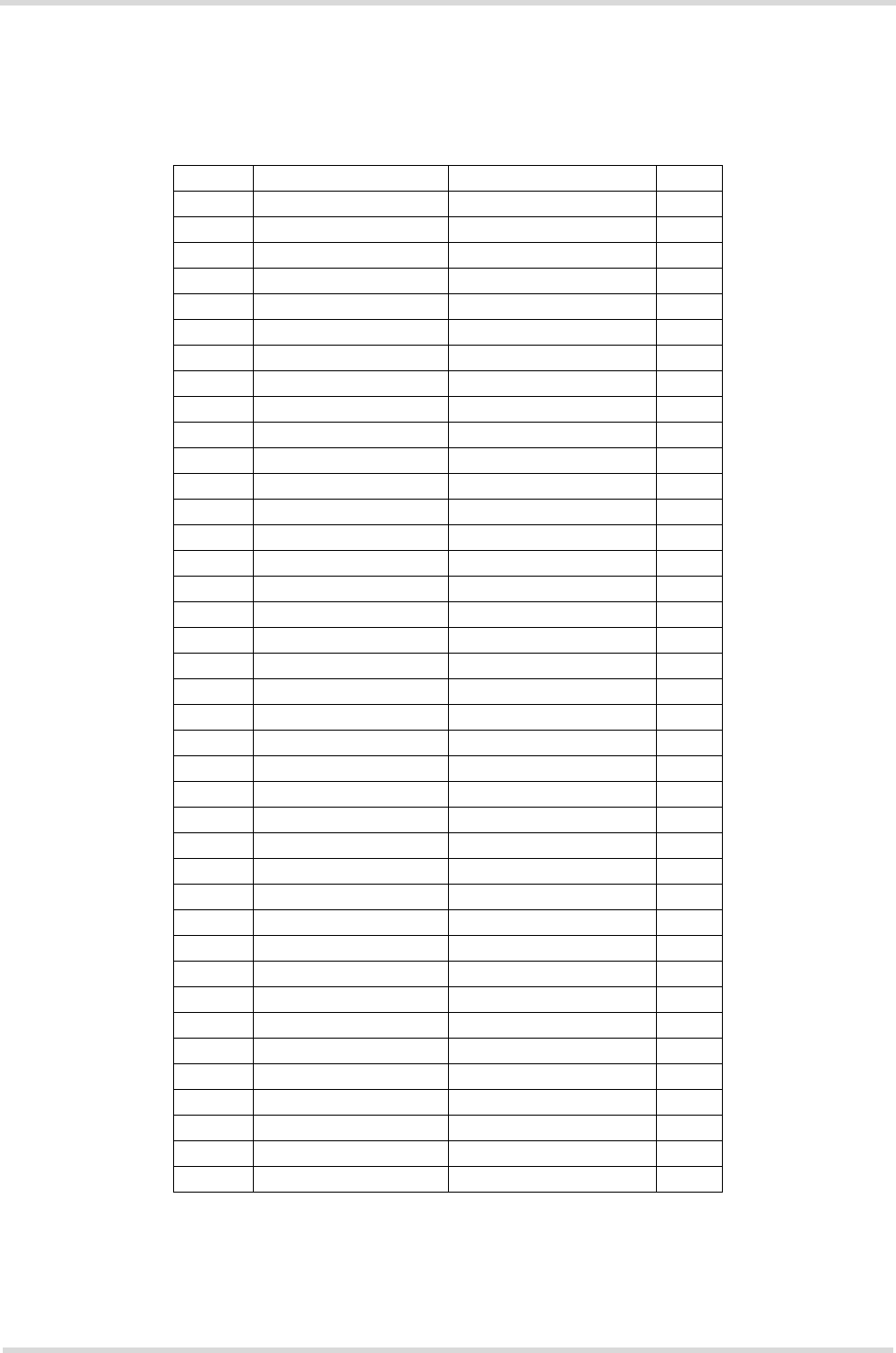
XT65/XT75 Hardware Interface Overview
6.5 Pin Assignment and Signal Description s
XT65_XT75_HO_v00.130 Page 33 of 67 2006-10-12
Confidential / Preliminary
6.5 Pin Assignment and Signal Description
The Molex board-to-board connector on XT65/XT75 is an 80-pin double-row receptacle. The position of the
board-to-board connector can be seen in Figure 11 that shows the top view of XT65/XT75.
Figure 10: Pin assignment (component side of XT65/XT75)
1GND GND 80
2 ADC1_IN DAC_OUT 79
3ADC2_IN PWR_IND 78
4GND Do not use 77
5GPIO10 GPIO9 76
6GPIO8 SPICS 75
7SPIDI GPIO4 74
8GPIO7 GPIO3 73
9GPIO6 GPIO2 72
10 GPIO5 GPIO1 71
11 I2CCLK_SPICLK I2CDAT_SPIDO 70
12 VUSB_IN USB_DP 69
13 DAI5 USB_DN 68
14 ISENSE VSENSE 67
15 DAI6 VMIC 66
16 CCCLK EPN2 65
17 CCVCC EPP2 64
18 CCIO EPP1 63
19 CCRST EPN1 62
20 CCIN MICN2 61
21 CCGND MICP2 60
22 DAI4 MICP1 59
23 DAI3 MICN1 58
24 DAI2 AGND 57
25 DAI1 IGT 56
26 DAI0 EMERG_RST 55
27 BATT_TEMP DCD0 54
28 SYNC not connected 53
29 not connected CTS0 52
30 RXD0 Pull up 51
31 Pull up DTR0 50
32 TXD0 RTS0 49
33 VDDLP DSR0 48
34 VCHARGE RING0 47
35 CHARGEGATE VEXT 46
36 GND BATT+ 45
37 GND BATT+ 44
38 GND BATT+ 43
39 GND BATT+ 42
40 GND BATT+ 41
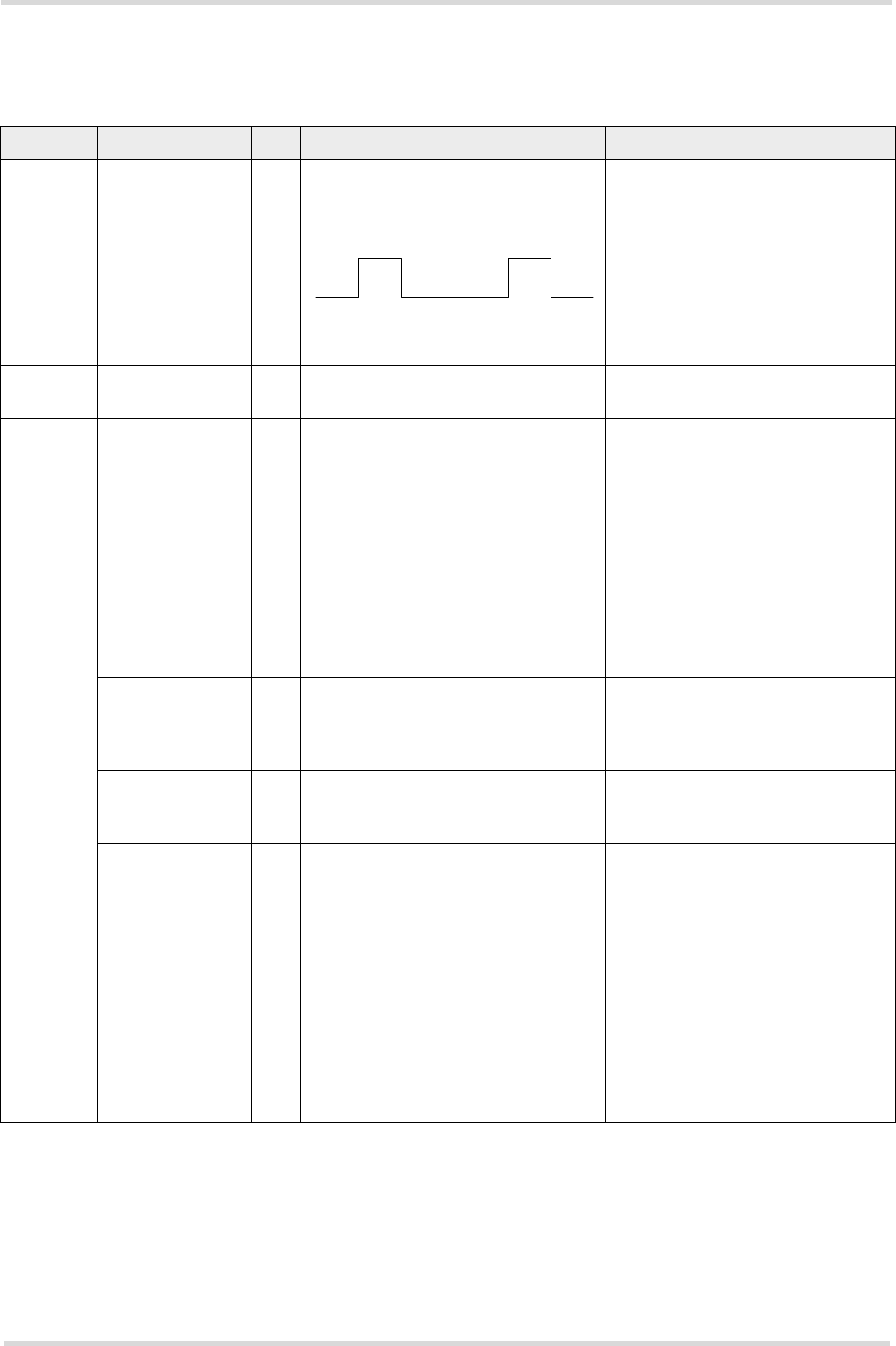
XT65/XT75 Hardware Interface Overview
6.5 Pin Assignment and Signal Description s
XT65_XT75_HO_v00.130 Page 34 of 67 2006-10-12
Confidential / Preliminary
Please note that the reference voltages listed in Table 17 are the values measured directly on the XT65/XT75
module. They do not apply to the accessories connected.
Table 17: Signal description
Function Signal name IO Signal form and level Comment
Power
supply
BATT+ I VI = 3.3V to 4.5V
VItyp = 3.8V
I ≈ 2A, during Tx burst
n Tx = n x 577µs peak current every
4.616ms
Five pins of BATT+ and GND must
be connected in parallel for supply
purposes because higher peak
currents may occur.
Power
supply
GND Ground Application Ground
Charge
Interface
VCHARGE I VImin = 3.1 V
VImax = 5.25V
This line signalizes to the proces-
sor that the charger is connected.
If unused keep pin open.
BATT_TEMP I Connect NTC with RNTC ≈ 10kΩ @
25°C to ground.
Battery temperature measurement
via NTC resistance.
NTC should be installed inside or
near battery pack to enable proper
charging and deliver temperature
values.
If unused keep pin open.
ISENSE I VImax = 4.65V
ΔVImax to VBATT+ = +0.3V at normal
condition
Connect ISENSE directly at the
shunt for current measurement.
If unused connect pin to VSENSE.
VSENSE I VImax = 4.5V VSENSE must be directly con-
nected to BATT+ at battery con-
nector or external power supply.
CHARGEGATE O VImax = 5.5V
IImax = 0.6mA (for fast charging)
Control line to the gate of charge
FET
If unused keep pin open.
External
supply
voltage
VEXT O Normal mode:
VOmin = 2.75V
VOtyp = 2.93V
VOmax = 3.05V
IOmax = -50mA
Cload,max,extern = 1µF
VEXT may be used for application
circuits, for example to supply
power for an I2C.
If unused keep pin open.
Not available in Power-down
mode. The external digital logic
must not cause any spikes or
glitches on voltage VEXT.
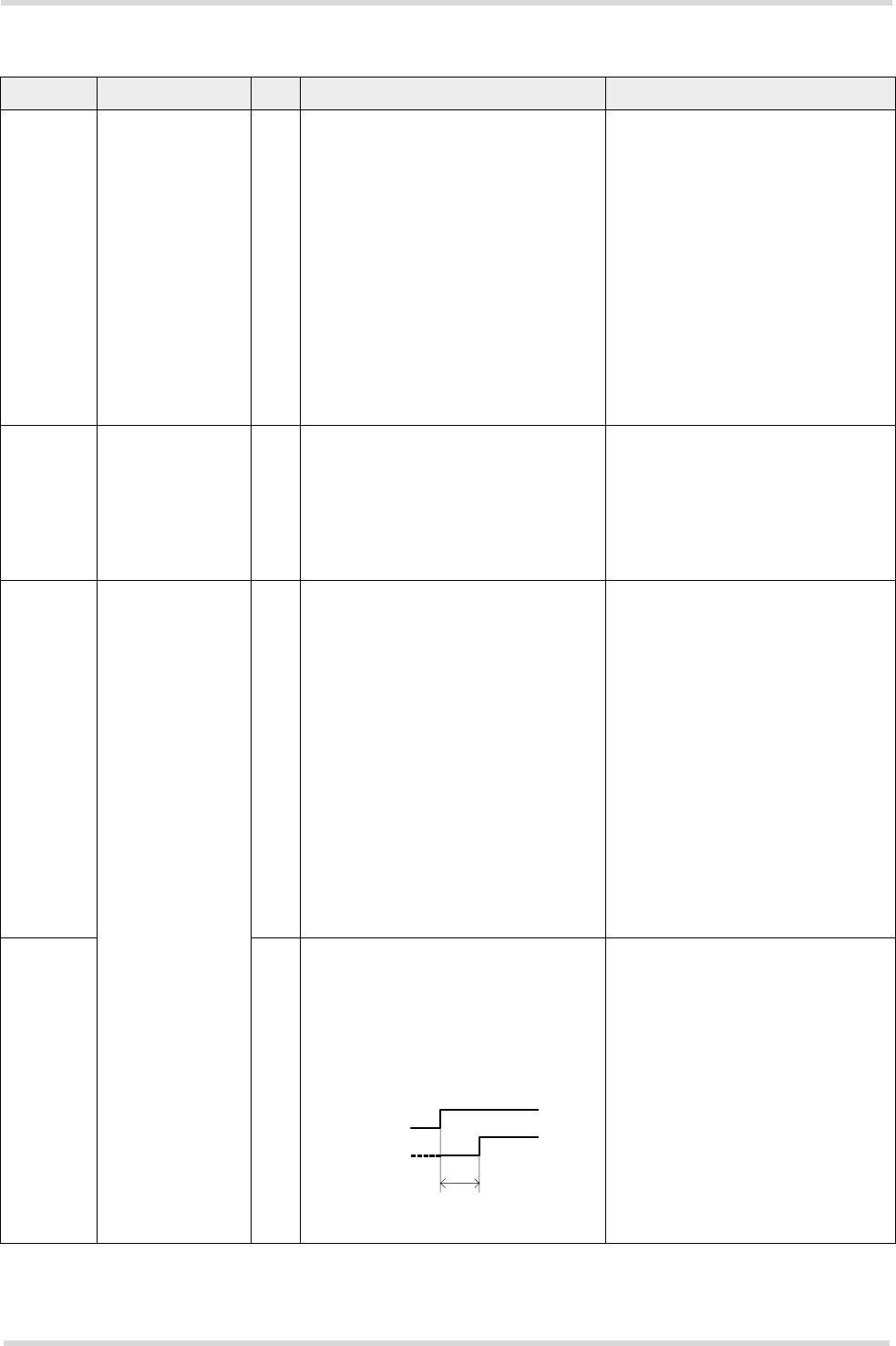
XT65/XT75 Hardware Interface Overview
6.5 Pin Assignment and Signal Description s
XT65_XT75_HO_v00.130 Page 35 of 67 2006-10-12
Confidential / Preliminary
Power
indicator
PWR_IND O VIHmax = 10V
VOLmax = 0.4V at Imax = 2mA
PWR_IND (Power Indicator) noti-
fies the module’s on/off state.
PWR_IND is an open collector
that needs to be connected to an
external pull-up resistor. Low state
of the open collector indicates that
the module is on. Vice versa, high
level notifies the Power-down
mode.
Therefore, the pin may be used to
enable external voltage regulators
which supply an external logic for
communication with the module,
e.g. level converters.
Ignition IGT I Internal pull-up: RI ≈ 30kΩ, CI ≈ 10nF
VILmax = 0.8V at Imax = -150µA
VOHmax = VBATT+
ON ~~~|____|~~~ Active Low ≥ 300ms
This signal switches the mobile
on.
This line must be driven low by an
open drain or open collector
driver.
Emer-
gency
reset
EMERG_RST I Internal pull-up: RI ≈ 5kΩ
VILmax = 0.2V at Imax = -0.5mA
VOHmin = 1.75V
VOHmax = 3.05V
Signal ~~~|______|~~~ Pull down ≥
10ms
Reset or shut down in case of
emergency: Pull down and release
EMERG_RST. Then, activating
IGT for 400ms will reset XT65/
XT75. If IGT is not activated for
400ms, XT65/XT75 switches off.
Data stored in the volatile memory
will be lost. For orderly software
controlled reset rather use the
AT+CFUN command (e.g.
AT+CFUN=x,1).
This line must be driven by open
drain or open collector.
If unused keep pin open.
Power-on
reset
O Internal pull-up: RI ≈ 5kΩ
VOLmax = 0.2V at I = 2mA
VOHmin = 1.75V
VOHmax = 3.05V
Reset signal driven by the module:
Reset signal driven by the module
which can be used to reset any
application or device connected to
the module. Only effective for
120ms during the assertion of IGT
when the module is about to start.
Table 17: Signal description
Function Signal name IO Signal form and level Comment
VEXT
EMRG_RST
appr. 120ms
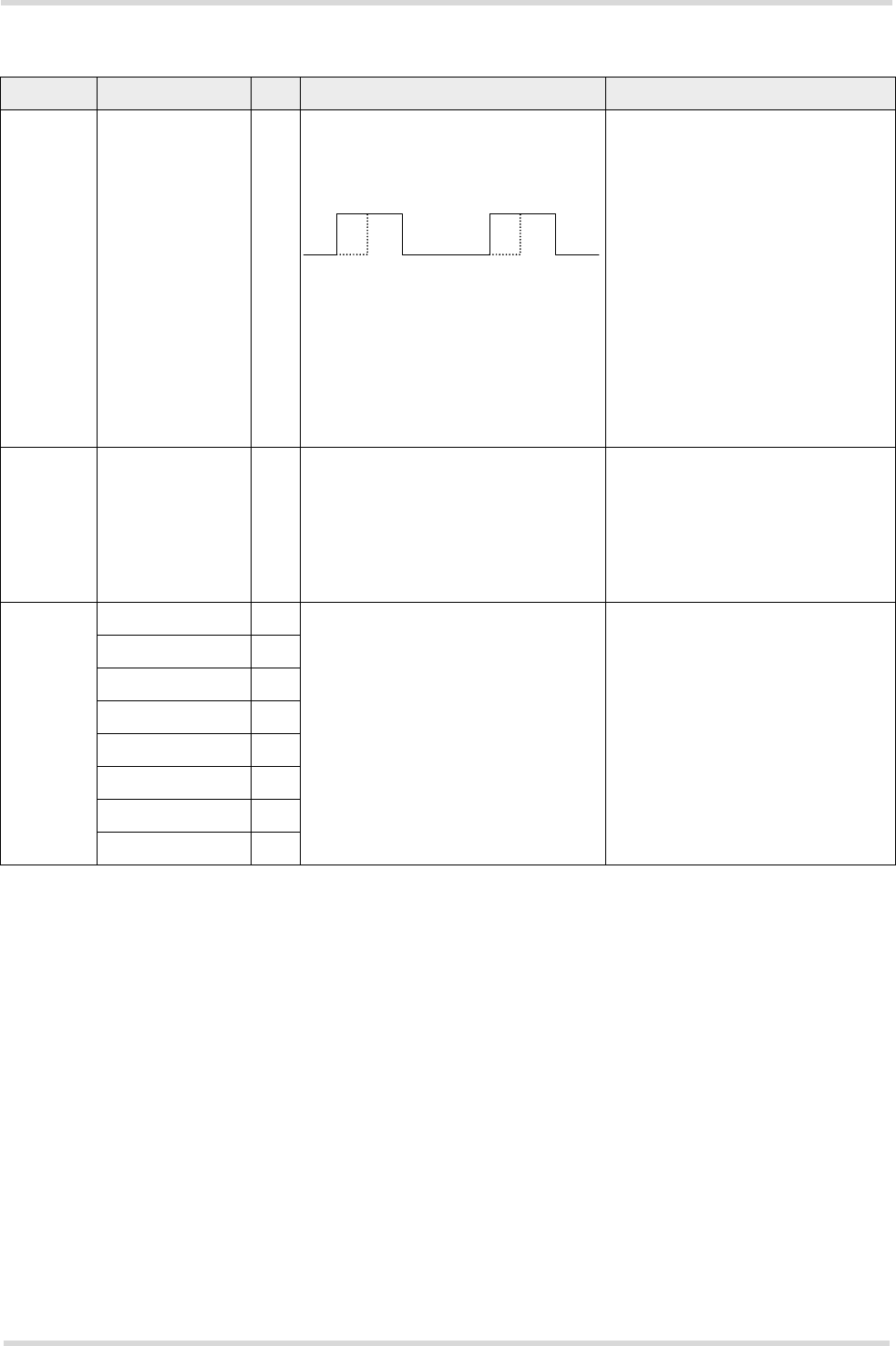
XT65/XT75 Hardware Interface Overview
6.5 Pin Assignment and Signal Description s
XT65_XT75_HO_v00.130 Page 36 of 67 2006-10-12
Confidential / Preliminary
Syn-
chroni-
zation
SYNC O VOLmax = 0.3V at I = 0.1mA
VOHmin = 2.3V at I = -0.1mA
VOHmax = 3.05V
n Tx = n x 577µs impulse each
4.616ms, with 180µs forward time.
There are two alternative options
for using the SYNC pin:
a) Indicating increased current
consumption during uplink trans-
mission burst. Note that the timing
of the signal is different during
handover.
b) Driving a status LED to indicate
different operating modes of
XT65/XT75. The LED must be
installed in the host application.
To select a) or b) use the
AT^SSYNC command.
If unused keep pin open.
RTC
backup
VDDLP I/O RI ≈ 1kΩ
VOmax = 4.5V
VBATT+ = 4.2V:
VO = 3.3V at IO = -500µA
VBATT+ = 0V:
VI = 2.4V…4.5V at Imax = 25µA
If unused keep pin open.
ASC0
Serial
interface
RXD0 O VOLmax = 0.2V at I = 2mA
VOHmin = 2.55V at I = -0.5mA
VOHmax = 3.05V
VILmax = 0.8V
VIHmin = 2.15V
VIHmax = VEXTmin + 0.3V = 3.05V
Serial interface for AT commands
or data stream.
If lines are unused keep pins open.
TXD0 I
CTS0 O
RTS0 I
DTR0 I
DCD0 O
DSR0 O
RING0 O
Table 17: Signal description
Function Signal name IO Signal form and level Comment
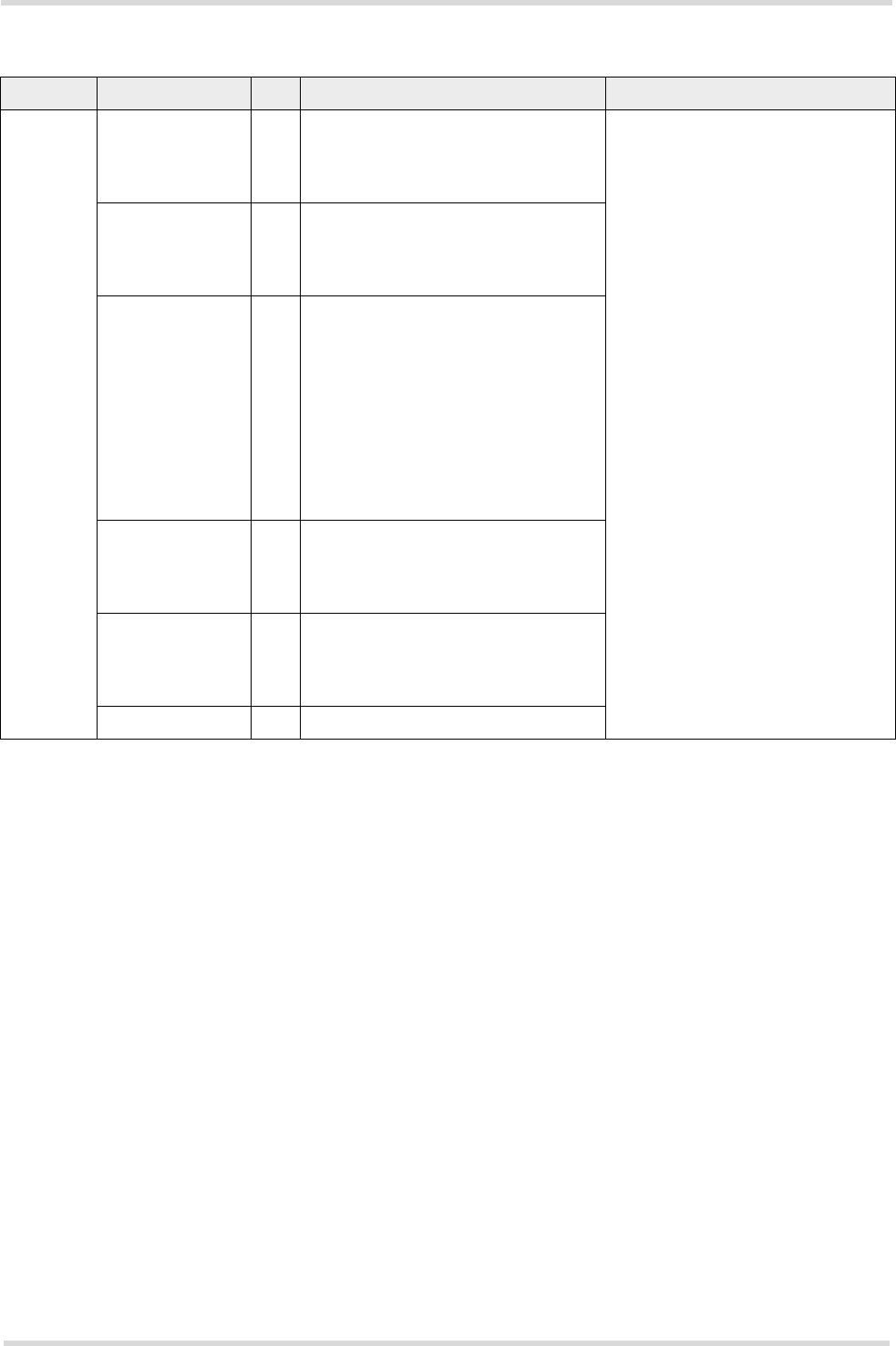
XT65/XT75 Hardware Interface Overview
6.5 Pin Assignment and Signal Description s
XT65_XT75_HO_v00.130 Page 37 of 67 2006-10-12
Confidential / Preliminary
SIM
interface
specified
for use
with 3V
SIM card
CCIN I RI ≈ 100kΩ
VILmax = 0.6V at I = -25µA
VIHmin = 2.1V at I = -10µA
VOmax = 3.05V
CCIN = Low, SIM card holder
closed
Maximum cable length or copper
track 100mm to SIM card holder.
All signals of SIM interface are
protected against ESD with a spe-
cial diode array.
Usage of CCGND is mandatory.
CCRST O RO ≈ 47Ω
VOLmax = 0.25V at I = +1mA
VOHmin = 2.5V at I = -0.5mA
VOHmax = 2.95V
CCIO I/O RI ≈ 4.7kΩ
VILmax = 0.75V
VILmin = -0.3V
VIHmin = 2.1V
VIHmax = CCVCCmin + 0.3V =
3.05V
RO ≈ 100Ω
VOLmax = 0.3V at I = +1mA
VOHmin = 2.5V at I = -0.5mA
VOHmax = 2.95V
CCCLK O RO ≈ 100Ω
VOLmax = 0.3V at I = +1mA
VOHmin = 2.5V at I = -0.5mA
VOHmax = 2.95V
CCVCC O VOmin = 2.75V
VOtyp = 2.85V
VOmax = 2.95V
IOmax = -20mA
CCGND Ground
Table 17: Signal description
Function Signal name IO Signal form and level Comment
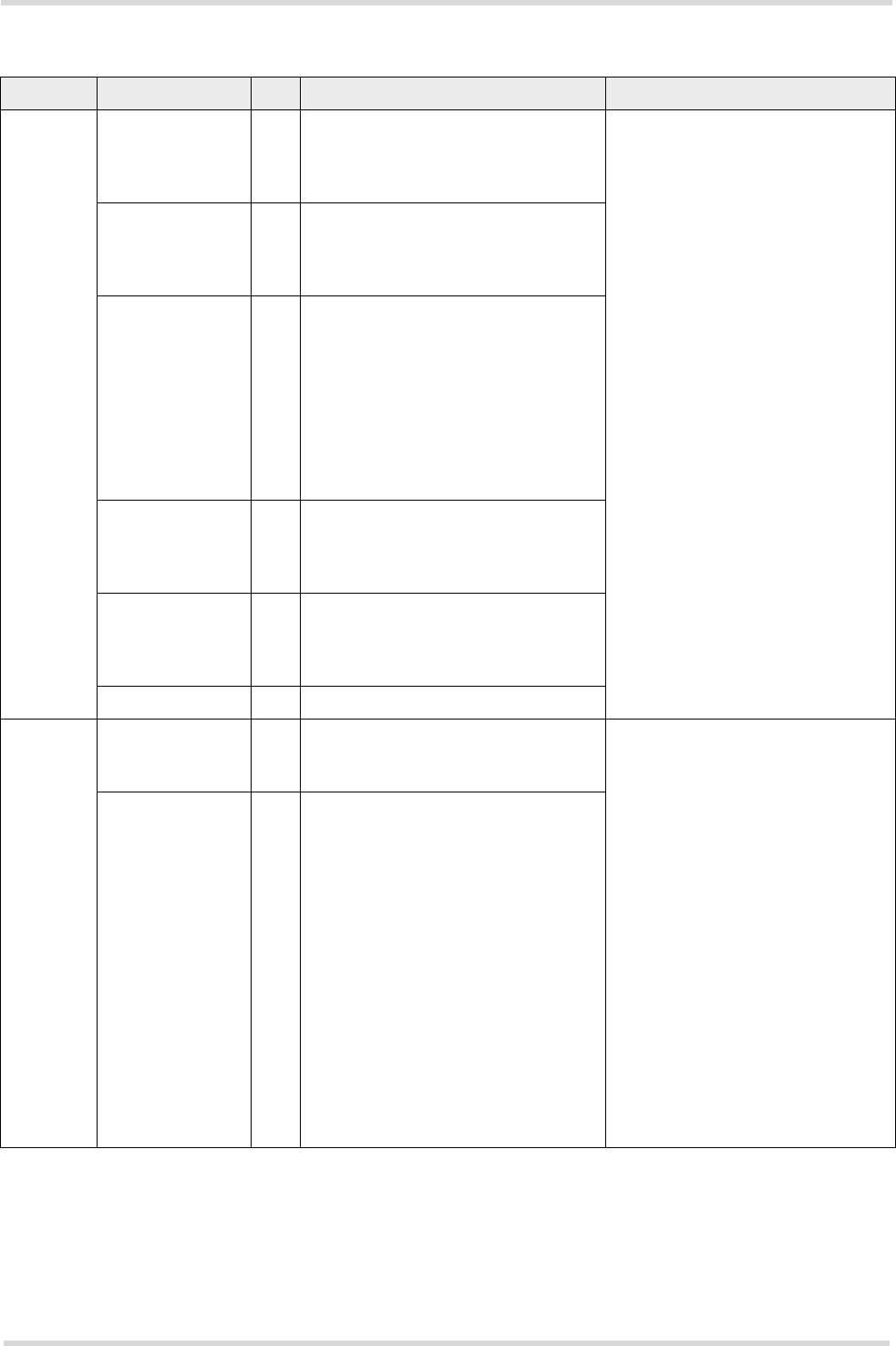
XT65/XT75 Hardware Interface Overview
6.5 Pin Assignment and Signal Description s
XT65_XT75_HO_v00.130 Page 38 of 67 2006-10-12
Confidential / Preliminary
SIM
interface
specified
for use
with 1.8V
SIM card
CCIN I RI ≈ 100kΩ
VILmax = 0.6V at I = -25µA
VIHmin = 2.1V at I = -10µA
VOmax = 3.05V
CCIN = Low, SIM card holder
closed
Maximum cable length or copper
track 100mm to SIM card holder.
All signals of SIM interface are
protected against ESD with a spe-
cial diode array.
Usage of CCGND is mandatory.
CCRST O RO ≈ 47Ω
VOLmax = 0.25V at I = +1mA
VOHmin = 1.45V at I = -0.5mA
VOHmax = 1.90V
CCIO I/O RI ≈ 4.7kΩ
VILmax = 0.45V
VIHmin = 1.35V
VIHmax = CCVCCmin + 0.3V =
2.00V
RO ≈ 100Ω
VOLmax = 0.3V at I = +1mA
VOHmin = 1.45V at I = -0.5mA
VOHmax = 1.90V
CCCLK O RO ≈ 100Ω
VOLmax = 0.3V at I = +1mA
VOHmin = 1.45V at I = -0.5mA
VOHmax = 1.90V
CCVCC O VOmin = 1.70V,
VOtyp = 1.80V
VOmax = 1.90V
IOmax = -20mA
CCGND Ground
I2C inter-
face
I2CCLK
_SPICLK
OV
OLmax = 0.2V at I = 2mA
VOHmin = 2.55V at I = -0.5mA
VOHmax = 3.05V
I2C interface is only available if the
two pins are not used as SPI inter-
face.
I2CDAT is configured as Open
Drain and needs a pull-up resistor
in the host application.
According to the I2C Bus Specifi-
cation Version 2.1 for the fast
mode a rise time of max. 300ns is
permitted. There is also a maxi-
mum VOL=0.4V at 3mA specified.
The value of the pull-up depends
on the capacitive load of the whole
system (I2C Slave + lines). The
maximum sink current of I2CDAT
and I2CCLK is 4mA.
If lines are unused keep pins open.
I2CDAT_SPIDO I/O VOLmax = 0.2V at I = 2mA
VILmax = 0.8V
VIHmin = 2.15V
VIHmax = VEXTmin + 0.3V = 3.05V
Table 17: Signal description
Function Signal name IO Signal form and level Comment
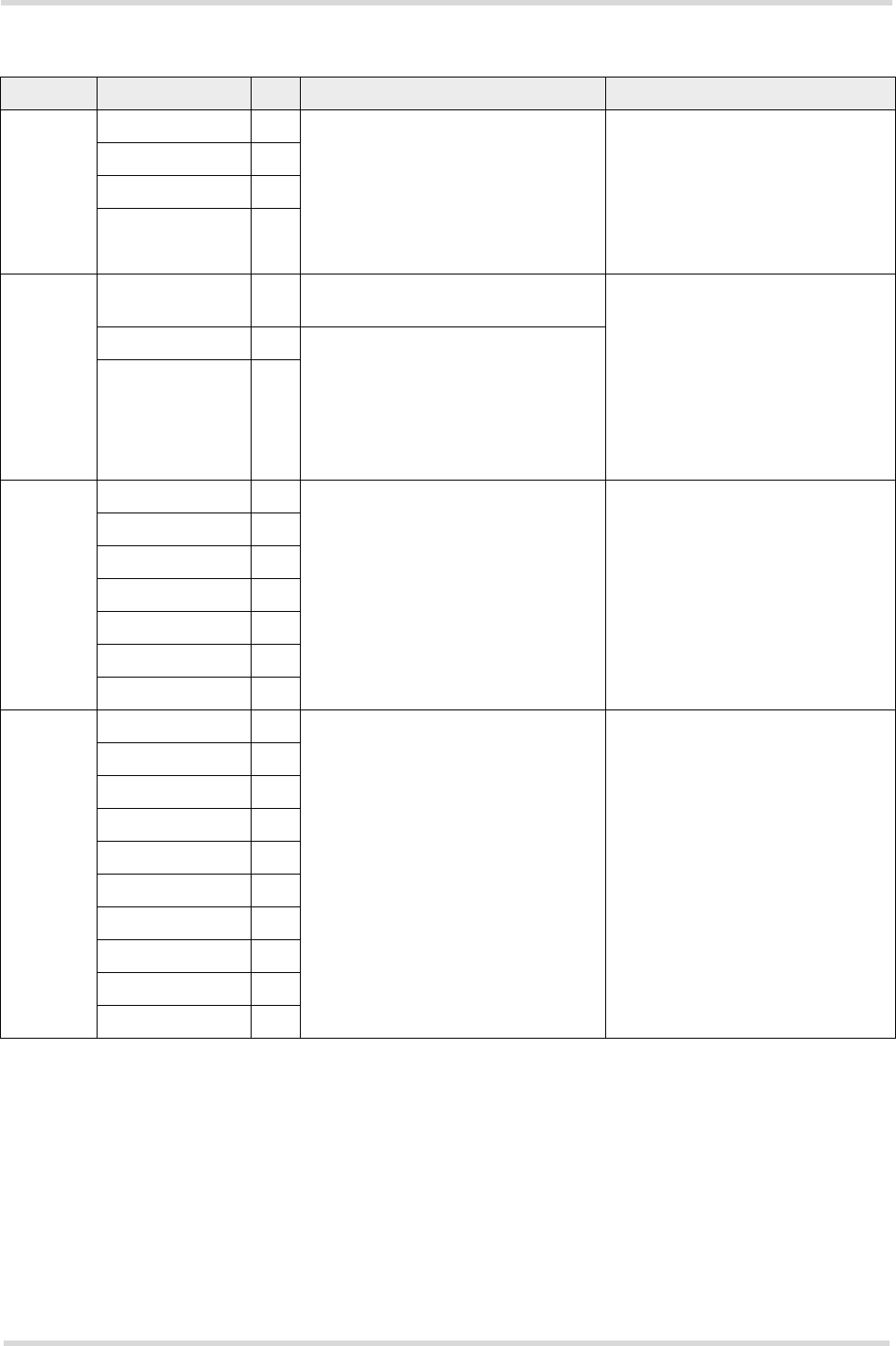
XT65/XT75 Hardware Interface Overview
6.5 Pin Assignment and Signal Description s
XT65_XT75_HO_v00.130 Page 39 of 67 2006-10-12
Confidential / Preliminary
SPI
Serial
Periph-
eral Inter-
face
SPIDI I VOLmax = 0.2V at I = 2mA
VOHmin = 2.55V at I = -0.5mA
VOHmax = 3.05V
VILmax = 0.8V
VIHmin = 2.15V,
VIHmax = VEXTmin + 0.3V = 3.05V
If the Serial Peripheral Interface is
active the I2C interface is not avail-
able.
If lines are unused keep pins open.
I2CDAT_SPIDO O
I2CCLK_SPICLK O
SPICS O
USB VUSB_IN I VINmin = 4.0V
VINmax = 5.25V
All electrical characteristics
according to USB Implementers’
Forum, USB 2.0 Full Speed Spec-
ification.
Without Java: USB port
Under Java: Debug interface for
development purposes.
If lines are unused keep pins open.
USB_DN I/O Differential Output Crossover volt-
age Range
VCRSmin = 1.5V, VCRSmax = 2.0V
Driver Output Resistance
ZDRVtyp = 32Ohm
USB_DP I/O
Digital
Audio
interface
DAI0 (USC0) I/O VOLmax = 0.2V at I = 2mA
VOHmin = 2.55V at I = -0.5mA
VOHmax = 3.05V
VILmax = 0.8V
VIHmin = 2.15V
VIHmax = VEXTmin + 0.3V = 3.05V
DAI0…DAI6 are configurable as
PCM interface
DAI1 (USC1) I/O
DAI2 (USC2) I/O
DAI3 (USC3) I/O
DAI4 (USC4) I/O
DAI5 (USC5) I/O
DAI6 (USC6) I/O
General
Purpose
Input/Out-
put
GPIO1 I/O VOLmax = 0.2V at I = 2mA
VOHmin = 2.55V at I = -0.5mA
VOHmax = 3.05V
VILmax = 0.8V
VIHmin = 2.15V,
VIHmax = VEXTmin + 0.3V = 3.05V
All pins which are configured as
input must be connected to a pull-
up or pull-down resistor.
If lines are unused (not config-
ured) keep pins open.
Alternatively, the GPIO10 pin can
be configured as a pulse counter
for pulse rates from 0 to 1000
pulses per second.
GPIO2 I/O
GPIO3 I/O
GPIO4 I/O
GPIO5 I/O
GPIO6 I/O
GPIO7 I/O
GPIO8 I/O
GPIO9 I/O
GPIO10 I/O
Table 17: Signal description
Function Signal name IO Signal form and level Comment

XT65/XT75 Hardware Interface Overview
6.5 Pin Assignment and Signal Description s
XT65_XT75_HO_v00.130 Page 40 of 67 2006-10-12
Confidential / Preliminary
Analog
Digital
Converter
ADC1_IN I Input voltage: VImin = 0V, VImax =
2.4V
Ri ≈ 750kOhms Measurement inter-
val: 100ms - 30s selectable by AT
command
Sensitivity, accuracy: 2400 steps
(1step = 1mv)
Cut-off frequency: 30 Hz
Underflow: ≥ -25mV
Overflow: ≥ +2425 mV
Accuracy: ± 0.5mV
Linear error: ± 0.5mV
Temperature error: ± 0.5mV
Burst error: ± 0.5mV
Inputs used for measuring exter-
nal voltages. In the range of 0mV
to 2400mV.
Use the command AT^SRADC to
select analog inputs ADC1_IN or
ADC2_IN, to set the measurement
mode and read out the results.
The values are indicated in mV.
ADC1_IN and ADC2_IN are inter-
nally multiplexed through analog
switch.
Important:
For restrictions during SLEEP
mode see 1.
ADC2_IN I
Digital
Analog
Converter
DAC_OUT O VOLmax = 0.2V at I = 2mA
VOHmin = 2.55V at I = -0.5mA
VOHmax = 3.05V
PWM signal which can be
smoothed by an external filter.
Use the AT^SWDAC command to
open and configure the DAC_OUT
output.
Table 17: Signal description
Function Signal name IO Signal form and level Comment

XT65/XT75 Hardware Interface Overview
6.5 Pin Assignment and Signal Description s
XT65_XT75_HO_v00.130 Page 41 of 67 2006-10-12
Confidential / Preliminary
Analog
Audio
interface
VMIC O VOmin = 2.4V
VOtyp = 2.5V
VOmax = 2.6V
Imax = 2mA
Microphone supply for customer
feeding circuits
EPP2 O 3.0Vpp differential typical @ 0dBm0
4.2Vpp differential maximal @
3.14dBm0
Measurement conditions:
Audio mode: 6
Outstep 3
No load
Minimum differential resp. single
ended load 27Ohms
The audio output can directly
operate a 32-Ohm-loudspeaker.
If unused keep pins open.
EPN2 O
EPP1 O 4.2Vpp (differential) typical @
0dBm0
6.0Vpp differential maximal @
3.14dBm0
Measurement conditions:
Audio mode: 5
Outstep 4
No load
Minimum differential resp. single
ended load 7.5Ohms
The audio output can directly
operate an 8-Ohm-loudspeaker.
If unused keep pins open.
EPN1 O
MICP1 I Differential Line Input Configuration.
Apply external bias of 1.5V at
MICN1
Full Scale Input Voltage: 1.6 Vpp
0dBm0 Input Voltage: 1.1 Vpp
Measurement conditions:
Audio mode: 5
^SNFI: 0,32767 => PGA = 0dB
Ri = 100 kOhm (typical)
Balanced or single ended micro-
phone or line input with external
feeding circuit (using VMIC and
AGND).
If unused keep pins open.
MICN1 I
MICP2 I Differential Line Input Configuration.
Apply external bias of 1.5V at
MICN2
Full Scale Input Voltage1.6 Vpp
0dBm0 Input Voltage1.1 Vpp
Measurement conditions:
Audio mode: 6
^SNFI: 0,32767 => PGA = 0dB
Ri = 100 kOhm (typical)
Balanced or single ended micro-
phone or line input with external
feeding circuit (using VMIC and
AGND) and accessory detection
circuit.
If unused keep pins open.
MICN2 I
AGND Analog Ground GND level for external audio cir-
cuits
Table 17: Signal description
Function Signal name IO Signal form and level Comment

XT65/XT75 Hardware Interface Overview
6.5 Pin Assignment and Signal Description s
XT65_XT75_HO_v00.130 Page 42 of 67 2006-10-12
Confidential / Preliminary
1. Restrictions during SLEEP mode:
During SLEEP Mode the ADC is shut down temporarily (per default). Please make sure that during SLEEP Mode
shutdown the ADCx_IN input voltage does not exceed ±0.3V. The input current (reverse feeding) may reach 3mA!
If SLEEP Mode is activated there are three protection possibilities:
- Use an RC combination for current limitation.
Advantages: Lowest current consumption at SLEEP Mode, small component count, high input resistance
Disadvantages: Lower input resistance at Sleep Mode (100k only).
- Use the AT^SNFM=,1 command to enable the ADC supply continuously .
Advantages: No additional component components needed.
Disadvantages: Higher current consumption in SLEEP (about 2mA)
- Detect presence of VMIC-voltage. If VMIC is off, make sure that ADCx_IN input voltages does not exceed ±0.3V
Advantages: Lowest current, high input resistance.
Disadvantages: Effort for SLEEP Mode (VMIC) detection.
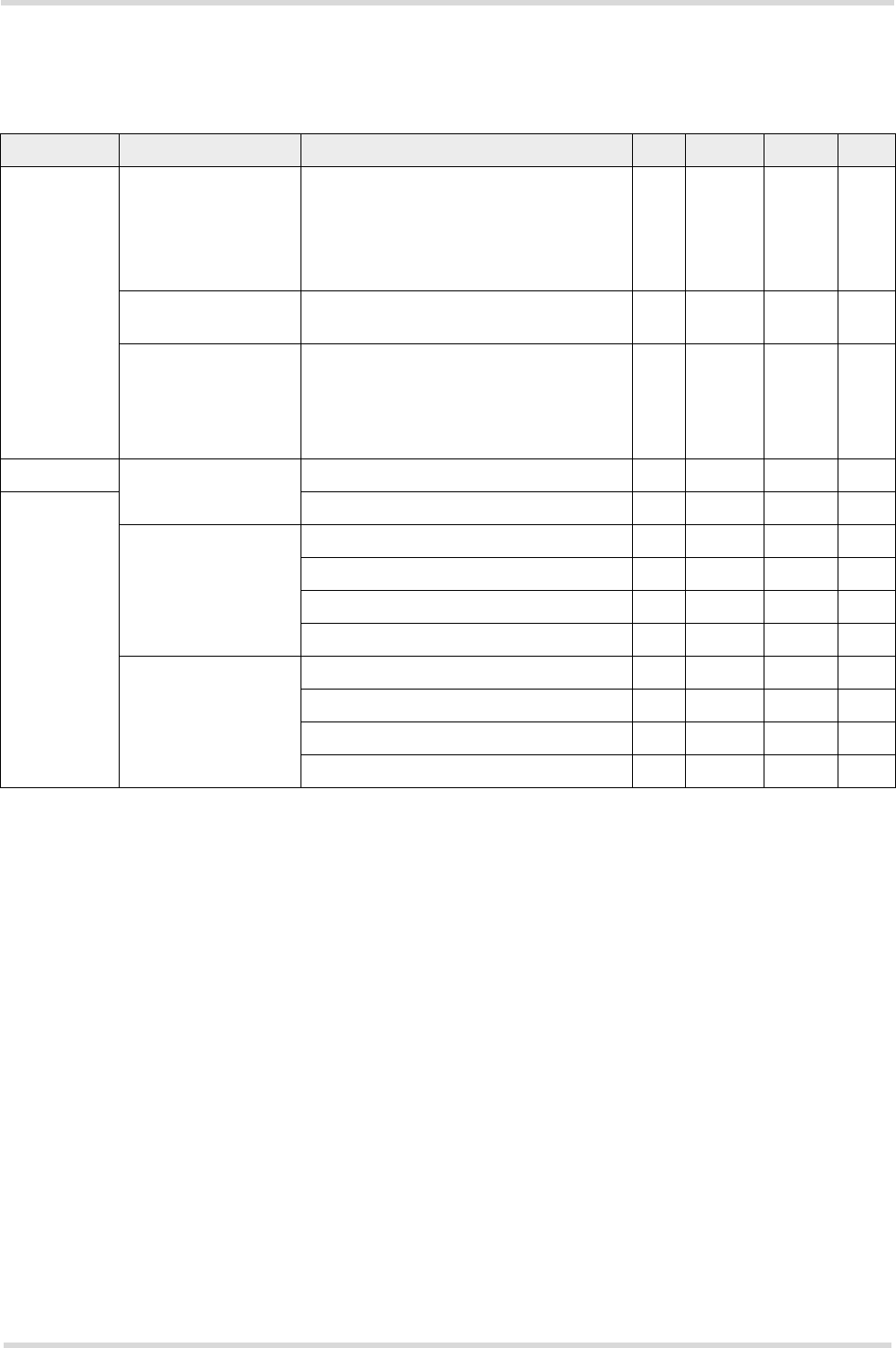
XT65/XT75 Hardware Interface Overview
6.6 Power Supply Ratings s
XT65_XT75_HO_v00.130 Page 43 of 67 2006-10-12
Confidential / Preliminary
6.6 Power Supply Ratings
Table 18: Power supply ratings
Parameter Description Conditions Min Typ Max Unit
BATT+ Supply voltage Directly measured at reference point TP
BATT+ and TP GND.
Voltage must stay within the min/max
values, including voltage drop, ripple,
spikes.
3.3 3.8 4.5 V
Voltage drop during
transmit burst
Normal condition, power control level
for Pout max
400 mV
Voltage ripple Normal condition, power control level
for Pout max
@ f<200kHz
@ f>200kHz
50
2
mV
mV
IVDDLP OFF State supply
current
RTC Backup @ BATT+ = 0V 40 µA
IBATT+ POWER DOWN mode1
1. Measured after module INIT (switch ON the module and following switch OFF); applied voltage on BATT+ (w/o
INIT) show increased POWER DOWN supply current.
60 120 µA
Average standby
supply current2
(GPS off)
2. Additional conditions:
- SLEEP and IDLE mode measurements started 5 minutes after switching ON the module or after mode transition
- Averaging times: SLEEP mode - 3 minutes; IDLE mode - 1.5 minutes
- Communication tester settings: no neighbor cells, no cell reselection
- USB interface disabled
SLEEP mode @ DRX = 9 3.73
3. Stated value applies to operation without autobauding (AT+IPR≠0).
mA
SLEEP mode @ DRX = 5 4.63mA
SLEEP mode @ DRX = 2 7.03mA
IDLE mode @ DRX = 2 284
4. Stated value applies to operation without autobauding (AT+IPR≠0). If autobauding is enabled (AT+IPR=0) aver-
age current consumption in IDLE mode is up to 43mA.
mA
Average supply cur-
rent for GPS part
(GSM in IDLE
mode, w/o active
GPS antenna)
Satellite acquisition (no position found) 68 mA
Tracking mode5
5. 1 fix/s, tracking on 6 channels, depends on FXN configuration settings
70 mA
Sleep state 32 mA
Shut down mode 28 mA
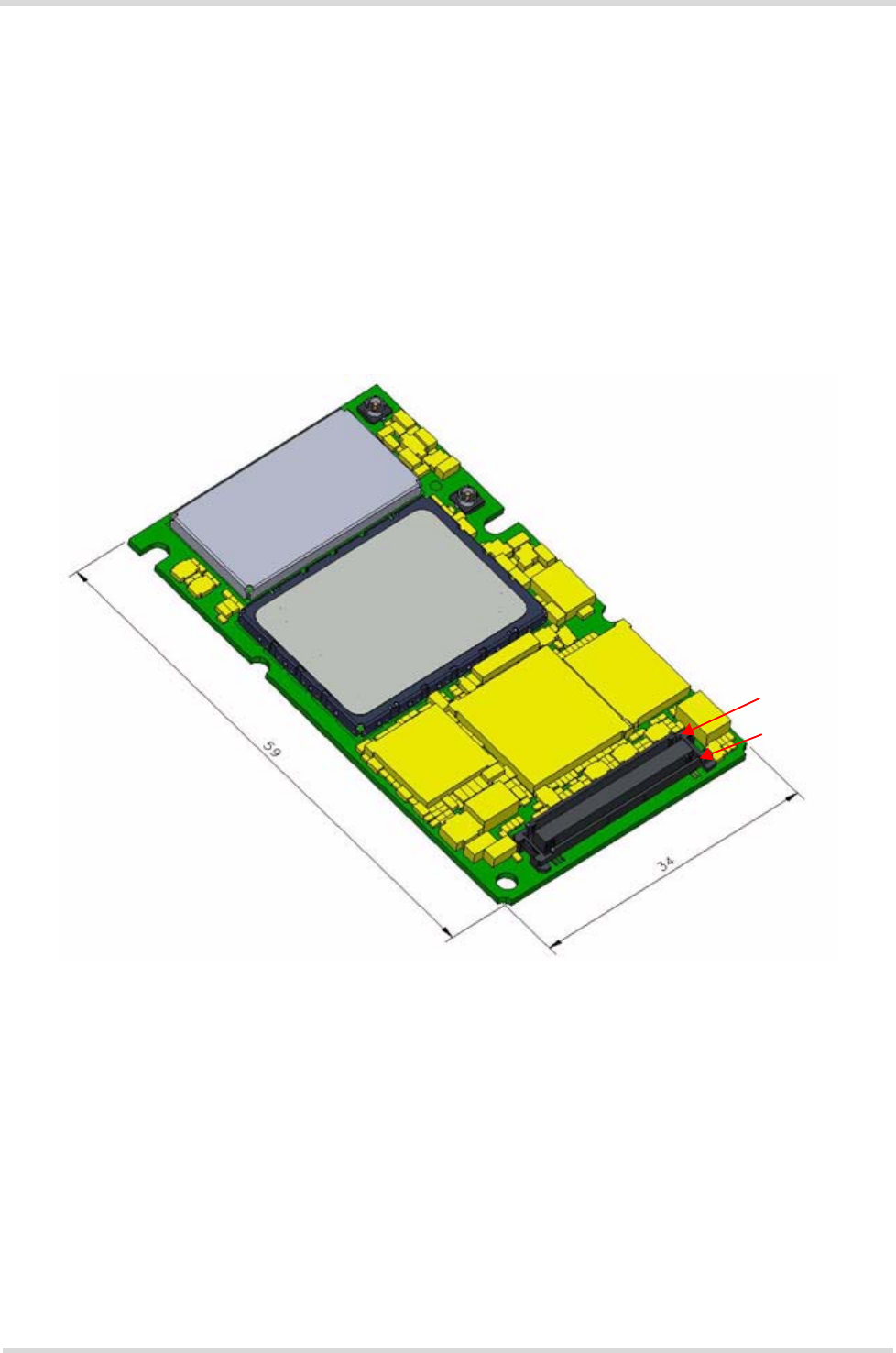
XT65/XT75 Hardware Interface Overview
7 Mechanics s
XT65_XT75_HO_v00.130 Page 44 of 67 2006-10-12
Confidential / Preliminary
7 Mechanics
7.1 Mechanical Dimensions of XT65/XT75
Figure 11 shows the top view of XT65/XT75 and provides an overview of the board's mechanical dimensions.
For further details see Figure 12.
Length: 55.00mm
Width: 33.90mm
Height: 3.15mm
Figure 11: XT65/XT75– top view
Pin1
Pin80
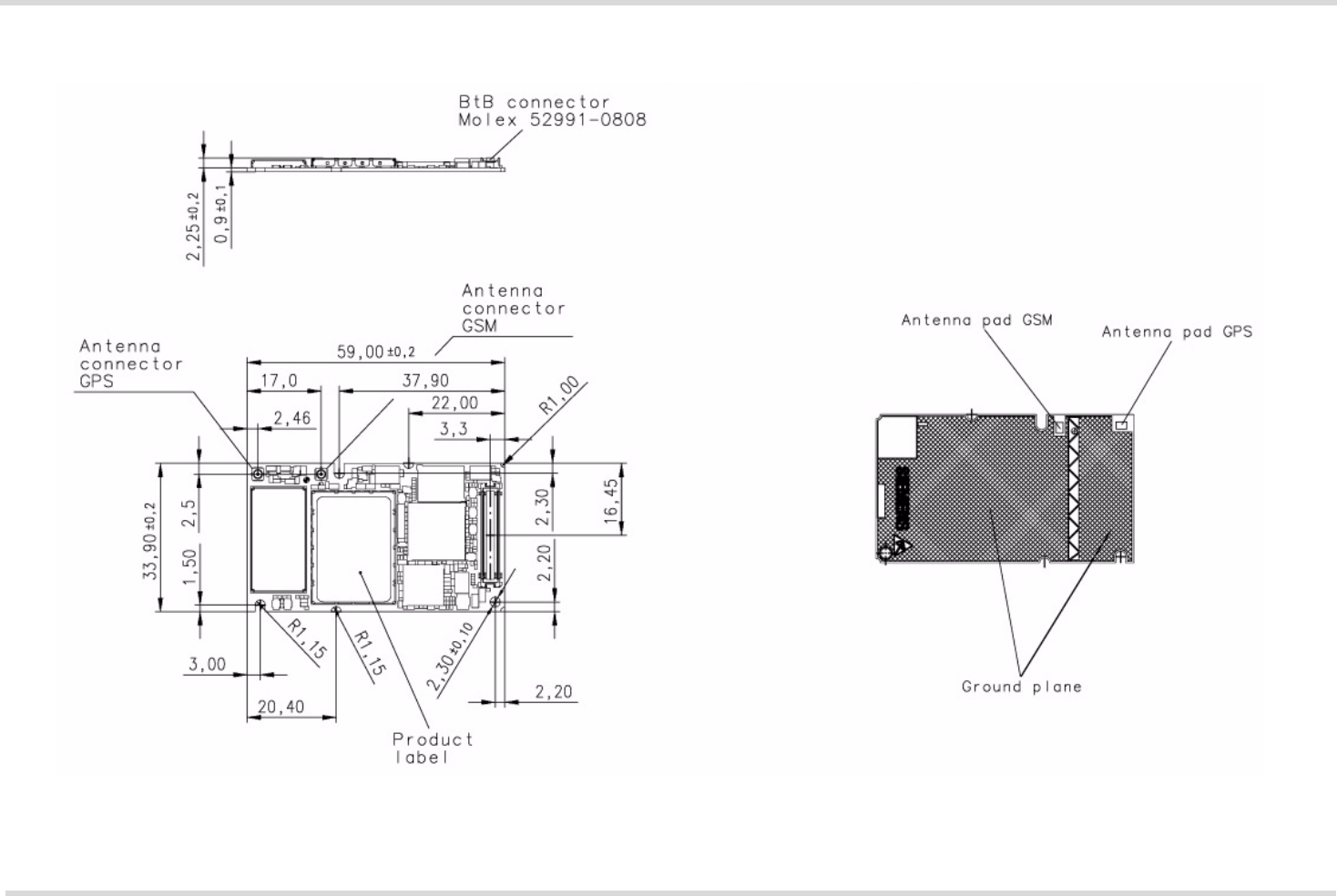
XT65/XT75 Hardware Interface Overview
7.1 Mechanical Dimensions of XT65/XT75 s
XT65_XT75_HO_v00.130 Page 45 of 67 2006-10-12
Confidential / Preliminary
Figure 12: Dimensions of XT65/XT75 (all dimensions in mm)

XT65/XT75 Hardware Interface Overview
7.2 Mounting XT65/XT75 to the Application Platform s
XT65_XT75_HO_v00.130 Page 46 of 67 2006-10-12
Confidential / Preliminary
7.2 Mounting XT65/XT75 to the Application Platform
There are many ways to properly install XT65/XT75 in the host device. An efficient approach is to mount the
XT65/XT75 PCB to a frame, plate, rack or chassis.
Fasteners can be M2 screws plus suitable washers, circuit board spacers, or customized screws, clamps, or
brackets. In addition, the board-to-board connection can also be utilized to achieve better support. To help you
find appropriate spacers a list of selected screws and distance sleeves for 3mm stacking height can be found in
Section 9.2.
When using the two small holes take care that the screws are inserted with the screw head on the bottom of the
XT65/XT75 PCB. Screws for the large holes can be inserted from top or bottom.
For proper grounding it is strongly recommended to use large ground plane on the bottom of board in addition to
the five GND pins of the board-to-board connector. The ground plane may also be used to attach cooling ele-
ments, e.g. a heat sink or thermally conductive tape. Please take care that attached cooling elements do not
touch the antenna pads on the module’s bottom side, as this may lead a short-circuit.
To prevent mechanical damage, be careful not to force, bend or twist the module. Be sure it is positioned flat
against the host device.
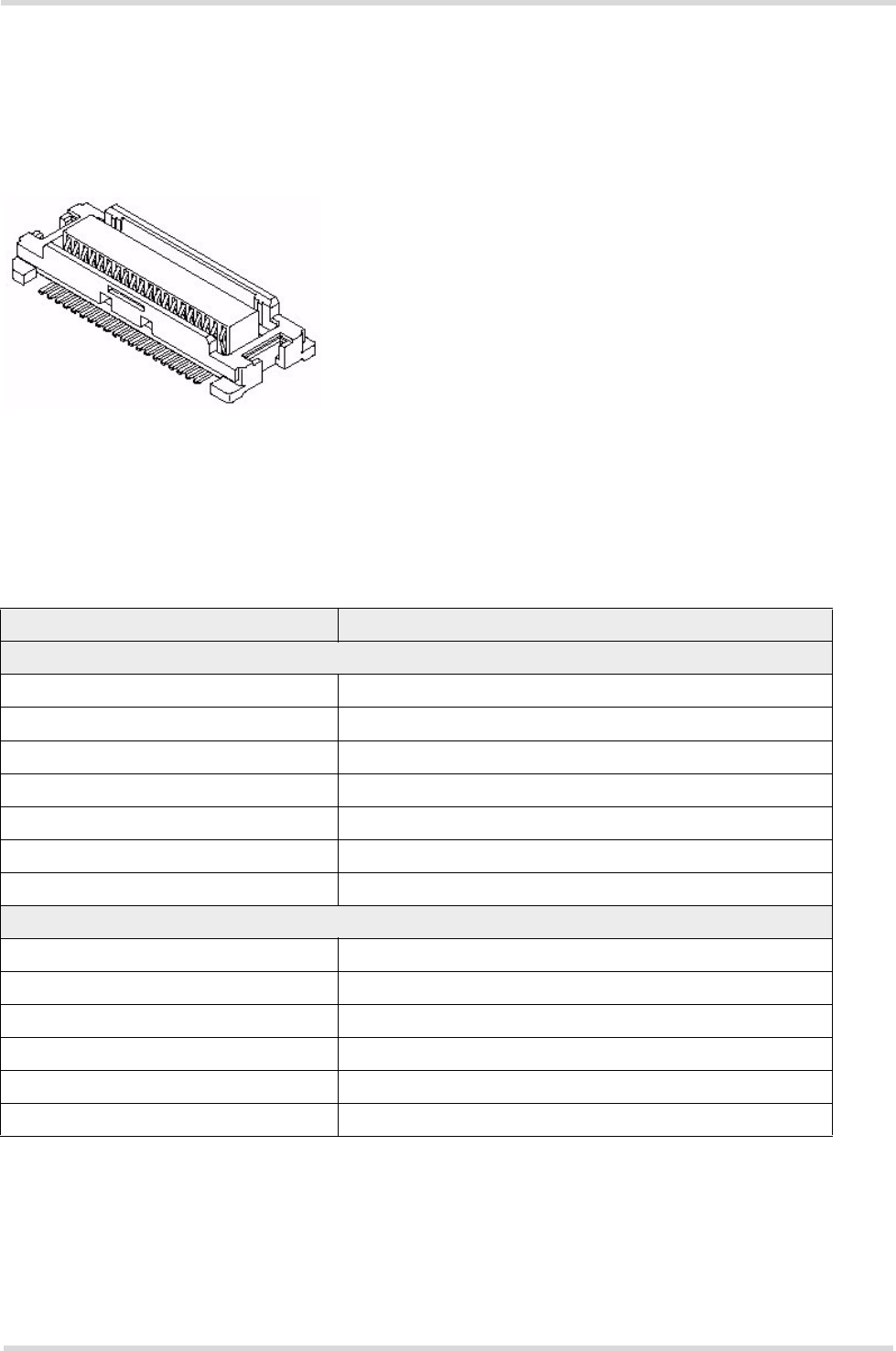
XT65/XT75 Hardware Interface Overview
7.3 Board-to-Board Application Connector s
XT65_XT75_HO_v00.130 Page 47 of 67 2006-10-12
Confidential / Preliminary
7.3 Board-to-Board Application Connector
This section provides the specifications of the 80-pin board-to-board connector used to connect XT65/XT75 to
the external application.
Connector mounted on the XT65/XT75 module:
Type: 52991-0808 SlimStack Receptacle 80 pins, 0.50mm pitch, for stacking heights from 3.0 to 4.0mm,
see Figure 14 for details.
Supplier: Molex, http//www.molex.com
Table 19: Technical specifications of Molex board-to-board connector
Parameter Specification (80-pin B2B connector)
Electrical
Number of Contacts 80
Contact spacing 0.5mm (.020")
Voltage 50V
Rated current 0.5A max per contact
Contact resistance 50mΩ max per contact
Insulation resistance > 100MΩ
Dielectric Withstanding Voltage 500V AC (for 1 minute)
Physical
Insulator material (housing) White glass-filled LCP plastic, flammability UL 94V 0
Contact material Plating: Gold over nickel
Insertion force 1st < 74.4N
Insertion force 30th < 65.6N
Withdrawal force 1st > 10.8N
Maximum connection cycles 30 (@ 70mΩ max per contact)
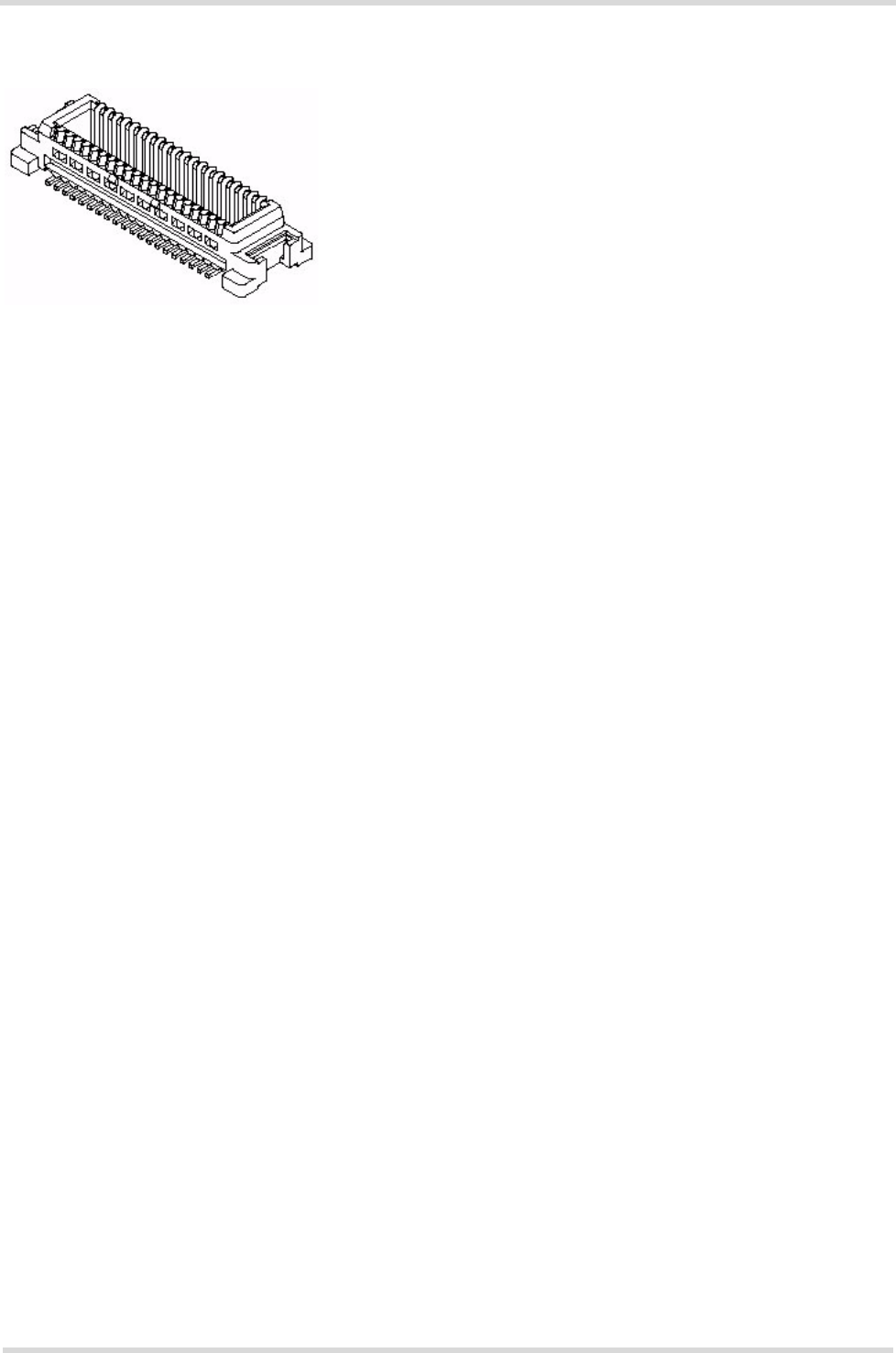
XT65/XT75 Hardware Interface Overview
7.3 Board-to-Board Application Connector s
XT65_XT75_HO_v00.130 Page 48 of 67 2006-10-12
Confidential / Preliminary
Mating connector types for the customer's application offered by Molex:
Figure 13: Mating board-to-board connector 53748-0808 on application
• 53748-0808 SlimStack Plug, 3mm stacking height,
see Figure 15 for details.
• 53916-0808 SlimStack Plug, 4mm stacking height
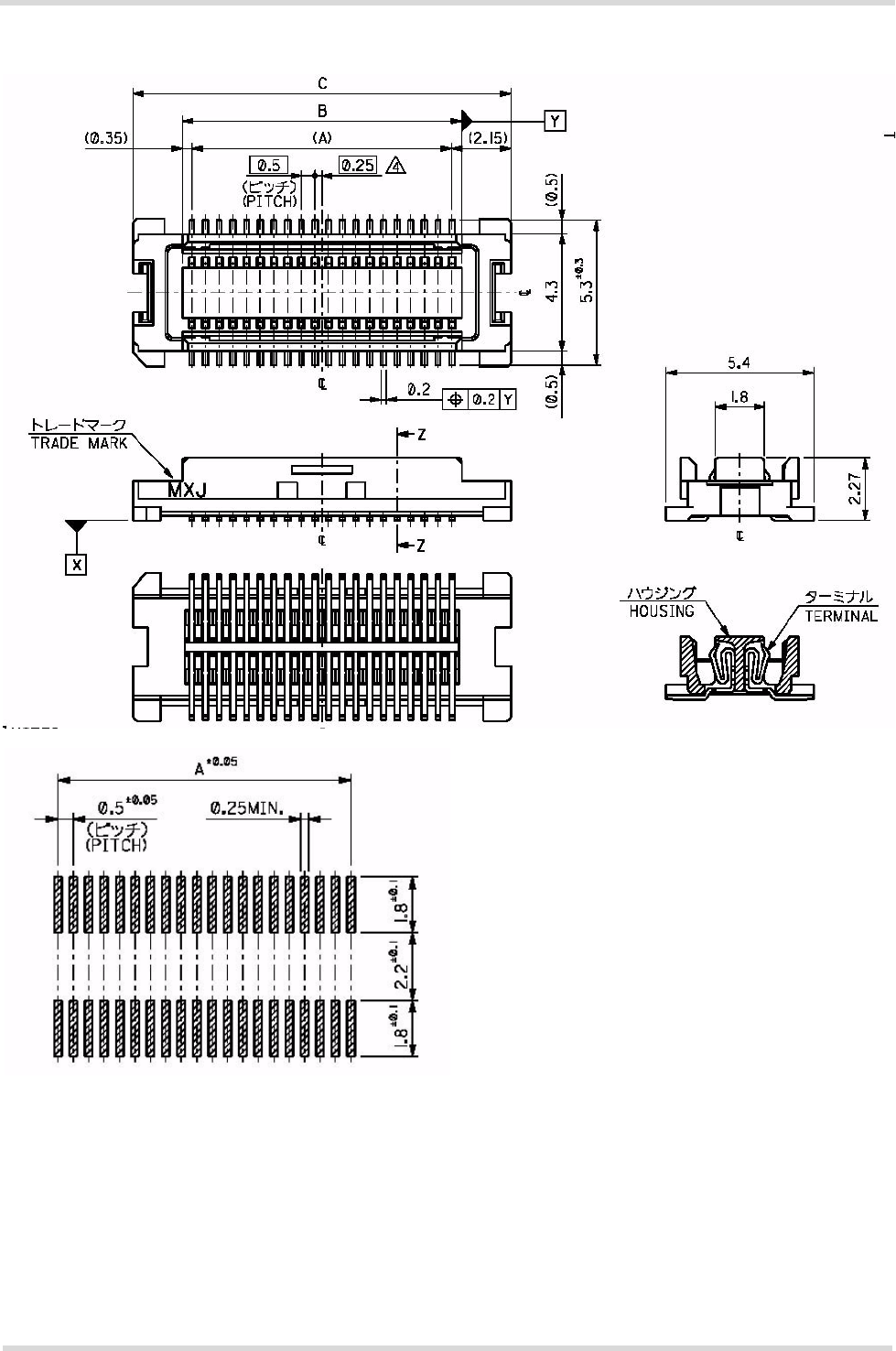
XT65/XT75 Hardware Interface Overview
7.3 Board-to-Board Application Connector s
XT65_XT75_HO_v00.130 Page 49 of 67 2006-10-12
Confidential / Preliminary
Figure 14: Molex board-to-board connector 52991-0808 on XT65/XT75
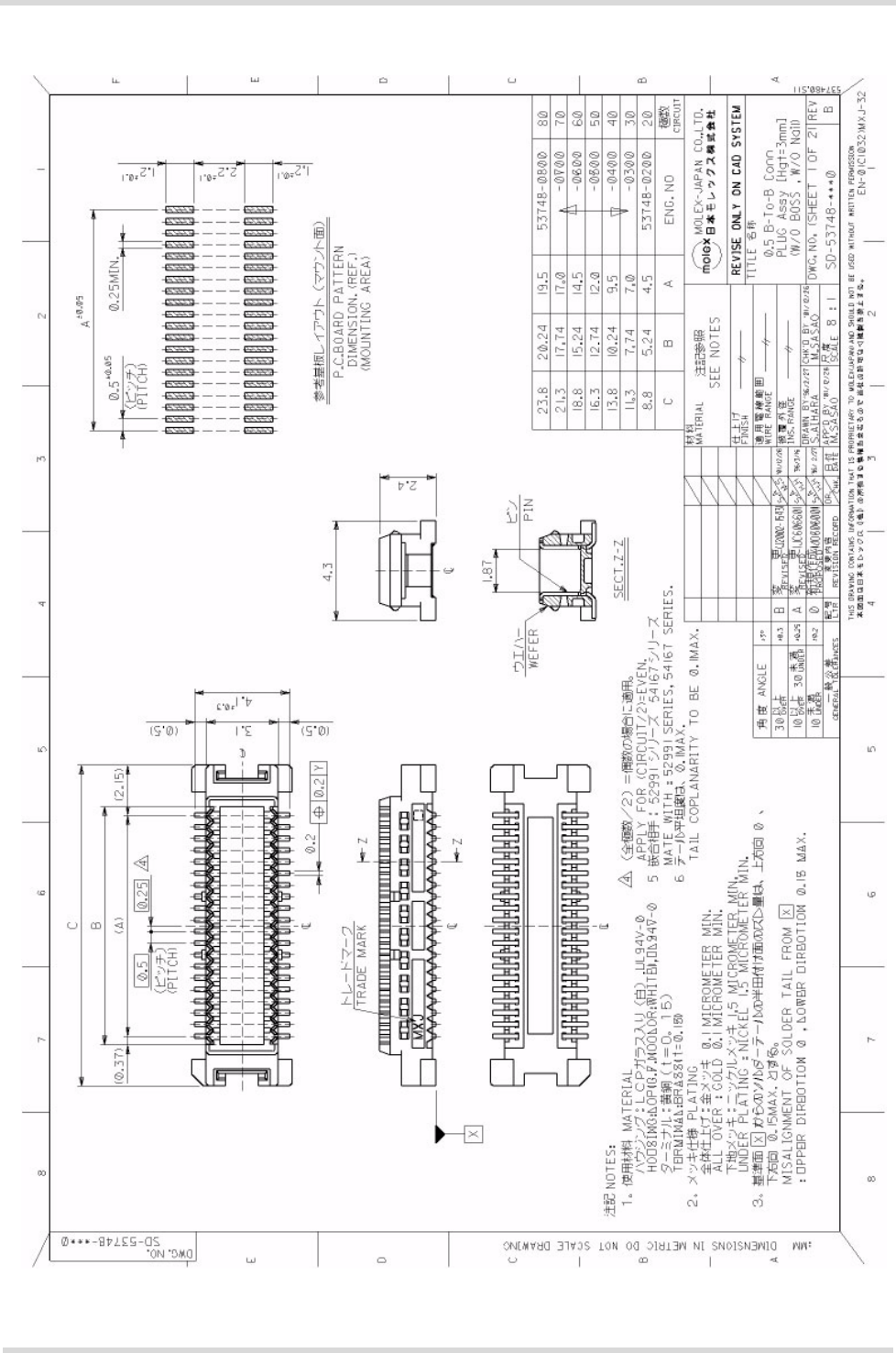
XT65/XT75 Hardware Interface Overview
7.3 Board-to-Board Application Connector s
XT65_XT75_HO_v00.130 Page 50 of 67 2006-10-12
Confidential / Preliminary
Figure 15: Mating board-to-board connector 53748-0808 on application
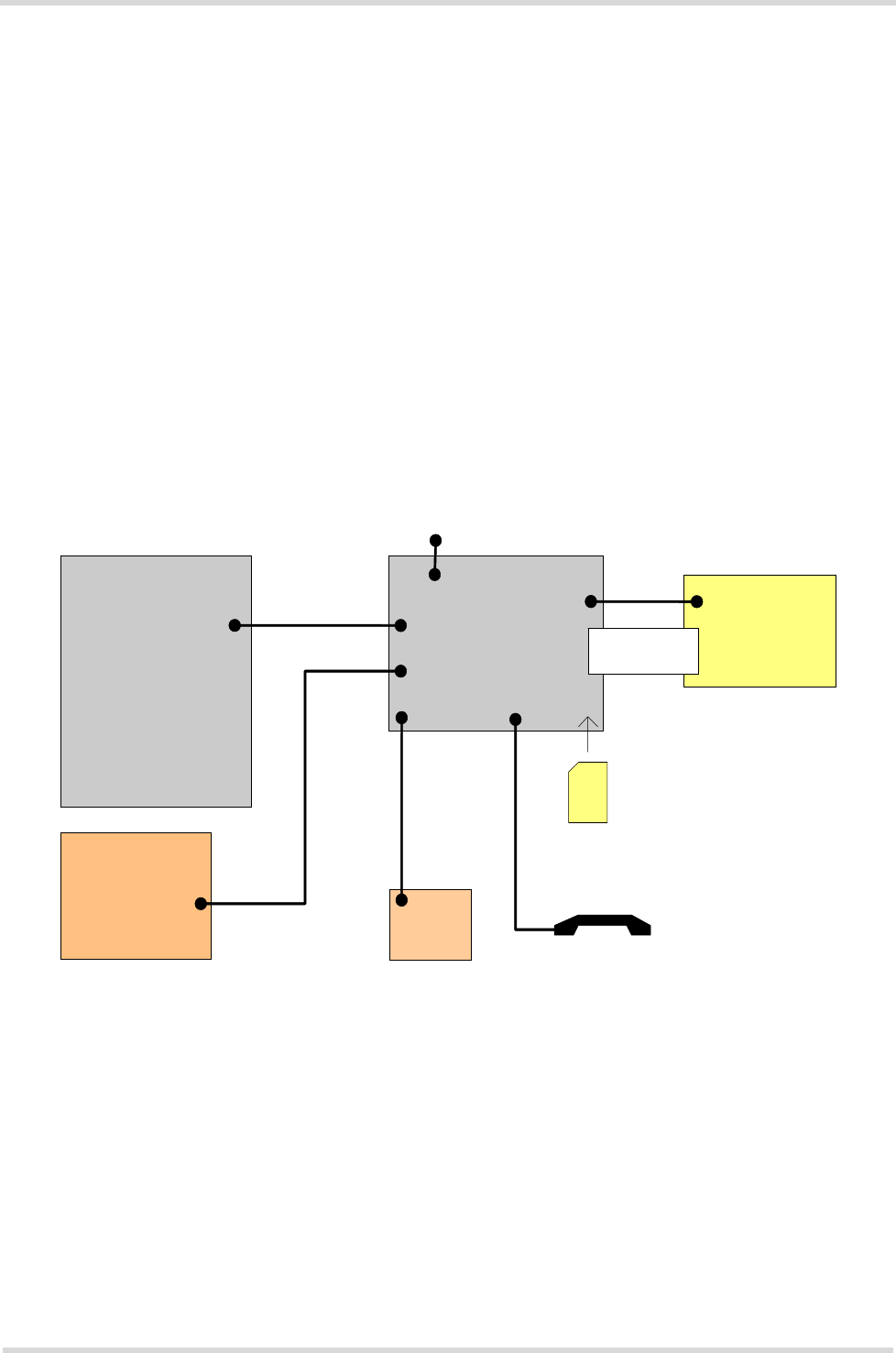
XT65/XT75 Hardware Interface Overview
8 Reference Approval s
XT65_XT75_HO_v00.130 Page 51 of 67 2006-10-12
Confidential / Preliminary
8 Reference Approval
8.1 Reference Equipment for Type Approval
The Siemens reference setup submitted to type approve XT65/XT75 consists of the following components:
• Siemens XT65/XT75 cellular engine
• Development Support Box DSB75
• SIM card reader integrated on DSB75
• U.FL-R-SMT antenna connector and U.FL-LP antenna cable
• Handset type Votronic HH-SI-30.3/V1.1/0
• Li-Ion battery
• PC as MMI
Figure 16: Reference equipment for Type Approval
PC
Power supply
SIM
RS-232
DSB75
Handset
Li-Ion
battery
GSM module
Flex cable
100mm
Antenna or 50
Ω
cable to system
simulator
Antenna

XT65/XT75 Hardware Interface Overview
8.2 Compliance with FCC Rules and Regulations s
XT65_XT75_HO_v00.130 Page 52 of 67 2006-10-12
Confidential / Preliminary
8.2 Compliance with FCC Rules and Regulations
The Equipment Authorization Certification for the Siemens reference application described in Section 8.1 will be
registered under the following identifiers:
FCC Identifier: QIPXT65
Industry Canada Certification Number: 267W-XT65
Granted to Siemens AG
FCC Identifier QIPXT75
Industry Canada Certification Number: 267W-XT75
Granted to Siemens AG
Manufacturers of mobile or fixed devices incorporating XT65/XT75 modules are authorized to use the FCC
Grants and Industry Canada Certificates of the XT65/XT75 modules for their own final products according to the
conditions referenced in these documents. In this case, the FCC label of the module shall be visible from the
outside, or the host device shall bear a second label stating "Contains FCC ID QIP XT65" resp. "Contains FCC
ID QIP XT75".
IMPORTANT:
Manufacturers of portable applications incorporating XT65/XT75 modules are required to have their final product
certified and apply for their own FCC Grant and Industry Canada Certificate related to the specific portable
mobile. This is mandatory to meet the SAR requirements for portable mobiles (see Section 1.3.2 for detail).
Changes or modifications not expressly approved by the party responsible for compliance could void the user's
authority to operate the equipment.
If the final product is not approved for use in U.S. territories the application manufacturer shall take care that the
850 MHz and 1900 MHz frequency bands be deactivated and that band settings be inaccessible to end users. If
these demands are not met (e.g. if the AT interface is accessible to end users), it is the responsibility of the appli-
cation manufacturer to always ensure that the application be FCC approved regardless of the country it is mar-
keted in. The frequency bands can be set using the command
AT^SCFG="Radio/Band"[,<rbp>][, <rba>].
A detailed command description can be found in [1].
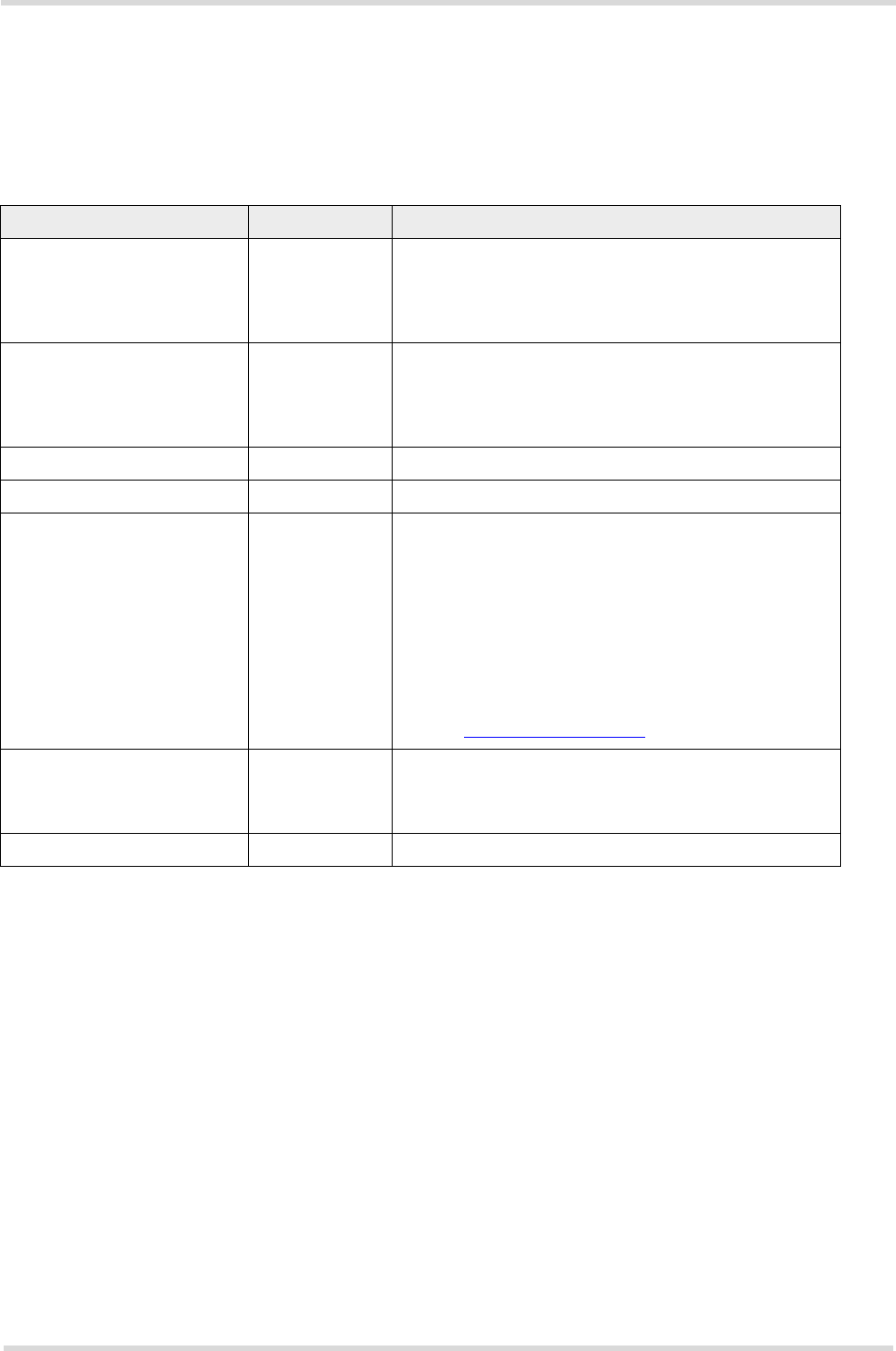
XT65/XT75 Hardware Interface Overview
9 Appendix s
XT65_XT75_HO_v00.130 Page 53 of 67 2006-10-12
Confidential / Preliminary
9Appendix
9.1 List of Parts and Accessories
Table 20: List of parts and accessories
Description Supplier Ordering information
XT65 Siemens Standard module (Siemens IMEI)
Siemens ordering number: L36880-N8835-A100
Customer IMEI mode:
Siemens Ordering number: L36880-N8836-A100
XT75 Siemens Standard module (Siemens IMEI)
Siemens ordering number: L36880-N8830-A100
Customer IMEI mode:
Siemens Ordering number: L36880-N8831-A100
Siemens Car Kit Portable Siemens Siemens ordering number: L36880-N3015-A117
DSB75 Support Box Siemens Siemens ordering number: L36880-N8811-A100
Votronic Handset VOTRONIC Votronic HH-SI-30.3/V1.1/0
VOTRONIC
Entwicklungs- und Produktionsgesellschaft für elek-
tronische Geräte mbH
Saarbrücker Str. 8
66386 St. Ingbert
Germany
Phone: +49-(0)6 89 4 / 92 55-0
Fax: +49-(0)6 89 4 / 92 55-88
e-mail: contact@votronic.com
SIM card holder incl. push
button ejector and slide-in
tray
Molex Ordering numbers: 91228
91236
Sales contacts are listed in Table 21.
Board-to-board connector Molex Sales contacts are listed in Table 21.
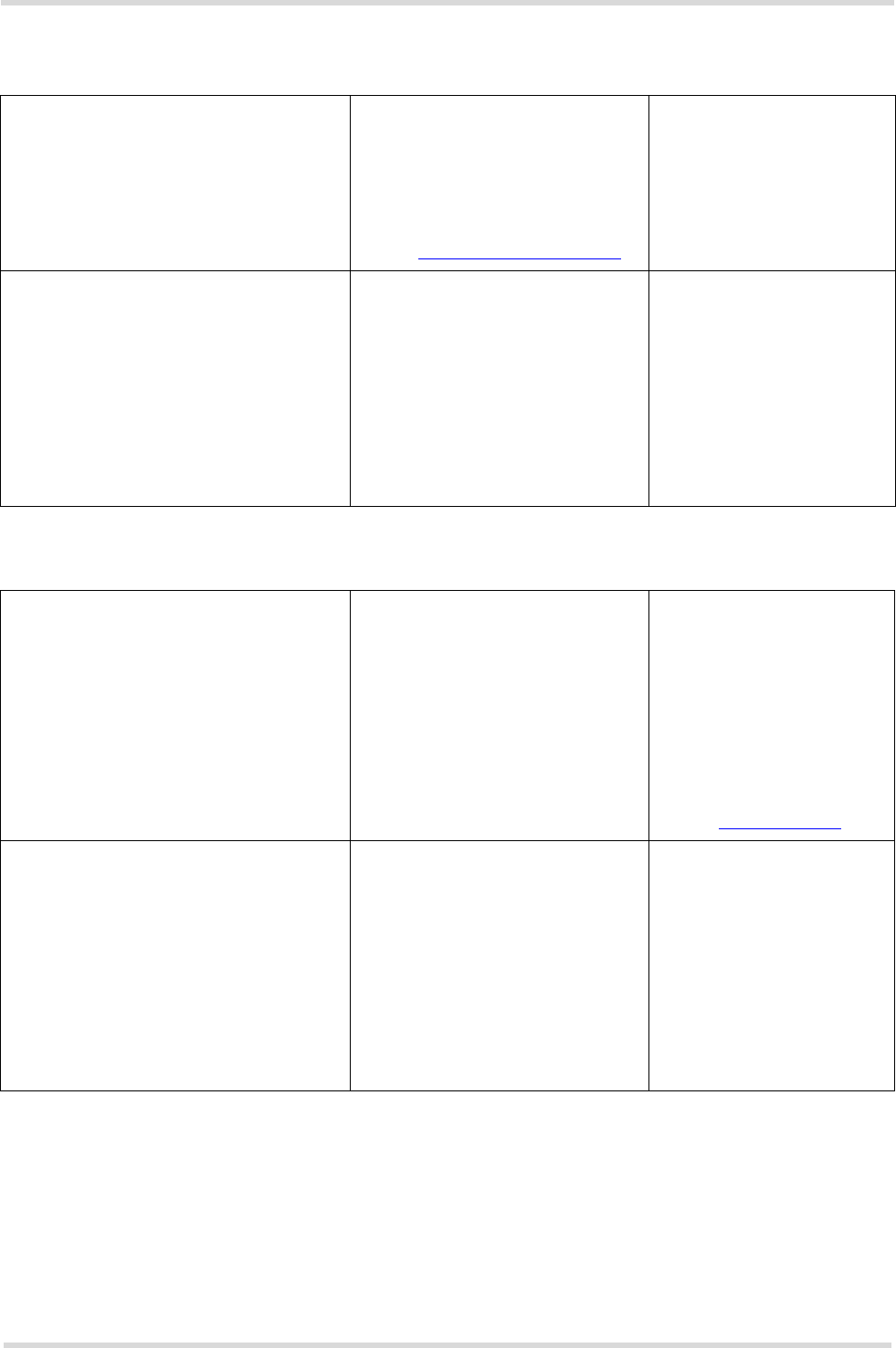
XT65/XT75 Hardware Interface Overview
9.1 List of Parts and Accessories s
XT65_XT75_HO_v00.130 Page 54 of 67 2006-10-12
Confidential / Preliminary
Table 21: Molex sales contacts (subject to change)
Molex
For further information please click:
http://www.molex.com
Molex Deutschland GmbH
Felix-Wankel-Str. 11
4078 Heilbronn-Biberach
Germany
Phone: +49-7066-9555 0
Fax: +49-7066-9555 29
Email: mxgermany@molex.com
American Headquarters
Lisle, Illinois 60532
U.S.A.
Phone: +1-800-78MOLEX
Fax: +1-630-969-1352
Molex China Distributors
Beijing,
Room 1319, Tower B, COFCO Plaza
No. 8, Jian Guo Men Nei Street, 100005
Beijing
P.R. China
Phone: +86-10-6526-9628
Phone: +86-10-6526-9728
Phone: +86-10-6526-9731
Fax: +86-10-6526-9730
Molex Singapore Pte. Ltd.
Jurong, Singapore
Phone: +65-268-6868
Fax: +65-265-6044
Molex Japan Co. Ltd.
Yamato, Kanagawa, Japan
Phone: +81-462-65-2324
Fax: +81-462-65-2366
Table 22: Hirose sales contacts (subject to change)
Hirose Ltd.
For further information please click:
http://www.hirose.com
Hirose Electric (U.S.A.) Inc
2688 Westhills Court
Simi Valley, CA 93065
U.S.A.
Phone: +1-805-522-7958
Fax: +1-805-522-3217
Hirose Electric GmbH
Zeppelinstrasse 42
73760 Ostfildern
Kemnat 4
Germany
Phone: +49-711-4560-021
Fax +49-711-4560-729
E-mail info@hirose.de
Hirose Electric UK, Ltd
Crownhill Business Centre
22 Vincent Avenue, Crownhill
Milton Keynes, MK8 OAB
Great Britain
Phone: +44-1908-305400
Fax: +44-1908-305401
Hirose Electric Co., Ltd.
5-23, Osaki 5 Chome,
Shinagawa-Ku
Tokyo 141
Japan
Phone: +81-03-3491-9741
Fax: +81-03-3493-2933
Hirose Electric Co., Ltd.
European Branch
First class Building 4F
Beechavenue 46
1119PV Schiphol-Rijk
Netherlands
Phone: +31-20-6557-460
Fax: +31-20-6557-469
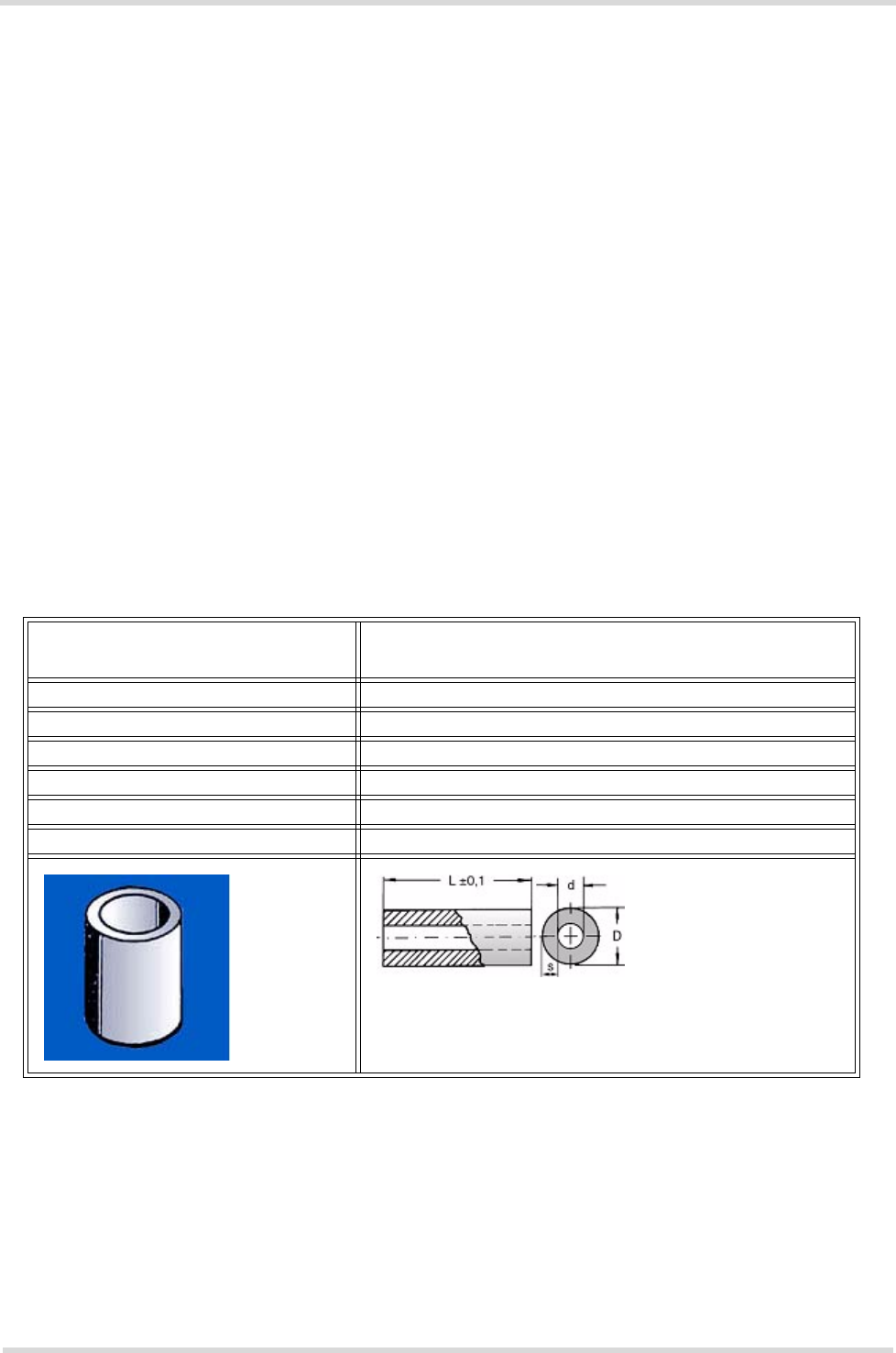
XT65/XT75 Hardware Interface Overview
9.2 Fasteners and Fixings for Electronic Equipment s
XT65_XT75_HO_v00.130 Page 55 of 67 2006-10-12
Confidential / Preliminary
9.2 Fasteners and Fixings for Electronic Equipment
This section provides a list of suppliers and manufacturers offering fasteners and fixings for electronic equipment
and PCB mounting. The content of this section is designed to offer basic guidance to various mounting solutions
with no warranty on the accuracy and sufficiency of the information supplied. Please note that the list remains
preliminary although it is going to be updated in later versions of this document.
9.2.1 Fasteners from German Supplier ETTINGER GmbH
Sales contact:
ETTINGER GmbH
http://www.ettinger.de/main.cfm
Phone: +4981 04 66 23 – 0
Fax: +4981 04 66 23 – 0
The following tables contain only article numbers and basic parameters of the listed components. For further
detail and ordering information please contact Ettinger GmbH.
Please note that some of the listed screws, spacers and nuts are delivered with the DSB75 Support Board. See
comments below.
Article number: 05.71.038 Spacer - Aluminum /
Wall thickness = 0.8mm
Length 3.0mm
Material AlMgSi-0,5
For internal diameter M2=2.0-2.3
Internal diameter d = 2.4mm
External diameter 4.0mm
Vogt AG No. x40030080.10
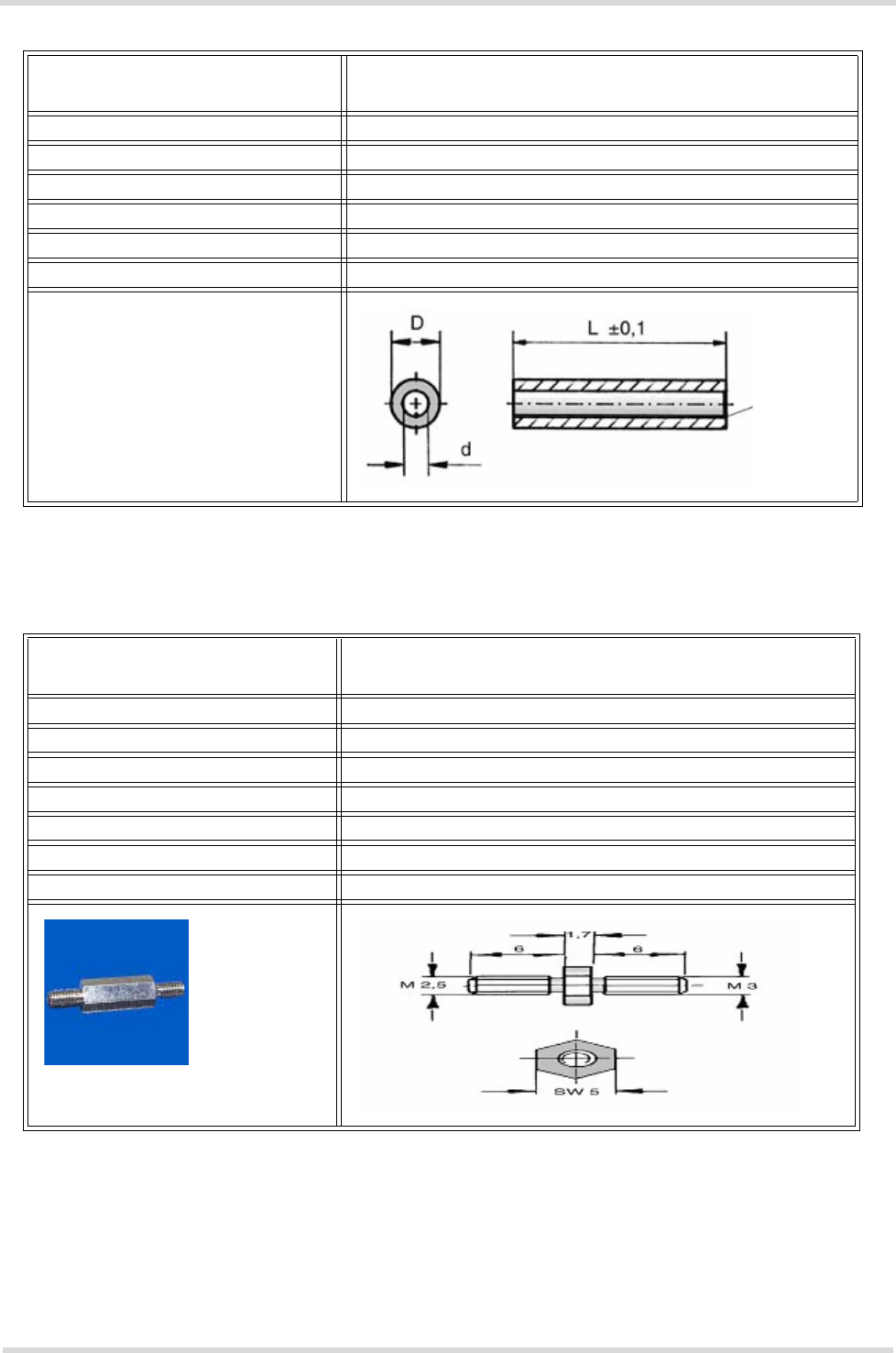
XT65/XT75 Hardware Interface Overview
9.2 Fasteners and Fixings for Electronic Equipment s
XT65_XT75_HO_v00.130 Page 56 of 67 2006-10-12
Confidential / Preliminary
Article number: 07.51.403 Insulating Spacer for M2
Self-gripping1
Length 3.0mm
Material Polyamide 6.6
Surface Black
Internal diameter 2.2mm
External diameter 4.0mm
Flammability rating UL94-HB
1. 2 spacers are delivered with DSB75 Support Board
Article number: 05.11.209 Threaded Stud M2.5 - M2 Type E /
External thread at both ends
Length 3.0mm
Material Stainless steel X12CrMoS17
Thread 1 / Length M2.5 / 6.0mm
Thread 2 / Length M2 / 8.0mm
Width across flats 5
Recess yes
Type External / External
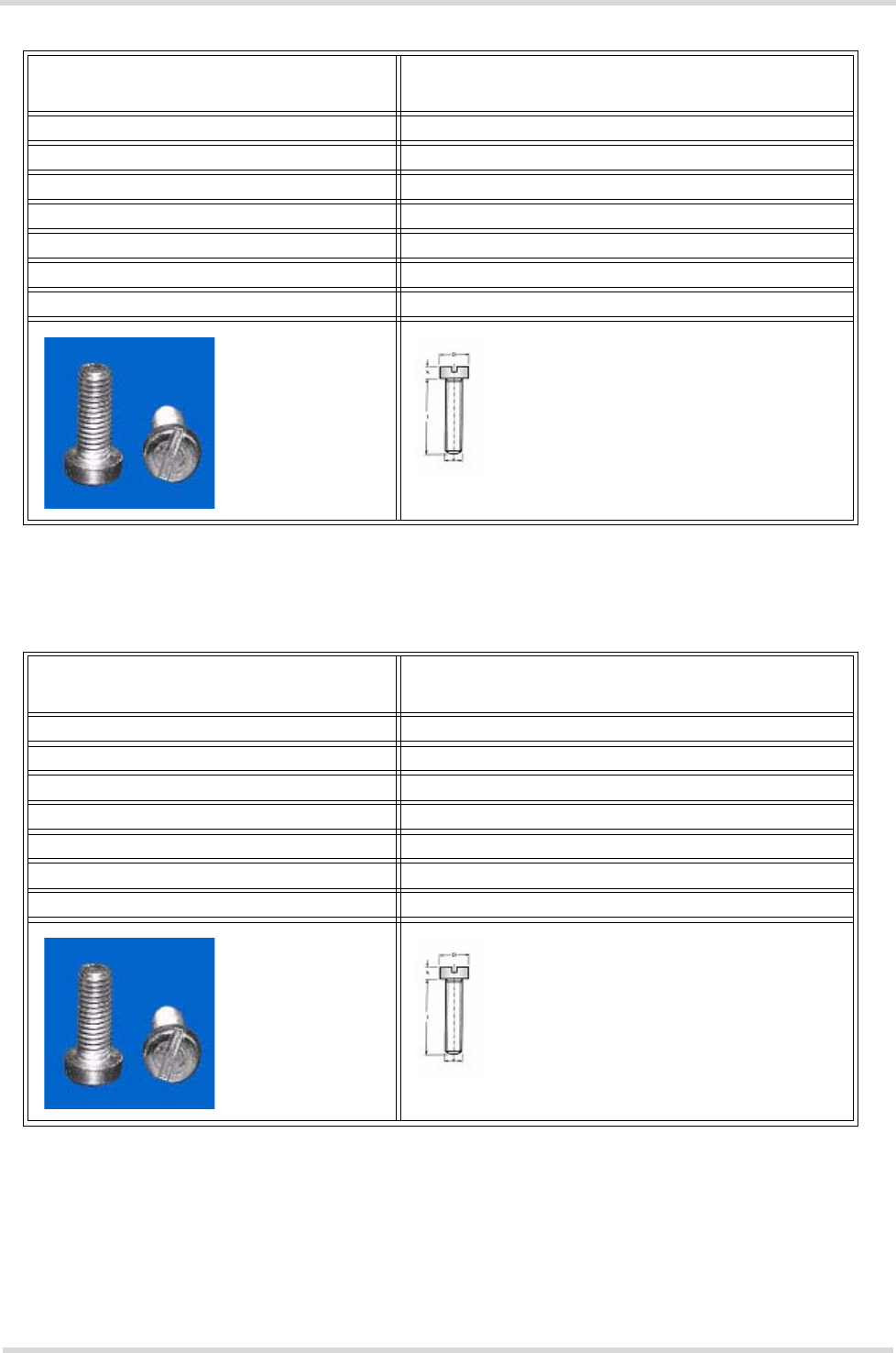
XT65/XT75 Hardware Interface Overview
9.2 Fasteners and Fixings for Electronic Equipment s
XT65_XT75_HO_v00.130 Page 57 of 67 2006-10-12
Confidential / Preliminary
Article number: 01.14.131 Screw M21
DIN 84 - ISO 1207
Length 8.0mm
Material Steel 4.8
Surface Zinced A2K
Thread M2
Head diameter D = 3.8mm
Head height 1.30mm
Type Slotted cheese head screw
1. 2 screws are delivered with DSB75 Support Board
Article number: 01.14.141 Screw M2
DIN 84 - ISO 1207
Length 10.0mm
Material Steel 4.8
Surface Zinced A2K
Thread M2
Head diameter D = 3.8mm
Head height 1.30mm
Type Slotted cheese head screw
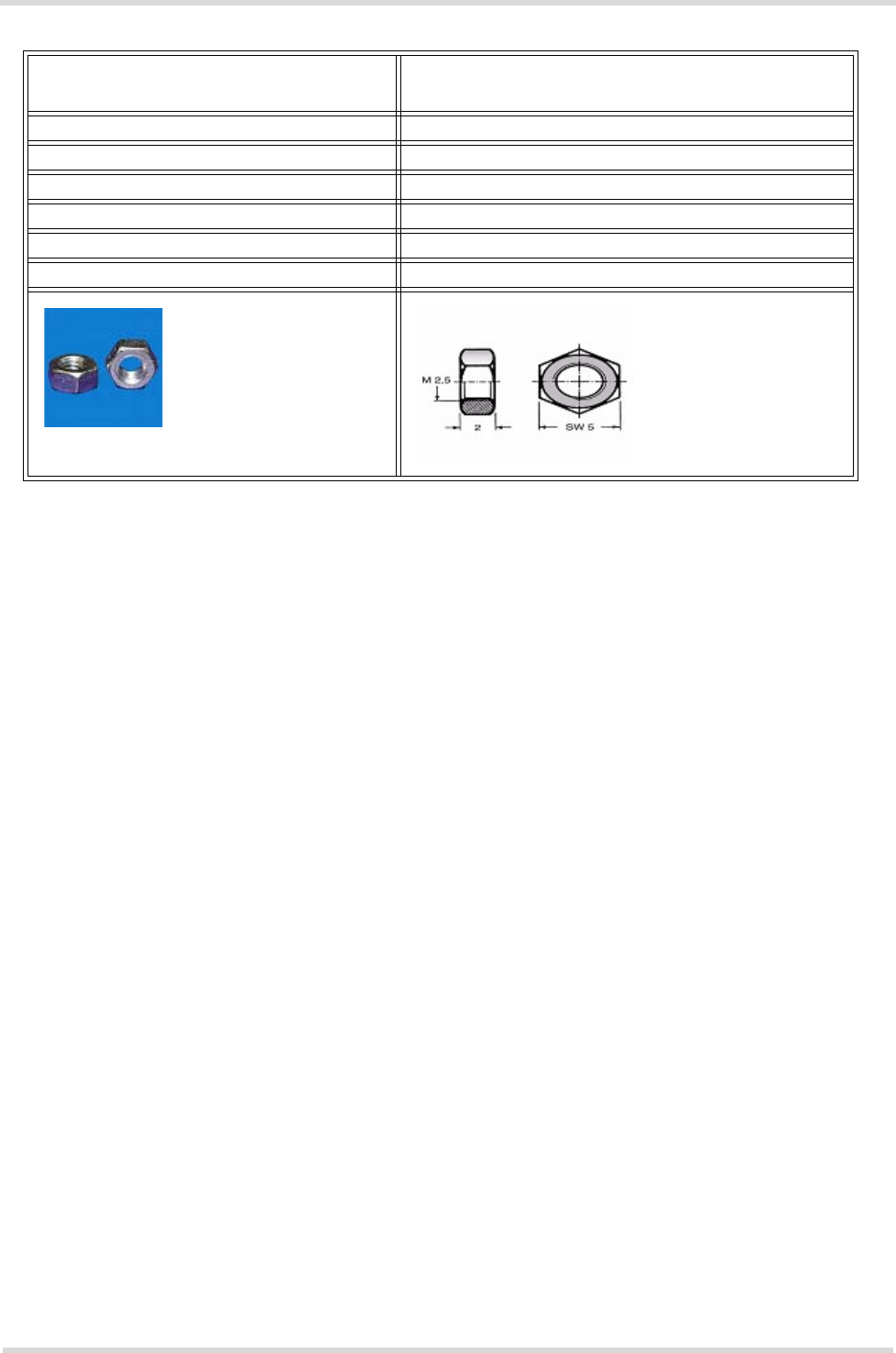
XT65/XT75 Hardware Interface Overview
9.2 Fasteners and Fixings for Electronic Equipment s
XT65_XT75_HO_v00.130 Page 58 of 67 2006-10-12
Confidential / Preliminary
Article number: 02.10.011 Hexagon Nut1
DIN 934 - ISO 4032
Material Steel 4.8
Surface Zinced A2K
Thread M2
Wrench size / ;4
Thickness / L 1.6mm
Type Nut DIN/UNC, DIN934
1. 2 nuts are delivered with DSB75 Support Board